Small Beetle With Two Yellow Stripes on Back Red Head

| Home | Who We Are | List of Orders | References | Contact Us |
*** Note: KnowYourInsects.org does its best to include correct identifications of insect photos. It's always possible that we made a mistake, however, so if you see a misidentification, please contact us and we will correct it. Thanks! Order Coleoptera: the beetles — Examples
Families represented on this website:
| Anobiidae | Anthicidae | Anthribidae | Attelabidae | Brachypsectridae | Brentidae | Buprestidae | Callirhipidae |
| Cantharidae | Carabidae | Cerambycidae | Cleridae | Chrysomelidae | Coccinellidae | Cucujidae | Curculionidae |
| Dermestidae | Dytiscidae | Elateridae | Glaphyridae | Histeridae | Hydrophilidae | Lampyridae | Lucanidae |
| Lycidae | Lymexylidae | Meloidae | Melyridae | Mordellidae | Nitidulidae | Oedemeridae | Passalidae |
| Phengodidae | Ptinidae | Scarabaeidae | Silphidae | Silvanidae | Staphylinidae | Tenebrionidae | Trogossitidae | Zopheridae |
Chrysomelidae, the leaf beetles
 Swamp milkweed leaf beetle, Labidomera clivicollis, subfamily Chrysomelinae, family Chrysomelidae. □ The color and pattern of the swamp milkweed leaf beetle is highly variable. Some are red, some orange, and some are ivory-colored. Black spotting is always present, but the spots may be much more or less extensive in some individuals. Photographed by: Bea Cuthbertson. Identified by: Leslie Mertz. Location: on the border between Hillsdale and Lenawee counties, Michigan, USA. Date: 8 September, 2015. Bea says, "It was roughly 3/8"–1/2" total." | .jpg) Swamp milkweed leaf beetle, Labidomera clivicollis, subfamily Chrysomelinae, family Chrysomelidae. □ These three photos show some of the wide variation among swamp milkweed leaf beetles, also known simply as milkweed leaf beetles. All have a black thorax and head. Photographed and identified by: Celia Godwin. Location: eastern Ontario, Canada. Date: 12 June, 2021. Celia says, "I'm having fun raising monarch caterpillars.... (I)n the process of looking for them, I also found milkweed leaf beetles." |
 Leaf beetle, Zygogramma heterothecae, subfamily Chrysomelinae, family Chrysomelidae. □ This leaf beetle, which is associated with camphorweed (Heterotheca subaxillaris), looks very similar to the Calligrapha beetles in the next couple of photos. Both have markings that look like calligraphy. Notice that the head and thorax on this Leaf Beetle have a dark, brick-red color, while those of the Calligrapha look either black or deep green. Photographed by: Julie Brown. Identified by: KnowYourInsects.org. Location: Haxtun, Colorado, USA. Date: 18 July, 2017. |  Calligrapha beetle in the genus Calligrapha, quite possibly an Elm Calligrapha, Calligrapha scalaris, subfamily Chrysomelinae, family Chrysomelidae. □ The elm calligrapha has some variety in its markings. Many have the pattern shown here: a long blotch down the middle of the back, a boot-shaped marking at each "shoulder", as well as a variety of smaller spots. Photographed and identified to order by: Jacqulyn Stark. Identified to genus and tentative species by: KnowYourInsects.org. Location: Houston, Texas, USA. Date: 25 February, 2019. Jacqulyn found it on a picnic table in the shade. She says, "I don't know what it is, but it's cute. According to a friend, it's a cow." |  Dogwood calligrapha, also known as a dogwood leaf beetle, Calligrapha philadelphica, subfamily Chrysomelinae, family Chrysomelidae. □ Dogwood calligrapha beetles are often found (unsurprisingly) on dogwood plants, but will also visit nearby willow plants. Sometimes, they will share a dogwood plant with another species of calligrapha beetle called the Common Willow Calligrapha (Calligrapha multipunctata). Photographed and identified to genus by: Emily Day. Identified to species by: Bill Mertz. Thank you, Bill! Location: Pinhoti trail, Alabama, USA. Date: 21 April, 2020. Emily says, "This beetle attached itself to my niece's backpack while hiking on the Pinhoti trail in Alabama. We loved its tribal markings and wanted to know if it was a ladybug. I know from your site that it is a calligraphy beetle." KnowYourInsects.org says, "Glad you found it!" |  Dogwood calligrapha, also known as a dogwood leaf beetle, Calligrapha philadelphica, subfamily Chrysomelinae, family Chrysomelidae. □ This photo shows off the gold metallic sheen in this dogwood calligrapha. The head and pronotum (the shield covering the thorax behind the head) looks black, but in certain light, it will appear as a deep metallic green. Photographed by: Melissa Bishop. Identified by: KnowYourInsects.org. Location: Parma, Michigan, USA. Date: 22 May, 2020. |
 Colorado potato beetle, Leptinotarsa decemlineata, subfamily Chrysomelinae, family Chrysomelidae. □ The Colorado potato beetle is a major pest of potato plants, and will also attack tomato and pepper plants. Photographed and identified by: Leslie Mertz. Location: Kalkaska County, Michigan, USA. Date: 28 May, 2012. |  Colorado potato beetle, Leptinotarsa decemlineata, subfamily Chrysomelinae, family Chrysomelidae. □ Compare this Colorado potato beetle to the following photos of the false potato beetle, which is very similar except for the strip of brown running down the center of the False Potato Beetle's back — at the inner edge of each of the two elytra (the hardened forewings that cover the abdomen). The Colorado Potato Beetle lacks the strip of brown. Photographed by: Denise Rulason. Identified by: KnowYourInsects.org. Location: Mayville, Michigan, USA. Date: 4 August, 2020. |  False potato beetle, Leptinotarsa juncta, subfamily Chrysomelinae, family Chrysomelidae. □ The false potato beetle has a brown stripe down the middle of its back and an additional brown stripe between two of the black stripes on each of the two elytra, which is also visible in this photo. These stripes help distinguish it from the similar-looking Colorado Potato Beetle. Photographed by: Elizabeth Boyle. Identified by: KnowYourInsects.org. Location: West Milford, New Jersey, USA. Date: 11 June, 2017. |  False potato beetle, Leptinotarsa juncta, subfamily Chrysomelinae, family Chrysomelidae. □ Unlike the Colorado potato beetle, the false potato beetle is not an agricultural pest. Rather, it eats plants usually considered weeds, such as horsenettle and ground cherry. Photographed and identified to order by: Bill Schwartz. Identified to species by: KnowYourInsects.org. Location: Gettysburg, PA, USA. Date: 20 August, 2014. |
 Bloody-nosed beetle, also known as a blood-spewing beetle, Timarcha tenebricosa, subfamily Chrysomelinae, family Chrysomelidae. □ The photographer reports, "It's said that when it's disturbed, it oozes a red liquid from its front end, but not what I've seen so far!" The liquid is indeed insect blood, which is called hemolymph. The hemolymph is distasteful to predators, so oozing a droplet is a good defensive maneuver. Photographed and identified by: Bryan Wenham-Baker. Location: Ivybridge, South Hams, South Devon, England, UK. Date: June, 2018. |  Bloody-nosed beetle, also known as a blood-spewing beetle, Timarcha tenebricosa, subfamily Chrysomelinae, family Chrysomelidae. □ Another nice view of the bloody-nosed beetle, this one a top view. Photographed and identified by: Bryan Wenham-Baker. Location: Ivybridge, South Hams, South Devon, England, UK. Date: 29 April, 2018. Bryan says "this cute little beetle" was about 10–12mm in length. |  Bloody-bosed beetle, also known as a blood-spewing beetle, Timarcha tenebricosa, subfamily Chrysomelinae, family Chrysomelidae. □ See the photographer's comments below about the bloody-nosed beetle's big feet with expanded tarsal pads and a pair of tiny hooks at the tips. Photographed and identified by: Bryan Wenham-Baker. Location: Ivybridge, South Hams, South Devon, England, UK. Date: 19 August, 2019. Bryan says, "When one considers how slowly this beetle moves, it's certainly very well equipped with footwear. Apart from the customary pair of hooks, the feet seem extra-large in this photo, three segments, and also the yellow edges of its footpads.... Nevertheless, since it can't fly, probably gives it more confidence in this big wide world!" |  |
 Scarlet lily leaf beetle, Lilioceris lilii, subfamily Criocerinae, family Chrysomelidae. □ Bugguide.net reports that the scarlet lily leaf beetle is a Eurasian species that first arrived in North American in the 1940s, likely via nursery plants, and has now spread into wild lilies. Photographed by: Duane Schultz. Identified by: KnowYourInsects.org. Location: Wilson, New York, USA. Date: 14 May, 2017. Duane says this beetle is eating their lily plants. |  Scarlet lily leaf beetle, Lilioceris lilii, subfamily Criocerinae, family Chrysomelidae. □ The top view of a scarlet lily leaf beetle shows a red (sometimes orange) beetle with a black head and legs. Although difficult to see in this photo, the thorax is only about as wide as the head. Photographed by: Ahuva Over. Identified by: KnowYourInsects.org. Location: Clifton, New Jersey, USA. Date: 2020. Duane says this beetle is eating their lily plants. |  Cereal leaf beetle, either Oulema melanopus or Oulema rufocyanea, subfamily Criocerinae, family Chrysomelidae. □ The cereal leaf beetle has metallic green elytra (forewings), on an otherwise orange-red body. □ Note: Without dissecting the beetle, it is nearly impossible to tell whether it is the species Oulema melanopus or Oulema rufocyanea, although the latter is much more rare. Photographed and identified by: Jean-Louis Metzger. Location: Oxford, England, UK. Date: 28 March, 2019. |  Cereal leaf beetle, either Oulema melanopus or Oulema rufocyanea, subfamily Criocerinae, family Chrysomelidae. □ The cereal leaf beetle is a small beetle — the photographer says this one was just 5 mm (0.2 inches) long, and gets its common name from its preferred diet of oats and cereal grains. Photographed and identified to order by: Bryan Wenham-Baker . Identified by: KnowYourInsects.org. Location: Ivybridge, South Hams, South Devon, England, UK. Date: 6 April, 2019. Bryan found this one on the inside of his patio door. |
 Case-bearing leaf beetle, Cryptocephalus leucomelas, subfamily Cryptocephalinae, family Chrysomelidae. □ This case-bearing leaf beetle has an interesting pattern of stripes on the pronotum (the shield covering the thorax); and spots and blotches on its elytra (the pair of hard forewings that cover its abdomen). See additional comments from Edward Riley of Texas A&M University, below. Photographed and identified to order by: Robert Carpenter. Identified to species by: Edward Riley, research assistant with the Texas A&M University Insect Collection. Thank you, Edward! Location: Kerrville, Texas, USA. Date: 14 December, 2016. Edward says, "The larvae construct and live in cases on the soil surface and feed on fallen leaves. Adults eat foliage of willow and poplar." |  Leaf beetle (no other common name), Cryptocephalus irroratus, subfamily Cryptocephalinae, family Chrysomelidae. □ This leaf beetle (shown in slightly different angles) is about the size of a ladybug. This particular individual has yellowish-colored patterning on a black background, but many members of this species have a reddish background instead. It is an introduced species to Florida, where it was photographed. Photographed by: Marv Goldberg. Identified by: KnowYourInsects.org. Location: The Villages, Florida, USA. Date: 5 June, 2019. Marv says, "This guy was so cute!" |  Leaf beetle (no other common name), Cryptocephalus fulguratus, subfamily Cryptocephalinae, family Chrysomelidae. □ According to entomologist Robert Barney (who identified this beetle), this leaf beetle is not a common species. Photographed by: Seif Naqvi. Identified by: Robert J. Barney, Ph.D., professor emeritus at West Virginia State University. Thank you, Dr. Barney! Location: Lexington, Kentucky, USA. Date: 8 September, 2017. Seif's mother Kathleen says, "KY. I found this bug in a branch in my peach tree." |
 Cryptocephalin beetle, possibly the genus Cryptocephalus, possibly a Pennsylvania Beetle, Cryptocephalus badius, subfamily Cryptocephalinae, family Chrysomelidae. □ Several species of cryptocephalin beetles look quite similar, and it is not possible to make an identification from this photo. One possibility is the Pennsylvania beetle, which has a solid red to orange pronotum; and elytra with a red-brown to brown pattern on a white background. Photographed and identified to order by: Mari Sparklin. Identified to species by: KnowYourInsects.org. Location: Springfield, Michigan, USA. Date: 12 July, 2020. |  Mimosestes seed beetle, Mimosestes amicus, subfamily Cryptocephalinae, family Chrysomelidae. □ A careful look will reveal a rosy hue in about the middle of the gray wings. Female mimosestes seed beetles lay their eggs in plants in the genus Parkinsonia, which includes plants known as Foothills Palo Verde, Blue Palo Verde, and in Velvet Mesquite. Photographed by: Betty-Lou Archibald. Identified by: KnowYourInsects.org. Location: Apache Junction, Arizona, USA. Date: 7 November, 2017. Betty-Lou describes this one as being able to hop or jump, and also fly. |  Aquatic leaf beetle in the genus Donacia, subfamily Donaciinae, family Chrysomelidae. □ Aquatic leaf beetles are usually found amid reeds and other emergent aquatic vegetation in ponds, shallow lakes and streams. Most, like this one, are metallic. Photographed by: Leah McPherson. Identified by: Mark O'Brien. Location: southeastern Michigan, USA. Date: 21 June, 2019. |  Aquatic leaf beetle, subfamily Donaciinae, family Cerambycidae. □ Aquatic leaf beetles are terrestrial as adults (shown here), but the larvae/grubs live and feed on underwater plant stems. Determining species in this subfamily is challenging. A good key is available here, but it requires a look at the actual specimen rather than a photo. KnowYourInsects.org suspects this might be a member of the genus Plateumaris. Photographed and identified to family by: Jherime Kellermann. Identified to tentative genus by: KnowYourInsects.org. Location: Lake of the Woods, Oregon, USA. Date: 24 June, 2021. |
 Dogbane beetle, Chrysochus auratus, subfamily Eumolpinae, family Chrysomelidae. □ Look at that color! Not surprisingly, the dogbane beetle eats the plant known as common dogbane (Apocynum cannabinum) — the larvae (grubs) munch on the roots, and the adult beetles nibble at the leaves. Photographed and identified by: Kelly McKinne (@gonzonaturalist). Location: northern Ohio, USA. Date: 6 July, 2016. |  Colapsis beetle in the genus Colapsis, subfamily Eumolpinae, family Chrysomelidae. □ Several species in this genus of colapsis beetle look nearly identical. One is known by the scientific name of Colaspis pseudofavosa, which is sometimes called Colaspis floridana as it is found in Florida where this photo was taken. Colaspis pseudofavosa feeds on blueberries and pecans, as well as other things, such as the southern wax myrtle/bayberry tree, according to the University of Florida Institute of Food and Agricultural Sciences. Photographed by: Marv Goldberg. Identified by: KnowYourInsects.org. Location: Tamarac, Florida, USA. Date: 23 April, 2019. |  Colapsis beetle in the genus Colapsis, possibly Colapsis flavicornis, subfamily Eumolpinae, family Chrysomelidae. □ The colapsis beetles are in a large genus that includes more than 200 species, many of which look quite similar. Entomologist Georg Goergen narrowed it down based on appearance and geographic location (Trinidad/Tobago), and suggested it could be Colapsis flavicornis but noted that it is reported as a pest of pigeon pea ((Cajanus cajan), whereas the photographer found this one on turkeyberry (Solanum torvum). Photographed by: Tarran P. Maharaj. Identified by: Georg Goergen, Ph.D., of the International Institute of Tropical Agriculture.. Thank you, Dr. Goergen! Location: Mondesir, Trinidad. Date: 10 July, 2021. |
 Spotted cucumber beetle Diabrotica undecimpunctata, subfamily Galerucinae, family Chrysomelidae. □ True to its name of spotted cucumber beetle, this attractive beetle does love cucumbers, but it will also eat other crops, including melons and pumpkins. The adults dine on leaves, vines, and fruit. Photographed by: Quy Thai. Identified by: KnowYourInsects.org. Location: Sterling Heights, Macomb County, Michigan, USA. Date: 31 August, 2014. |  Spotted cucumber beetle, Diabrotica undecimpunctata, subfamily Galerucinae, family Chrysomelidae. □ The larva of the spotted cucumber beetle is sometimes called a southern corn rootworm because it tunnels into the stems of corn plants, usually right at ground level or a bit above, and this can kill the plant. More information about this species is available here. Photographed by: Dave Delman, M.D. Identified by: KnowYourInsects.org. Location: New York Botanical Garden, Bronx, New York, USA. Date: 28 October, 2017. |  Spotted cucumber beetle, Diabrotica undecimpunctata, subfamily Galerucinae, family Chrysomelidae. □ Spotted cucumber beetles are divided into two subspecies: Diabrotica undecimpunctata undecimpunctata, which has have a yellowish-green abdomen (seen here peeking out beyond the elytra, or forewings);and Diabrotica undecimpunctata howardi, which has a more yellowish-orange abdomen. Photographed and identified by: Thomas Langhans. See Thomas's full-size image here. Location: San Bruno, county of San Mateo, California, USA. Date: 27 November, 2017. Thomas says, "I found this one crawling on our car, a Nissan Leaf. Did it really know it was a Leaf?" |  Elm leaf beetle, Xanthogaleruca luteola, subfamily Galerucinae, family Chrysomelidae (the leaf beetles), □ The elm leaf beetle is a pest species on elm trees — the larvae are leaf skeletonizers, which means that they eat the green parts of leaves, so only the veins are left behind. This species may be greenish in color (as shown here) or yellow. For more information and to see the yellow form, click here. Photographed and identified to order by: Robert Moelder. Identified to species by: KnowYourInsects.org. Location: Cashmere, Washington, USA. Date: 11 April, 2019. |
 Meristata leaf beetle, Meristata quadrifasciata, subfamily Galerucinae, family Chrysomelidae. Photographed and identified to order by: Rukyya Siddique. Identified to genus by: KnowYourInsects.org. Location: Uttarakhand, India. Date: 21 June, 2020. |  Leaf beetle in the genus Asphaera, subfamily Galerucinae, family Chrysomelidae. □ This leaf beetle has a neat windowpane pattern of brown and light yellow. Photographed and identified to order by: Tarran Maharaj. Identified to genus by: KnowYourInsects.org. Location: Trinidad and Tobago. Date: 20 July, 2021. Tarran says, "Everyday I am rewarded with new insects." |  Leaf beetle in the genus Alagoasa, subfamily Galerucinae, family Chrysomelidae. □ This leaf beetle has a reddish pronotum, and numerous ivory spots on otherwise black elytra. Photographed and identified to order by: Tarran Maharaj. Identified to genus by: KnowYourInsects.org. Location: Trinidad and Tobago. Date: 20 July, 2021. Tarran snapped this photo is his backyard. | _Will.jpg) Red-headed flea beetle, Systena frontalis, subfamily Galerucinae, family Chrysomelidae. □ This red-headed flea beetle gets its name from the dark-red head (the color is just visible in this photo) and its robust, jumping hind legs. The "knees" (the joint between the femur and tibia) are clearly seen on either side of the abdomen. Jumping hind legs are not very common among the beetles, so it is a great find! Photographed by: Will Plemmons. Identified by: KnowYourInsects.org. Location: Kalamazoo, Michigan, USA. Date: 14 August, 2019. |
 Flea beetles, subfamily Galerucinae, family Chrysomelidae (the leaf beetles). □ Flea beetles get their name from their amazing jumping ability, similar to that of Fleas. Flea Beetles, however, are not related to Fleas. Fleas fall under a completely separate insect order, the Siphonaptera. Read about fleas here. Photographed and identified by: Abang Albert Fomumbod, who is a Ph.D. student working on resistance of okra (the plant shown here) to aphids. Location: Cameroon (specifically AVRDC/IITA station, Nkolbisson, Yaounde Cameroon). Date: September 2014. |  Flea beetles, subfamily Galerucinae, family Chrysomelidae. □ Close-up of the flea beetles. Different species of Flea Beetles often favor specific plants. Those in this photo are dining on okra leaves. Photographed and identified by: Abang Albert Fomumbod. Location: Cameroon (specifically AVRDC/IITA station, Nkolbisson, Yaounde Cameroon). Date: September 2014. |  Flea beetle, Blepharida irrorata, subfamily Galerucinae, family Chrysomelidae. □ This flea beetle is a member of the scientific genus Blepharida, which includes the nearly identical sumac flea beetle (Blepharida rhois): both have an orange head and thorax, and red and white elytra (the wing covers over the abdomen). The reason this is Blepharida irrorata is all about location. It was found in Central America, whereas the sumac flea beetle is a temperate species found in the U.S. and Canada. Photographed by: Stacie Pearson. Identified by: KnowYourInsects.org. Location: Roatan, Honduras. Date: 22 October, 2020. |  Flea beetle, Monolepta signata, subfamily Galerucinae, family Chrysomelidae. □ This species of flea beetle is shown on a cotton plant in India. Members of this species may have white markings on black elytra (the wings covering their backs), as shown, or may have white markings on brown or orange elytra. Photographed by: Khushal Jawanjal. Identified by: KnowYourInsects.org. Location: Ahamadnagar State Maharashtra, India. Date: 6 July, 2021. |
 Tortoise beetle in the genus Aspidomorpha, subfamily Cassidinae, family Chrysomelidae. □ This tortoise beetle shines with the golden-hued pattern against the rest of its nearly clear elytra (the hardened forewings that cover its abdomen). Photographed by: Wasana Niyomdecha. Identified by: KnowYourInsects.org. Location: Thailand. Date: 27 September, 2018. |  Tortoise beetle, Cassida circumdata, subfamily Cassidinae, family Chrysomelidae. □ This species of tortoise beetle is metallic green and black, but the pattern on its elytra can vary (the elytra are the hardened forewings that cover its back). This photo shows the typical, somewhat W-shaped black pattern, but other individuals may have a mottled-black pattern. In both cases the outside of the elytra is clear (its legs are visible beneath the clear section). Photographed by: Bern Jericho. Submitted by: Nickolas C. Identified by: KnowYourInsects.org. Location: Guam. Date: 4 June, 2020. |  Tortoise beetle, Laccoptera nepalensis, subfamily Cassidinae, family Chrysomelidae. □ This tortoise beetle's reddish back is sculpted with ridges, and punctuated with black spots. □ As in many other tortoise beetles, the pronotum and elytra are flared out at the edges, somewhat similar to a turtle shell that covers its legs. Not all members of this subfamily (Cassidinae) have this characteristic. An example is the leaf beetle in the genus Callispa, shown elsewhere on this page. Photographed by: Bhuvan Raj. Identified by: KnowYourInsects.org. Location: Bangalore, Karnataka, India. Date: 25 August, 2019. |  Tortoise beetle, possibly in the genus Chiridopsis, subfamily Cassidinae, family Chrysomelidae. □ Many of the tortoise beetle species have a round shape, as seen here. And like tortoises, these beetles can draw in their legs so they are hidden from sight. Photographed and identified by: Rupinder Singh. Location: Jammu and Kashmir, India. Date: 24 August, 2020. |
 Leaf beetle in the genus Callispa, subfamily Cassidinae, family Chrysomelidae. □ This leaf beetle displays a gradual color change from front to back, and antennae that arise from the head quite close together. □ Note: This beetle is a member of the tribe Callisipini, which was once classified in the subfamily Hispinae. Photographed and identified to family by: Eyka Abu Hassan. Identified to genus by: entomologist Michael Geiser from the Natural History Museum in London. Thank you, Dr. Geiser! Location: Malaysia. Date: 11 May, 2020. Dr. Geiser says, "I am not able to tell which Callispa species it is. There are a few keys, but many of the relevant characters can't be judged from this photo. Also there might still be some undescribed or unrecorded species in Malaysia, further complicating things." |  Hispine beetle, subfamily Cassidinae, family Chrysomelidae. □ Hispine beetles are more oblong that round, and typically sit like this with antennae held out straight forward and close together, almost mimicking the silhouette of a long-snouted weevil. Photographed and identified as a beetle by: Senrita Raksam Marak. Identified as a hispine beetle by: KnowYourInsects.org. Location: William Nagar, Meghalaya, India. Date: 13 April, 2020. |  Tortoise beetles, subfamily Cassidinae, family Chrysomelidae. □ This pair of photos shows the dorsal and ventral (top and bottom) views of this tortoise beetle. See Dustin's comment below about the amazing diversity in Mexico. Photographed and identified by: Dustin Smith. Location: Oaxaca, Mexico. Date: 22 August, 2020. Dustin says, "I am still surrounded by weird and exotic insects, spiders, crocodiles, and snakes. I have only seen 3 of these guys, but again they caught my attention." |
Cerambycidae, the long-horned beetles
 Long-horned beetle, in the genus Monochamus, subfamily Lamiinae, family Cerambycidae. Photographed and identified by: Jim Pankey. Location: Chatsworth, Georgia, USA. Date: 27 May, 2014. |  White-spotted sawyer, male, Monochamus scutellatus, subfamily Lamiinae, family Cerambycidae. □ Both the male and female white-spotted sawyer has a tiny, white, heart-shaped spot behind the head. The male lacks the mottling of the female, and has longer, unbanded antennae. Photographed and identified by: Leslie Mertz. Location: Kalkaska County, Michigan, USA. Date: 24 May, 2012. |  Pine sawyer, Monochamus carolinensis, subfamily Lamiinae, family Cerambycidae. □ This species of pine sawyer has brown mottling, and a pair of small spines — one on either side of its thorax. This particular specimen has dozens of little mites hitching a ride on its thorax and the forward part of its elytra (the wings that cover its abdomen). To see this species without the mites, click here (bugguide.net). Photographed by: Kevin Sheley. Identified by: KnowYourInsects.org. Location: Ligonier, Indiana, USA. Date: 11 July, 2020. |
 Spotted pine sawyer, female, Monochamus clamator, subfamily Lamiinae, family Cerambycidae. □ Among the spotted pine sawyers, males have much longer antennae than females. The male's antennae can be three times the length of his body. For more information on this beetle, click here. Photographed by: Sharon Younie. Identified by: KnowYourInsects.org. Location: Outside Colorado Springs, Colorado, USA. Date: 14 January, 2018. After learning the identity of this beetle, Sharon says, "It makes sense too, since I live on a lot heavily treed with ponderosa pines. We are located in proximity to burned areas from 2013 Black Forest, Colorado, fires. Although we have few if any dead/dying trees on our property, I realize that I did not notice these bugs before the past few years." |  Spotted pine sawyer, female, Monochamus clamator, subfamily Lamiinae, family Cerambycidae. □ The larvae of spotted pine sawyers bore into the wood of seriously diseased or recently fallen pine trees, as well as spruces and firs, but they do not attack living, healthy trees (although they sometimes are accused of it). While these larvae are chewing into the wood, the sound is quite noticeable, rather like a squeaky rocking chair on a wooden porch. Photographed by: Maureen Ohearn. Identified by: KnowYourInsects.org. Location: Sechelt on the Sunshine Coast, British Columbia, Canada. Date: 4 September, 2020. Maureen says, "This little cutie was on my friend's patio." |  Spotted pine sawyer, female, Monochamus clamator, subfamily Lamiinae, family Cerambycidae. □ Spotted pine sawyers are fairly large beetles, reaching about an inch (2.5 cm) in body length, not counting the antennae. Photographed and identified to order by: Victoria Lang. Identified to species by: KnowYourInsects.org. Location: Kanab, Utah, USA. Date: 9 September, 2021. |  Long-horned beetle, also known as a sawyer beetle, Monochamus sartor, subfamily Lamiinae, family Cerambycidae. Photographed by: Peter Huessy. Identified by: KnowYourInsects.org. Location: Sedrun, Switzerland. Date: 3 August, 2016. Peter found it in his garden. |
 Long-horend beetle in the genus Calothyrza, subfamily Lamiinae, family Cerambycidae. □ This species of long-horned beetle has a bold, white, geometric pattern on a brown background. Several species in this genus have similar patterns — this might be Calothyzra sehestedii. Photographed and identified to order by: Dr. Rahul B. Kamble. Identified to genus by: KnowYourInsects.org. Location: Hingna, Nagpur District, Maharashtra State, India. Date: 9 May, 2021. |  Long-horned beetle, Agapanthia cardui, subfamily Lamiinae, family Cerambycidae. □ This longhorn beetle takes a year to develop from an egg to an adult. The adult female lays her eggs in the stems of various plants, including thistles and daisies, in the spring. The eggs hatch into larvae that eat plant tissue in the stems, the larvae pupate in the stems, and the adults finally emerge from the plant stems the next spring to start the process all over again. Photographed by: Yanni Petropoulos. Identified by: KnowYourInsects.org Location: southern Greece Data: 17 May, 2020. |  Three-lined fig-tree borer, Neoptychodes trilineatus, subfamily Lamiinae, family Cerambycidae. □ The three-lined fig-tree borer has amazingly long antennae. The "three-lined"s part of the name refers to the large stripe running down the center of its back and an additional stripe on each side of the body (the side stripes are barely visible in the body close-up). In some individuals within this species, the central stripe is reduced to just a little white streak. □ Its larvae bore into fig trees, as its name implies, but will also bore into other trees, such as mulberry, birch and willow. Photographed by: Nicole Kinchen. Identified by: KnowYourInsects.org. Location: Louisiana, USA. Date: 12 April, 2020. |
 Long-horned beetle, Cirrhicera sallei, subfamily Lamiinae, family Cerambycidae. □ This long-horned beetle may be rather small at about 0.5 inches (1.25 cm) long, but its bold color pattern makes it a standout. This beetle also has antennae that each have two, short, tufted segments. Note also the enlarged segment of each antennae near the head — this segment is not only a slightly darker hue than the others, but is also thicker. Photographed by: Catherine Dowling. Identified to family by: Roland Klein. Identified to species by: KnowYourInsects.org. Location: SlothCreek, Santiago de Puriscal, Costa Rica. Date: 19 July, 2021. Roland pointed out the "large cartoon-like black & white patches," striping on the abdomen, and antennal tufts. He also noticed that the other antennal segments are covered with fine hairs. |  Milkweed long-horned beetles, Tetraopes annulatus, subfamily Lamiinae, family Cerambycidae. □ The milkweed long-horned beetle has four black spots on its pronotum (the shield covering its thorax), in addition to two black spots on each of its forewings (the elytra). It looks almost identical to another beetle in the same genus, Tetraopes pilosus, but the body of Tetraopes pilosus is covered with white or yellowish hairs, which gives it a more faded appearance. Photographed by: Kim Thiel. Identified by: KnowYourInsects.org. Location: Dickinson, North Dakota, USA. Date: 19 August, 2019. Kim says, "Just haven't seen those around much and was curious, as it was in my garden." |
 Red milkweed beetles, mating pair, Tetraopes tetrophthalmus, subfamily Lamiinae, family Cerambycidae. □ This excellent shot of this mating pair of red milkweed beetles shows the four spots on the pronotum, and the pattern of small spots plus one larger, elongate spot on each elytra (the hardened forewings covering the abdomen). Compare it to the milkweed long-horned beetle pictured elsewhere on this page. Photographed by: Annette Raper. Identified by: KnowYourInsects.org. Location: Waterdown, Ontario, Canada. Date: 5 August, 2019. |  Red milkweed beetle, Tetraopes tetrophthalmus, subfamily Lamiinae, family Cerambycidae. □ The scientific name of the red milkweed beetle includes the word tetrophthalmus, which translates to four-eyed. Beetles usually have only two eyes, but this one looks like it has four: The base of each antenna is set right in the middle of the eye, splitting it into two parts (seen in this photo as a black spot on each side of the one of the antenna). Photographed by: Naomi Edelson Peterson. Identified by: KnowYourInsects.org. Location: Richmond, Illinois, USA. Date: 17 June 2020. |  Red milkweed beetles, mating pair, Tetraopes tetrophthalmus, subfamily Lamiinae, family Cerambycidae. □ The vibrant color of this red milkweed beetle is quite noticeable on the milkweed plants (in the genus Asclepias) where it if usually found. Photographed and identified by: Leslie Mertz. Location: Kalkaska, Michigan, USA. Date: 21 June, 2012. |  Red milkweed meetle, Tetraopes tetrophthalmus, subfamily Lamiinae, family Cerambycidae. □ This red milkweed beetle is peeking through a chewed-out hole in a milkweed leaf. Photographed by: Dave Delman. Identified by: KnowYourInsects.org. Location: New York, USA. Date: 26 November, 2017. |
 Long-horned beetle, Morimus asper funereus (formerly Morimus funereus), subfamily Lamiinae, family Cerambycidae. □ This black-spotted, gray long-horned beetle lives in dead or dying wood, especially in old-growth or dense forests. This species is "vulnerable," which means its numbers are decreasing, in this case because of woodland practices that remove branches and other dead wood from forests. Photographed by: Stevica Vojnovic. Identified by: KnowYourInsects.org. Location: Subotica, Serbia. Date: 29 July, 2018. |  Beech long-horned beetle, Morimus asper funereus (formerly Morimus funereus), subfamily Lamiinae, family Cerambycidae. □ Most people encounter this long-horned beetle while pulling wood from a wood pile. Although one of its common names is beech long-horned beetle, it can be found in and around a wide variety of wood species such as willow, poplar, maple and others. Photographed by: Nikola. Identified by: KnowYourInsects.org. Location: Dushegubica near Kichevo, Macedonia. Date: 23 July, 2020. |  Poplar borer, Saperda calcarata, subfamily Lamiinae, family Cerambycidae. □ Zoom in to see the splashes of pale creamy yellow among the delicate black speckles of this poplar borer. Photographed and identified by: Kelly Miller. Location: Fremont, Nebraska, USA. Date: 7 June, 2017. Kelly says, "We found a poplar borer online and wonder if that's it! Says they like aspen trees, which we do have one in our backyard." KnowYourInsects.org says, "Yes, that's it! Great job of identification, Kelly!" |
 Longicorn beetle borer, male, Olenecamptus bilobus, subfamily Lamiinae, family Cerambycidae. □ Male longicorn beetle borers (like this one) have antennae that are twice as long as the body. The number of spots on the wings can vary within this species — some have an additional pair of large spots farther back on the wings. Photographed by: Chua Kheng Sin. Identified by: KnowYourInsects.org. Location: Singapore. Date: 6 April, 2018. Chua says, "Saw this insect inside the Gents Toilet today on the wall." KnowYourInsects.org says, "Such a beautiful insect! Great find, Chua!" |  Longicorn beetle borer, male, Olenecamptus bilobus, subfamily Lamiinae, family Cerambycidae. □ Longicorn beetle borers have a pair of orange spots at the front of the elytra (the forewings covering its back), but in some individuals, including this one, the spots are circled with white. This individual also has a second pair of orange spots at the rear of the elytra, while many other individuals within the species lack these two orange spots. Photographed and identified to family by: Alfa Rasak. Identified to species by: KnowYourInsects.org. Location: Kerala, India. Date: 17 November, 2020. |  Beetles often have the word "horn" associated with them. In long-horned beetles, the horn refers to their long antennae, and not to a horn at all. |
 Golden-bloomed grey long-horned beetle, Agapanthia villosoviridescens, subfamily Lamiinae, family Cerambycidae. □ The golden-bloomed grey long-horned beetle gets the "golden-bloomed" part of its name from the gold splash or "bloom" of color on the pair of speckled wings that cover its abdomen. Photographed by: Alexandra Manning. Identified by: KnowYourInsects.org. Location: Northampton, UK. Date: 31 May, 2019. Alexandra says she took this photo after this beetle landed on her arm. |  Golden-bloomed grey long-horned beetle, Agapanthia villosoviridescens, subfamily Lamiinae, family Cerambycidae. □ This golden-bloomed grey long-horned beetle does not show much of the golden color — the "bloom" — but it has the rest of the typical characteristics of this species: the speckled wings, the stripes running from the head to the thorax, and the black-and-white banding on the antennae. Photographed by: Gareth Conning. Submitted by: Kirsty Allen. Identified by: KnowYourInsects.org. Location: UK. Date: 26 May, 2019. |  Golden-bloomed grey long-horned beetle, Agapanthia villosoviridescens, subfamily Lamiinae, family Cerambycidae. □ The golden-bloomed grey long-horned beetle not only has banded antennae, but also a thick black segment at the base of each antenna, which is a characteristic of this species. Photographed by: Paul Hayes. Identified by: KnowYourInsects.org. Location: Washington Sunderland, UK. Date: 3 June, 2020. |
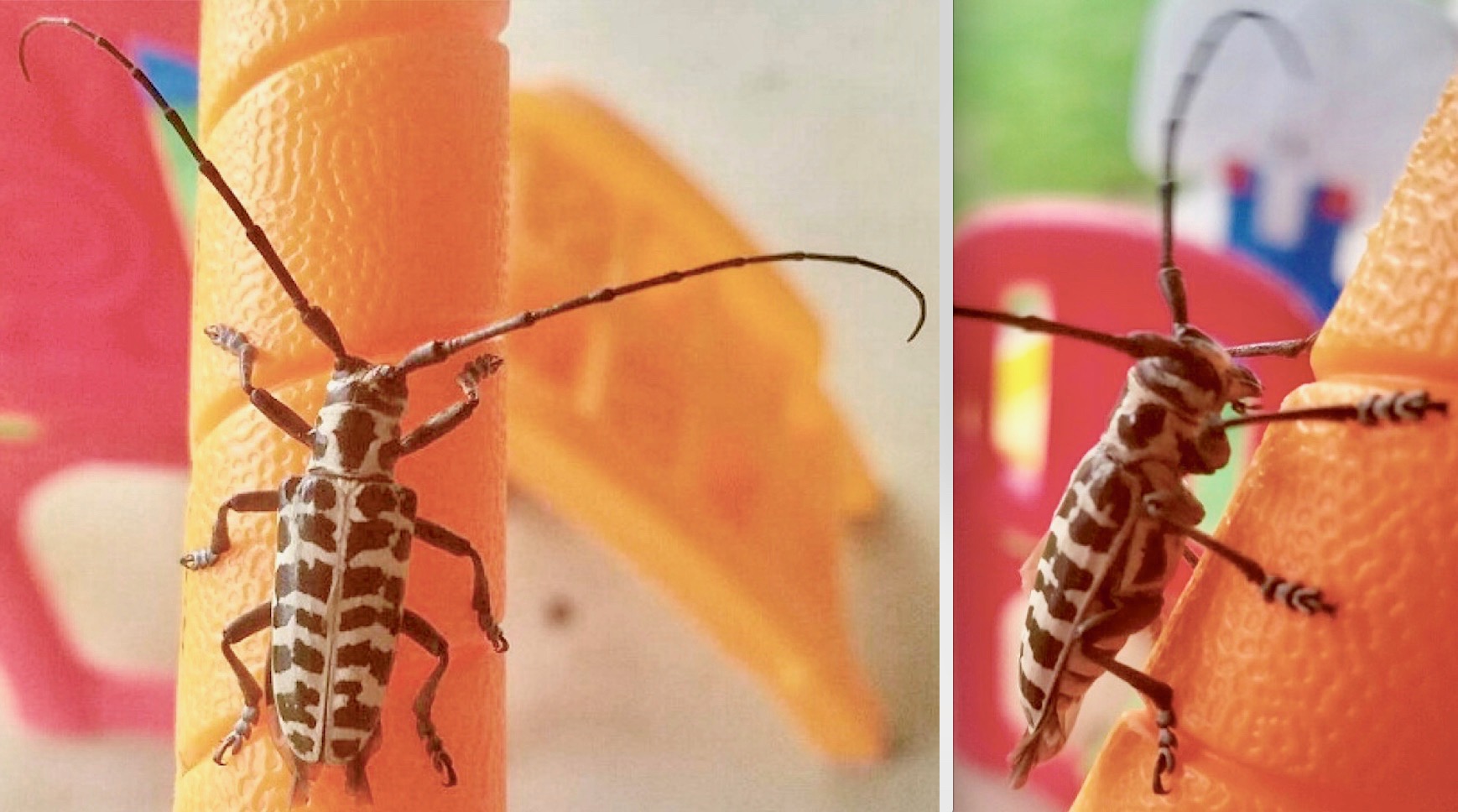 Cottonwood borer, Plectrodera scalator, subfamily Lamiinae, family Cerambycidae. □ The cottonwood borer grows to 1.25 inches (more than 3 cm) long, not counting the elongate antennae, which can be longer than the body. Its pattern of squarish black marks on a creamy-yellow background set it apart from other beetles. There's a little bit of pattern variation between individuals (as seen in the next photos). Photographed and identified by: Mike Toombs. Location: Colorado City, Texas, USA. Date: 18 June, 2018. Mike took this photo in a backyard with "many older cottonwood trees" there and throughout the city. |  Cottonwood borer, Plectrodera scalator, subfamily Lamiinae, family Cerambycidae. □ Cottonwood borers not only are pests of cottonwood trees, but also of poplar and willow trees. Larvae live under the bark for a year or two, and adults typically begin emerging in mid-May in Texas, so this one appeared a bit on the early side. Photographed by: Jordan Navarrete. Identified by: KnowYourInsects.org. Location: San Antonio, Texas, USA. Date: 4 May, 2020. Jordan says, "Found this little guy in my vegi garden. |
 Mesquite girdler, Oncideres rhodosticta, subfamily Lamiinae, family Cerambycidae. □ Mesquite girdlers are also sometimes known as twig-girdling insects. Both names refer to their habit of chewing off bark all the way around twigs, which is known as girdling. SThis can kill the twig beyond the girdle point. Photographed and identified to order by: Rodney A. Johnson Jr. Identified to species by: KnowYourInsects.org. Location: Mesa, Arizona, USA. Date: 3 October, 2016. |  Flat-Faced Long-Horned Beetle in the genus Spalacopsis, subfamily Lamiinae, family Cerambycidae. □ This flat-faced long-horned beetle is a thin beetle measuring less than an inch long. A close examination reveals the tiny hairs that extend from the the length of the antennae. Photographed by: Craig Witkowski. Identified to genus by: KnowYourInsects.org. Location: Naples, Florida, USA. Date: 22 December, 2019. Craig says, "I found this little insect in the car today, so I figured I would take a few shots of it and try to figure out what it was. It was very patient with being photographed." |  Flat-faced longhorn beetle, also known as a boring beetle, Ceroplesis militaris, subfamily Lamiinae, family Cerambycidae. □ The two thin stripes on this longicorn beetle are slightly different colors in this photo: purplish-pink and orangish-pink. One more thin stripe is also seen at its rear edge. □ This species is featured on a 30-cent South African stamp (dated 1987). Photographed by: Marike Blom. Identified by: KnowYourInsects.org. Location: Port Elizabeth, Eastern Cape, South Africa. Date: 15 April, 2020. |
 Flat-faced longhorn beetle, also known as a boring beetle, in the genus Ceroplesis, possibly Ceroplesis sumptuosa, subfamily Lamiinae, family Cerambycidae. □ This flat-faced longhorn beetle has has three red bands on a black background. Photographed in South Africa, this is a close match for the species Ceroplesis sumptuosa. Photographed by: Andre Kleynhans. Identified by: KnowYourInsects.org. Location: Pretoria, South Africa. Date: 23 November, 2019. Andre says, "These beetles are all over a dead tree in my garden." |  Flat-faced longhorn beetle, also known as a boring beetle, Ceroplesis capensis, subfamily Lamiinae, family Cerambycidae. □ This flat-faced longhorn beetle has four red bands across its back, the second of which is curved forward. Photographed by: Meagan Van Der Merwe. Identified by: KnowYourInsects.org. Location: north of Capetown, South Africa. Date: 22 February, 2021. |  Flat-faced longhorn beetle, Phryneta aurocincta, subfamily Lamiinae, family Cerambycidae. □ This flat-faced longhorn beetle has two wide reddish-orange bands on its elytra, which are studded with tiny indented spots. □ This beetle was first described by French naturalist and illustrator Félix Édouard Guérin-Méneville (1799-1874). To see some of Guérin-Méneville's illustrations, click here. Photographed by: Samuel Adedeji Otebolaku. Identified by: KnowYourInsects.org. Location: Nigeria. Date: 8 September, 2021. Samuel says, "I love nature's animals, insects and plants. This insect is cute but I don't know its identification." |  Flat-faced longhorn beetle, Leptostylopsis planidorsus, subfamily Lamiinae, family Cerambycidae. □ This species of flat-faced longhorn beetle typically has a light-colored thorax and two light-colored bands running across the back (one at the "shoulders" and one farther back). Each leg also has a pretty bulky, somewhat bulbous femur, and the antennae are banded. □ Neither this species or the genus has not been studied much, but is believed that the larvae of most species in this genus bore into dead branches of hardwood trees. Photographed and identified to family by: DL Dobson. Identified to species by: KnowYourInsects.org. Location: Hammond, Louisiana, USA. Date: early July 2021. |
 Flat-faced long-horned beetle, Urgleptes querci, subfamily Lamiinae, family Cerambycidae. □ This flat-faced long-horned beetle has an intricate pattern on its back. The pattern varies quite widely among individuals, but all share the wide black band near the rear and the two black spots behind it (although the spots may be faint). Photographed by: Victor Leverenz. Identified by: KnowYourInsects.org. Location: Oxford, Michigan, USA. Date: 8 June, 2019. Victor says, "The body is about 1/8 inch and the antenna are much longer. Noticed it sitting on my desk." |  Flat-faced long-horned beetle in the genus Coptops, subfamily Lamiinae, family Cerambycidae. □ This flat-faced long-horned beetle has both a flat face and long "horns" (actually long antennae), like the insect in the previous photo. Although the two share the common name of flat-faced long-horned beetle, they are actually different species. Photographed by: Chua Kheng Sin. Identified by: KnowYourInsects.org. Location: Singapore. Date: 2 August, 2018. Chua says he found this insect "inside the gents toilet" KnowYourInsects.org says, "We've never seen a human structure that was impervious to insects!" |  Flat-faced longhorn beetle in the subfamily Lamiinae, family Cerambycidae. □ The identity of this flat-faced longhorn beetle remains a mystery. If you know the genus or species, please let us know! Photographed by: Stef Stevens. Location: Panama. Date: 27 December, 2020. Stef spotted this beetle in the garden. |  |
 Long-Horned Borer Beetle, Xylorhiza adjusta, subfamily Lamiinae, family Cerambycidae. □ This long-horned boring beetle has unusual hairy elytra (forewings). Most beetles have no such feature. This beetle is found in many parts of Southeast Asia, also northeast into China. Photographed and identified to family by: K J Westman. Identified to species by: KnowYourInsects.org. Location: Nithulemada, Rajawella, Kandy, Sri Lanka. Date: 9 November, 2018. K J says, "The wings of my beetle look quite different from the wings of the Long Horn beetles on your webpage." KnowYourInsects.org says, "Yes! Those hairy forewings are amazing!" |  Long-Horned Borer Beetle, Xylorhiza adjusta, subfamily Lamiinae, family Cerambycidae. □ The face on this long-horned boring beetle looks almost like that of a lion. The swept-back antennae are also quite handsome. Photographed and identified to order by: Zywietz Valentin. Identified to species by: KnowYourInsects.org. Location: Meghalaya, northeastern India. Ist a hilled area with a river flowing through. Mostly forested except where settled – some rice agriculture. Date: 2009. Zywietz found this beetle in "a hilled area with a river flowing through; mostly forested except where settled – some rice agriculture." |
 Longicorn Beetle, Prosopocera lactator, subfamily Lamiinae, family Cerambycidae. □ This handsome brown and white longicorn beetle looks different from various angles. Most individuals in this species have more striping on the back, but there are some with just one central brown stripe, as seen here. Photographed by: Paru Bhaga. Identified by: KnowYourInsecs.org. Location: Lusaka, Zambia. Date: 22 December, 2019. |  Long-Horned Beetle, Graphisurus triangulifer, subfamily Lamiinae, family Cerambycidae. □ This long-horned beetle has banded legs and antennae, as well as a white-outlined, black, irregular-shaped triangle on each of its elytra (the hardened forewings that cover its abdomen. The long and thin spike extending from the rear of this female is an egg-laying structure called an ovipositor. Photographed by: Jonathan Wheatley. Submitted by: Rachell Sullivan. Identified by: KnowYourInsects.org. Location: Central Kentucky. Date: 9 July, 2020. |  Long-horned beetle, possibly in the genus Graphisurus, subfamily Lamiinae, family Cerambycidae. □ This long-horned beetle is brown with a mottled black pattern. It has has pointed projections on the sides of its thorax, and striped antennae. Spotted, photographed, and identified by: 6-year-old Taylah Myrick and her mom Annette. Great job! Location: Castle Rock, Colorado, USA. Date: 14 June, 2020. |
 |  Brown prionid, Orthosoma brunneum, subfamily Prioninae, family Cerambycidae. □ Despite the rather large and strong jaws on this brown prionid, the adults are believed to eat very little, if at all. In their short adult lives, the main task is to mate. Photographed by: Molly Bengelink. Identified by: KnowYourInsects.org. Location: Holland, Michigan, USA. Date: 18 July, 2016. Molly says, "I have never seen anything like that around our house before and it had us all a little curious (and somewhat uneasy initially)." |  Brown Prionid, Orthosoma brunneum, subfamily Prioninae, family Cerambycidae. □ The photo at right shows a close-up of the brown prionid, and makes evident the small spines extending from the thorax. Also note the large jaws on this big beetle. The beetle is not aggressive, but if it is provoked (especially if it is cornered and can't get away), it will defend itself as best it can and might even bite. Photographed by: Dave Delman. Identified by: KnowYourInsects.org. Location: Tucson, Arizona, U.S. Date: 5 January, 2018. Dave says, "It was really big!" KnowYourInsects.org says, "Yes, they can reach almost 2 inches long (nearly 5 cm)!" |
 Brown Prionid, Orthosoma brunneum, subfamily Prioninae, family Cerambycidae. □ The brown prionid can grow to between 1–1.9 inches long (2.5–4.8 cm), so it's a good-sized beetle! Photographed by: Rob Fox. Identified by: KnowYourInsects.org. Location: Ross (near Pittsburgh), Pennsylvania, USA. Date: 4 August, 2017. Rob says, "It was approx. 1.5" in length." |  Stenodontes Beetle, male, in the genus Stenodontes, subfamily Prioninae, family Cerambycidae. □ Note the long, narrow jaws on this male stenodontes beetle! The Stenodontes genus has three species: S. chevrolati, S. damicornis and S. exsertus. The latter two have been recorded from Puerto Rico, where this photo was taken, but S. chevrolati may also occur in that country, according to entomologist Antonio Santos-Silva. From this photo, he was unable to determine which species it is. Photographed by: Juraj Bajgar. Submitted and identified to order by: Clara Bajgar. Identified to family by: KnowYourInsects.org. Identified to genus by: entomologist Antonio Santos-Silva at the University of São Paulo. Thank you Dr. Santos-Silva! Location: Represa Lago Guajataca (about two hours from San Juan), Puerto Rico. Date: 19 September, 2018. Clara notes that this beetle was quite large — about 7 cm (3 inches) long. |  Palo verde root borer, female, Derobrachus hovorei, subfamily Prioninae, family Cerambycidae. □ The Palo Verde root borer is large, black and has little spikes on the thorax (as seen in the photo). Note: This species is sometimes mistakenly listed as Derobrachus geminatus. Photographed by: Jon Mullen. Identified by: KnowYourInsects.org. Location: Las Vegas, Nevada, USA. Date: 16 July, 2019. Jon says this beetle, which he estimated as being about 2.5 inches long (6.3 cm), greeted him in his living room. |
 Broad-necked root borer, male, Prionus laticollis, subfamily Prioninae, family Cerambycidae. □ As the name implies, the broad-necked root borer tunnels into and eats roots of trees and shrubs — usually going after trees and shrubs that are unhealthy. See the female in the next photos. Photographed and identified to order by: Louise Sandler. Identified to species by: KnowYourInsects.org. Location: Chester County, Pennsylvania, USA. Date: 7 August, 2017. Louise says, "The head and body were about 2 inches long!" |  Broad-necked root borer, female, Prionus laticollis, subfamily Prioninae, family Cerambycidae. □ The broad-necked root borer uses her ovipositor (shown here) as a hypodermic needle to stab into the ground (or in piles of leaves) and lay her eggs there. Once they hatch into larvae (grubs), the larvae eat tree and bush roots. See the male in the previous photo. Photographed by: Jo-Anne O. Identified by: KnowYourInsects.org. Location: Highlands, New Jersey, USA. Date: 11 July, 2019. Jo-Anne found this 2-inch (5 cm) beetle in her garden on a July evening. |  Broad-necked root borer, female, Prionus laticollis, subfamily Prioninae, family Cerambycidae. □ The female broad-necked root borer only survives as an adult for about a week, but she is very busy dyring that time, laying up to 500 eggs! Photographed by: Paul Byrne. Identified by: KnowYourInsects.org. Location: Beacon, New York, USA. Date: 29 June, 2020. Paul says, "We just moved to this house and it's on a creek. We heard that we'd see some new bugs, insects and spiders so....here we go. Lol." |  Broad-necked root borer, female, Prionus laticollis, subfamily Prioninae, family Cerambycidae. □ This female broad-necked root borer had just emerged from the hole when the photographer snapped this photo. She uses her long ovipositor (the tail-like structure) to lay her eggs in soft dirt. When the larvae hatch out, they may continue to live underground for a couple of years, sometimes more, before finally becoming an adult. □ The females are much larger than the males, but unlike the males, the females cannot fly. Photographed and identified as a female beetle by: Chris Cahill. Identified to species by: KnowYourInsects.org. Location: Mashpee, Massachusetts, USA. Date: 12 July, 2020. Chris says, "Wish I took a better picture. Didn't want to get too close to it since I had no clue what it really was. Thought it was some sort of an alien bug that bored up from the center of the earth." Hee hee! |
 Longicorn beetle, female, possibly Acanthophorus serraticornis, subfamily Prioninae, family Cerambycidae. □ The male adult longicorn beetle has longer mandibles than the female (the female is pictured here). Including his mandibles, which can be 0.8 inches (2.1 cm) in length, the male can reach 4.5 inches (11.5 cm) long, according to researchers. Photographed and identified to family by: Surabhika Panda. Identified by: KnowYourInsects.org. Location: Navsari, Gujarat, India. Date: 12 July, 2019. Surabhika found it in a mango orchard. |  Long-horned beetle, female, Callipogon sericeum, subfamily Prioninae, family Cerambycidae. □ This is an adult female long-horned beetle, and the female of this particular species can reach 3 inches (7.5 cm) in body length. The male is smaller. See the comment below for a fun description of this large beetle. Photographed by: Juraj Bajgar. Submitted by: Clara Bajgar. Identified by: KnowYourInsects.org. Location: in the mountains about two hours outside San Juan, Puerto Rico. Date: 13 May, 2019. Clara says, "The bug is moving, thus not in focus. The wings are nicely patterned and it has a few symetrical white dots on the 'torso.' ... After making (the photo) lighter and sharper, it looks like a roach dressed up for a wedding." |  Root borer, subfamily Prioninae, family Cerambycidae. □ Without a bit more detail in the photo, it is difficult to identify the species. A possibility is the live-oak root borer (Archodontes melanopus). Photographed and identified to subfamily by: Kirsten Kischuk. Location: Orlando, Florida. Date: 29 October, 2019. Kirsten says it was about as long as her thumbnail. |
 Hardwood stumpborer, Mallodon dasystomus, subfamily Prioninae, family Cerambycidae. Hardwood stumpborer, Mallodon dasystomus, subfamily Prioninae, family Cerambycidae.□ The hardwood stumpborer may be either black or dark reddish brown, and has two large shiny patches on the thorax, which is otherwise rather dull-looking. Photographed by: Judie Kahn. Identified by: KnowYourInsects.org. Date: 1 June, 2020. Location: Houston, Texas, USA. Judie says, "Only saw one. It was in a tub of water. Thought it was dead and took it out. About 10 minutes later it started to move around. I hate to kill anything so I put it in an empty lot with trees. Later it was gone." |  Hardwood stumpborer, Mallodon dasystomus, subfamily Prioninae, family Cerambycidae. Hardwood stumpborer, Mallodon dasystomus, subfamily Prioninae, family Cerambycidae.□ The name hardwood stumpborer comes from its larvae, which tunnel into the trunks (or stumps) of a wide variety of hardwood trees, including oak, hickory and maple. The photographer estimated is at about 1.5 inches (3.8 cm) long. Photographed by: Ronald J. Wisby. Identified by: KnowYourInsects.org. Date: 2 June, 2020. Location: Southwest Louisiana, USA. Ronald says this beetle gave someone quite a good bite. |  |  Long-horned beetle, Xylotrechus smei (previously Xylotrechus stebbingi), subfamily Cerambycinae, family Cerambycidae. □ To see the subtle differences between this long-horned beetle and the closely related species Xylotrechus stebbingi, click here. Photographed by: Syed Gazanfar. Identified by: KnowYourInsects.org. Location: Kashmir, India. Date: 23 April, 2018. |
 Bamboo borer, Megacyllene robiniae, subfamily Cerambycinae, family Cerambycidae. □ The bamboo borer is quite attractive with its circular markings. The closeup photo shows that it is covered with short hairs. Adults grow to about 0.6 inches (1.5 cm) long. As their name suggests, they are typically found in and around bamboo. Photographed by: Amit S. Identified by: KnowYourInsects.org. Location: Pune, Maharashtra, India. Date: 25 July, 2021. |  Locust borer, Megacyllene robiniae, subfamily Cerambycinae, family Cerambycidae. □ This species is called a locust borer because it most notably does damage to black locust trees. Adults are about 3/4 inch long (1.9 cm). Photographed by: Gordon Goos. Identified by: KnowYourInsects.org. Location: Benton County, Washington, USA. Date: 1 September, 2017. Gordon says, "Found several more this evening. One was eating flesh from a freshly cracked ripe cantaloupe." |  Long-horned beetle in the subfamily Cerambycinae, family Cerambycidae. □ This species of long-horned beetle has curved markings around its eyes that look almost like eyebrows. It looks similar to some species in the genus Neocerambyx. PPhotographed by: Samuel Adedeji Otebolaku. Identified by: KnowYourInsects.org. Location: Nigeria. Date: 23 September, 2021. |
 Rustic borer, Xylotrechus colonus, subfamily Cerambycinae, family Cerambycidae. □ This rustic borer has some gorgeous patterning on its back (the patterning is actually on its hardened forewings, which are called elytra). It is called a borer, because its grubs bore into hardwood trees, such as hickory. This beetle was once in a different genus and had the scientific name of Clytus colonus. Photographed by: Amy Jones. Identified by: KnowYourInsects.org. Location: Milford, Sussex County, Delaware, USA. Date: 6 May, 2017. Amy says, "I've never seen anything like this before. It showed up in our house yesterday." |  Rustic borer, Xylotrechus colonus, subfamily Cerambycinae, family Cerambycidae. □ A characteristic of the rustic borer is the thin, white or cream-colored, undulating line at the base of the elytra (behind its thorax), along with the two broader black bands at the center and toward the tip of the elytra. See the photographer's comment below to see how she became acquainted with these beetles (hint: she found one in her hair)! Photographed by: Christina Sun. Identified by: KnowYourInsects.org. Location: East Marion, Long Island, New York, USA. Date: 13 April, 2020. Christina says, "Here's another of those dropping bores. This is the sixth one that just falls on my head while sitting the table for a meal. It looks like a Peking opera mask!" |  Mimusop stem borer, Pachyteria dimidiata, subfamily Cerambycinae, family Cerambycidae. □ The black, sometimes blue-black, of the mimusop stem borer's body is splashed with a bold yellow band across its back and half-yellow antennae. □ A wood-boring species, this beetle is considered a pest on trees in the genus Mimusops, which includes the Spanish cherry, also known as an iron wood tree (Mimusops elengi). Photographed by: Elaine Low. Identified by: KnowYourInsects.org. Date: 2 May, 2020. Location: Malaysia. |  Red-headed ash borer, Neoclytus acuminatus, subfamily Cerambycinae, family Cerambycidae. □ The larvae (grubs) of the red-headed ash borer bore into mainly dead or dying hardwood trees, including ash, especially trees that have already fallen. □ A few features of this beetle include the reddish coloration on the front half of the body, the pattern of yellow stripes on its back (actually the forewings, known as the elytra), and the thickened tips on its antennae. Photographed by: Emily Pierce. Identified by: KnowYourInsects.org. Location: Manassas, Virginia, USA. Date: 23 July, 2019. |
 Eucalyptus borer, also known as a eucalyptus long-horned borer, Phoracantha recurva, subfamily Cerambycinae, family Cerambycidae. □ This eucalyptus borer looks very similar to the closely related species Phoracantha semipunctata, but the latter has more black on its back. Both attack eucalyptus trees, and particularly those trees that are stressed. (See the photographer's comment below.) □ The Eucalyptus Borer is native to Australia and Papua New Guinea, but is now found in warmer climates in Europe, including Italy, where it was found in 2006 (and where this photo was taken), South America, North America, and Africa. Photographed by: Mari C. Identified by: KnowYourInsects.org. Location: Sardinia, Italy. Date: 1 December, 2019. Upon learning what it was, Mari says, "Then it comes from the Eucalyptus wood that I have at home for the stove!" |  Eucalyptus borer, also known as a eucalyptus long-horned borer, male, Phoracantha recurva, subfamily Cerambycinae, family Cerambycidae. □ The eucalyptus borer made its way from Australia to southern California in 1995 — this one was found in southern California — and is now found throughout the state. The male, seen here, has little spine-like hairs on the antennae. □ For more information about this beetle, click here (a University of California website). Photographed by: Preston David. Identified by: KnowYourInsects.org. Location: Fullerton, southern California. Date: 10 June, 2020. Preston says he found four of these beetles in his home. |  Long-horned beetle, Anelaphus moestus, subfamily Cerambycinae, family Cerambycidae. □ Many species have no particular common name and simply go by the group common name. This is the case with this long-horned beetle. Members of this species are often much darker brown than the individual in this photo. Note: At one time, the species name was different: Anoplium pinorum. Photographed by: Phillippe Saieed. Identified by: KnowYourInsects.org. Location: North Carolina, USA. Date: 25 June, 2019. |  Long-horned borer beetle, Elaphidion irroratum, subfamily Cerambycinae, family Cerambycidae. □ The larvae of this species of long-horned borer beetle has been reported to bore into the trunks of black mangrove trees (Avicennia germinans), which grow along tropical coasts. Photographed and identified to family by: Tyler Oberding. Identified to species by: KnowYourInsects.org. Location: Las Tunas, Cuba. Date: 19 January, 2019. |
 Monkeypod round-headed borer, Xystrocera globosa, subfamily Cerambycinae, family Cerambycidae. □ A close look at this beetle reveals the two dark stripes running down its back: one on each of its wings. It is known as a monkeypod round-headed borer because it bores into monkeypod trees, which were introduced to and now grow in many parts of Hawaii. Photographed by: Rikita Turner. Identified by: KnowYourInsects.org. Location: Oahu, Hawaii, USA. Date: 20 September, 2017. Rikita says, "This was in my ceiling." |  Monkeypod round-headed borer, Xystrocera globosa, subfamily Cerambycinae, family Cerambycidae. □ The monkeypod round-headed borer can easily grow to 3.2 cm (1.3 inches) long, and that is just the body. With the antennae, it can be twice that length. This species has spread to warm climates around the world. Photographed by: Juraj Bajgar. Submitted by: Clara Bajgar. Identified by: KnowYourInsects.org. Location: San Juan, Puerto Rico. Date: 6 September, 2018. Clara notes the "black 'eye brows.' |  Long-horned beetle, Obrium circumflexum, subfamily Cerambycinae, family Cerambycidae. Photographed and identified to order by: Bárbara Escudero Alejos. Identified to species by: KnowYourInsects.org. Location: Lima, Peru. Date: 20 December, 2017. Bárbara says, "I took this photo next to my bathroom at midday, but the day before it was walking over my arm." |
 Wasp borer, also known as a western ash borer, Neoclytus conjunctus, subfamily Cerambycinae, family Cerambycidae. □ The wasp borer is a species of high elevations in the western U.S. and up into Canada. Photographed by: Todd Phelps. Identified by: KnowYourInsects.org. Location: Humboldt County, California, USA. Date: 17 June, 2012. Todd found this beetle at 2,412 feet elevation near the coast. |  Wasp borer, also known as a western ash borer, Neoclytus conjunctus, subfamily Cerambycinae, family Cerambycidae. □ The wasp borer gets its name because its yellow patterning (shown in previous photo) gives the impression of a wasp, and because it makes boreholes, like those shown here in this piece of wood. Photographed by: Todd Phelps. Identified by: KnowYourInsects.org. Location: Humboldt County, California, USA. Date: 17 June, 2012. |  Wasp borer, also known as a western ash borer, Neoclytus conjunctus, subfamily Cerambycinae, family Cerambycidae. □ The pattern on the thorax of this wasp borer is evident in this photo. The wasp borer is also known as a western ash borer because the larvae bore into the wood of dead and dying ash trees. The larvae will also get into other wood, including that of oak and arbutus. Photographed by: Arnold Lundwall. Identified by: KnowYourInsects.org. Location: Montana, USA. Date: 20 February, 2019. |  Gray-winged neoclyt-borer, Neoclytus scutellaris, subfamily Cerambycinae, family Cerambycidae. □ The gray-winged neoclyt-borer is distinguished from similar-looking species by the yellow band across the upper back (technically the pronotum). The young (the grubs) bore into in oak and hickory trees. Photographed by: Christin McMahon. Identified by: KnowYourInsects.org. Location: McKinney, Texas, USA. Date: 2 July, 2018. Christin found this on her couch, and says, "At first I thought it was some sort of bee, then butterfly — it is rather weak, only somewhat moving its front legs." |
 Banded ash borer, Neoclytus caprea, subfamily Cerambycinae, family Cerambycidae. □ The banded ash borer feeds on sapwood of ash, sometimes hickory and oak, in diseased/stressed, dying, dead (or cut) trees. Females lay their eggs on the bark of these trees, the larvae eventually bore into the tree, and they survive the winter as pupae, transforming into adults and emerging in the early spring. Pupa will transform earlier — in winter months — in firewood that is kept indoors. Most people see Banded Ash Borers in their homes in the winter for this reason. Photographed by: Arthur Dabrowski. Identified by: KnowYourInsects.org. Location: Greenwood Lake, New Jersey, USA. Date: 27 January, 2019. |  Ivory-marked long-horned beetle, Eburia haldemani, subfamily Cerambycinae, family Cerambycidae. □ The doubled light-colored markings are especially noticeable — and elongated — in this beautiful specimen of ivory-marked long-horned beetle. Photographed by: Windy Bond. Identified by: KnowYourInsects.org. Location: Chattanooga, Tennessee, USA. Date: 19 June, 2018. |  Ivory-marked long-horned beetle, Eburia spp, subfamily Cerambycinae, family Cerambycidae. □ Ivory-marked long-horned beetles sometimes lack the ivory markings, but they retain other features, such as the heavily notched eyes that look almost like the letter "C", and the two small black bumps on the thorax. Photographed and identified to family by: Manzeal Khanal. Identified to species by: KnowYourInsects.org. Location: Uvalde, Texas, USA. Date: 9 August, 2019. |
 White oak branch girdler, Purpuricenus paraxillaris, subfamily Cerambycinae, family Cerambycidae. □ A couple of the features that set this white oak branch girdler apart from other orange and black beetles in the long-horned beetle family include the small spine on either side of its thorax, the wide-spaced ridges on its elytra (the wings covering its abdomen), and the small ridge running down the center of the thorax. Photographed and identified to order by: Jennifer Miller. Identified to species by: KnowYourInsects.org. Location: Williamsport, Susquehanna Valley, Pennsylvania, USA. Date: 19 June, 2021. |  Banded alder borer, Rosalia funebris, subfamily Cerambycinae, family Cerambycidae. □ The banded alder borer is black and white or (blue-tinged white) with bands on its antennae and on its back (actually its forewings or elytra), and a large black spot in the center of a white thorax. According to Washington University entomologist Arthur Antonelli, this beetle is sometimes attracted to wet paint. Some believe the paint smell may be similar to beetle's own pheromones. Photographed by: Michael Toombs. Identified by: KnowYourInsects.org. Location: Wenatchee, Washington, USA. Date: 22 July, 2018. Peggy says, " I've never seen one before." |  Rosalia longicorn, also known as the alpine longhorn beetle, female, Rosalia alpina, subfamily Cerambycinae, family Cerambycidae. □Seen in person, the rosalia longicorn has a bluish tint. According to Beetle Fauna of Germany, this attractive beetle is becoming increasingly rare due to beech deforestation and the removal of dead wood from forests. The female (shown here) has tufts of hair at the black segments of most of her antennae. The male has thinner antennae without the tufts. Photographed by: Ian Ryding. Identified by: KnowYourInsects.org. Location: central-western France. Date: 21 July, 2019. |  Cabbage palm longhorn beetle, Osmopleura chamaeropis, subfamily Cerambycinae, family Cerambycidae. □ Rather distinctive with the black and white striped thorax, the cabbage palm longhorn beetle feeds on cabbage palms (also known as sabal palmetto). Although it is not especially widespread, it can become quite numerous in small areas. Photographed by: Brooke Almiron. Identified by: KnowYourInsects.org. Location: Oviedo, Florida, USA. Date: 25 April, 2020. Brooke found this beetle on her porch. She says, "Thanks so much for identifying it for me. I was going crazy trying to find it and google had nothing for me." KnowYourInsects.org says, "Glad we could help!" |
 Flower longhorn, Bellamira scalaris, subfamily Cerambycinae, family Cerambycidae. □ The flower longhorn has an hourglass-like shape to its elytra (the wings covering its back) and an extended abdomen that peeks out beyond the wings. This species had quite a bit of variation in the amount of dark blotching on its elytra from one individual to the next. Photographed by: Anonymous. Identified by: KnowYourInsects.org. Location: northeastern USA. Date: 31 July, 2019. |  Long-horned beetle, Achenoderus octomaculatus, subfamily Cerambycinae, family Cerambycidae. □ It seems a shame that this beautiful insect has no common name beyond the generic one of long-horned beetle. With its red head, thorax and legs; white-spotted elytra, and very unusual fringed antennae (see enlarged photo at right), it is quite a stunning species. The photographer estimated its body at about 2 inches (5 cm) long. Photographed by: Anita Schiller Terry. Submitted by: Elizabeth Demetriades. Identified by: KnowYourInsects.org. Location: Patagonia, South America. Date: 29 October, 2020. Elizabeth says, "An awesome beetle indeed!" KnowYourInsects.org says, "Glad we could help!" |
 Red-headed beauty, Stenaspis verticalis insignis, subfamily Cerambycinae, family Cerambycidae. □ The red-headed beauty has two subspecies: Stenaspis verticalis insignis, which has a pair of black spots on its thorax (seen here); and Stenaspis verticalis arizonicus, which has a large black smudge on its thorax instead. Photographed and identified by: Bryan Bell. Nicely done, Bryan! Location: San Marcos, Texas, USA. Date: 2 October, 2021. Bryan says, "Found on pea gravel outside garden." |  Bumelia borer, Plinthocoelium suaveolens, subfamily Cerambycinae, family Cerambycidae. □ Bumelia borers come in different hues, sometimes red metallic, sometimes green, and sometimes blue-purple (like this one), but all have the red legs as seen in the right photo. Photographed by: Pavia Antonas. Location: New Providence Island, Bahamas. Date: 2 October, 2021. Pavia says, "I'm actually a birder and was out for several hours yesterday, walking an overgrown golf course. I had to "capture" this unusually beautiful fellow, as I'd never seen one like it and I've been here for 40 years." |  Elderberry borer, sometimes called an elderberry longhorn, Desmocerus palliatus, subfamily Lepturinae, family Cerambycidae. □ The elderberry borer has antennae with segments that noticeably widen at one end, which give the antennae an overall jagged appearance; and an orange front half on each elytra (hardened forewings that cover the abdomen). Photographed by: Joe Kerwin. Identified by: KnowYourInsects.org. Location: Southwest Missouri, USA. Date: 27 August, 2020. Joe says, "It was on my elderberry bush." |
 Flower long-horned beetle, Trigonarthris proximas, subfamily Lepturinae, family Cerambycidae. □ This flower long-horned beetle has some fuzz on its thorax — actually on the shield-like structure (called the pronotum) that covers the thorax. Photographed and identified by: Leslie Mertz. Location: Kalkaska County, Michigan, USA. Date: 17 June, 2012. |  Yellow velvet long-horned beetle, Lepturobosca chrysocoma, subfamily Lepturinae, family Cerambycidae. □ Look closely to see the very distinctive gold-colored "velvet," which scientists call pubescence, on the thorax (specifically the pronotum) of this yellow velvet long-horned beetle. It also has pubescence on the elytra (the hardened forewings that cover its back). Photographed by: Dave Delman, M.D. Identified by: KnowYourInsects.org with help from Audrey Maran. Location: Yellowstone National Park, Wyoming, USA. Date: 4 July, 2017. |  Red-shouldered pine borer, also known as a red-shouldered beetle Stictoleptura canadensis, subfamily Lepturinae, family Cerambycidae. □ This red-shouldered pine borer is holding its stiff elytra (stiff forewings) away from its body, allowing the membranous flight wings beneath to be seen. Photographed by: Alexander Tonkinson. Identified by: KnowYourInsects.org. Location: Wiltshire, UK. Date: 11 August, 2017. Jessamie Tonkinson, who sent in her husband's photo, says she saw this one buzzing around the back wall of her house in the garden. She notes that it had most of its wings exposed, and was roughly 12mm (about 0.5 inches) in length. |  Black-spotted long-horned beetle, also known as black-spotted long-horned beetle, Rhagium mordax, subfamily Lepturinae, family Cerambycidae. □ This black-spotted long-horned beetle has shorter antennae than most of the beetles in this family. The pattern on its elytra (hardened forewings that cover the abdomen) is reminescent of a marled wool sweater. Photographed by: Daryl Fleming. Submitted by: Helen Williams. Identified by: KnowYourInsects.org. Location: Woodleigh, Devon, UK. Date: 7 May, 2018. Helen says, "Found this chap in a garden." She adds, "It's a lovely looking one." KnowYourInsects.org agrees! |
 Red-brown long-horned beetle, male, Stictoleptura rubra, subfamily Lepturinae, family Cerambycidae. □ The male red-brown long-horned beetle (shown here) has an all-black head and thorax, and tan elytra (the forewings covering its back). The female is reddish- to orangish-brown on her head, thorax and elytra — it is her coloration that gives this species its common name of Red-Brown Long-Horned Beetle. It has been introduced to the United Kingdom, and is now often found in gardens there. Photographed and identified by: Éireann. Location: Colombia. Date: 11 July, 2019. |  Douglas fir beetle, also known as yellow douglas fir borer, Centrodera spurca, subfamily Lepturinae, family Cerambycidae. □ One of the distinguishing characteristics of the douglas fir beetle is the pair of tiny black dots about midway down the outer side of each elytra (the hardened forewings covering the abdomen). The larvae of this beetle make tunnels under the bark of douglas fir trees. Photographed and identified to order by: Carson Wille. Identified to species by: KnowYourInsects.org. Location: Near the Alsea River in the Siuslaw forest, mid-coast Oregon, USA. Date: 16 June, 2016. Carson says, "We found the beetle at our house.... It was around 1.5 inches long." |  Flower longhorn, possibly Centrodera sublineata, subfamily Lepturinae, family Cerambycidae. □ This flower longhorn is possibly the species Centrodera sublineata. Photographed to family by: Mike Toombs. Identified to possible species by: KnowYourInsects.org. Location: Fluvanna, Texas, USA. Date: 5 July, 2018. Mike described the area where he found this insect as "the arid west Texas region with mesquite-infested rangeland and cotton/wheat/grain sorghum production." |
 Spotted long-horned beetle, also known as a black-and-yellow longhorn, Rutpela maculata (formerly Strangalia maculata), subfamily Lepturinae, family Cerambycidae. □ The black markings about a third of the way back on the wings of this spotted long-horned beetle can be quite variable. In some individuals, the markings may be almost absent, and in others, they can form a small heart shape (as shown here), or may be quite large.. □ Note: The genus name has been updated from Strangalia to Rutpela. Photographed and identified by: Iggy Tavares. Location: Lloyds Park, Croydon, UK. Date: 18 September, 2018. |  Spotted long-horned beetle, also known as a black-and-yellow longhorn, Rutpela maculata (formerly Strangalia maculata), subfamily Lepturinae, family Cerambycidae. □ Spotted long-horned beetle have a variation between individuals. This individual has a quite large and angular pattern in the marking about a third of the way back on the wings. □ Note: The genus name has been updated from Strangalia to Rutpela. Photographed and identified by: Bryan Wenham-Baker. Location: Ivybridge, South Hams, South Devon, England, UK. Date: 6 July, 2019. Bryan says, "On my 'excursion' this morning I came across a first for me." KnowYourInsects.org says, "Way to go, Bryan! And nice job on the ID!" |  Flower long-horned beetle, Strangalia strigosa, subfamily Lepturinae, family Cerambycidae. □ This species of flower long-horned beetle is long, thin and tapered toward the rear. It is native to Florida, and that is its only location in the United States. Photographed by: Marv Goldberg. Identified by: KnowYourInsects.org. Location: Tamarac, Florida, USA. Date: 20 April, 2021. |  Flower long-horned beetle, subfamily Lepturinae, family Cerambycidae. □ This flower long-horned beetle has a faint pattern on its elytra. KnowYourInsects.org has been unable to identify it beyond the subfamily. If you know what it is, please contact Us Photographed by: Rick Caballero. Identified to subfamily by: KnowYourInsects.org. Location: Saint Zotique, Quebec, Canada. Date: 17 July, 2021. |
 Lion beetle, Ulochaetes leoninus, subfamily Necydalinae, family Cerambycidae. □ This lion beetle has short whitish elytra (the forewings or wing covers), leaving the flight wings exposed. Most other beetle species have longer elytra that conceal the flight wings when at rest. □ This species is sometimes called a flower longhorn or a bumblebee-mimic longhorn. Very little information has been published about it, so this beetle is still holding its secrets :-). Photographed and identified by: Marc Stenberg. Location: Vancouver Island, British Columbia, Canada. Date: 3 December, 2020. Marc says he milled some timber, moved it into his shop, and "a few weeks later, I had lion beetles on the window sills. It took me a bit to figure what the heck they were, but I did. LOL" He adds, "That's a strange-looking critter!" |  Long-horned beetle, family Cerambycidae. Photographed by: Leah McPherson. Identified by: KnowYourInsects.org. Location: Highland, Michigan, USA. Date: 25 July, 2016. Leah says, "It crawled in front of me and I attempted to catch it and when I did it made a very unnerving sound, like a creepy cricket." | Long-horned beetle, family Cerambycidae. Photographed by: Kislay kunar. Identified by: KnowYourInsects.org. Location: northern India. Date: 24 September, 2020. |
Attelabidae, the leaf-rolling weevils
 Hazel leaf-roller, Apoderus coryli, subfamily Attelabinae, family Attelabidae. □ The hazel leaf-roller is so named because the young live inside rolled-up leaves of hazel trees and shrubs. Photographed and identified by: Bryan Wenham-Baker. Location: Ivybridge, South Hams, South Devon, England, UK. Date: 29 July, 2018. |  Leaf-rolling weevil, Homoeolabus analis, subfamily Attelabinae, family Attelabidae. □ The female of this leaf-rolling weevil and other species in this family lay their eggs on a leaf, and roll up the leaf (like rolling up a rug) with the eggs inside. This protects the eggs as well as the larvae that later hatch from the eggs. Photographed by: Joan Smith. Identified by: KnowYourInsects.org. Location: Tampa, Florida, USA. Date: 9 June, 2017. |  |  |
Anthribidae, the fungus weevils
 Fungus weevil, females, Platystomos albinus, subfamily Attelabinae, family Anthribidae. □ This species of fungus weevil may be either dark brown or light brown, but all have a white patch on the snout and at the rear, and two white spots in the middle. The female (shown) has shorter antennae than the male. See the photographer's story below. Photographed by: Jennifer Sims. Identified by: KnowYourInsects.org. Location: Jegenstorf, Switzerland. Date: 29 July, 2018. Jennifer says one landed on her leg, and when she went to touch it, "it suddenly flipped over onto its back and played dead! Very cute!" |  |  |
Curculionidae, the weevils
 Citrus root weevil, also known as a chichí, Diaprepes abbreviatus, subfamily Entiminae, family Curculionidae. □ Adult citrus root weevils can be between 10–20 mm (3/8 to 3/4 inches) long, and the color can vary from cream to yellow to dark orange. Photographed by: Darryl Gracey. Identified by: KnowYourInsects.org. Location: Parrish (south of Tampa), Florida, USA. Date: July 2016. Darryl says, "I've not seen one of these before and had to snap it and research." |  Citrus root weevil, known locally in the Caribbean as a Chichí, Diaprepes abbreviatus, subfamily Entiminae, family Curculionidae. □ Information about this citrus root weevil, which has become a major pest on citrus since it was introduced to Florida in 1964, is available here. Photographed by: Carlo Castoro. Identified by: KnowYourInsects.org. Location: north side of Saint Thomas, U.S. Virgin Islands. Date: 30 July 2017. Carlo says, "I found this little guy crawling up the wall in a house.... Thanks for the cool website!" KnowYourInsects.org says, "Glad you like it!" |  Citrus root weevil, known locally in the Caribbean as a Chichí, Diaprepes abbreviatus, subfamily Entiminae, family Curculionidae. □ The top-down view of the previous specimen of citrus root weevil — It is a pretty weevil! Photographed by: Carlo Castoro. Identified by: KnowYourInsects.org. Location: north side of Saint Thomas, U.S. Virgin Islands. Date: 30 July 2017. |  Citrus root weevil, known locally in the Caribbean as a Chichí, Diaprepes abbreviatus, subfamily Entiminae, family Curculionidae. □ This particular citrus root weevil lacks the typical striped pattern of this species. Compare it to the others on this page to see the difference. Photographed by: Marv Goldberg. Identified by: KnowYourInsects.org. Location: Tamarac, Florida, USA. Date: unknown. |
 Citrus root weevil, known locally in the Caribbean as a Chichí, Diaprepes abbreviatus, subfamily Entiminae, family Curculionidae. □ The citrus root weevil is a pest on sugarcane too, so it is sometimes called a sugarcane rootstalk borer weevil. Because it was originally introduced to Apopka, Florida (near Orlando), it is sometimes called an Apopka weevil. □ The striped pattern on its back can vary. Compare this specimen to the others on this page. Photographed by: Mike Weyer. Identified by: KnowYourInsects.org Location: Jacksonville, Florida, USA. Date: 15 June, 2020 | 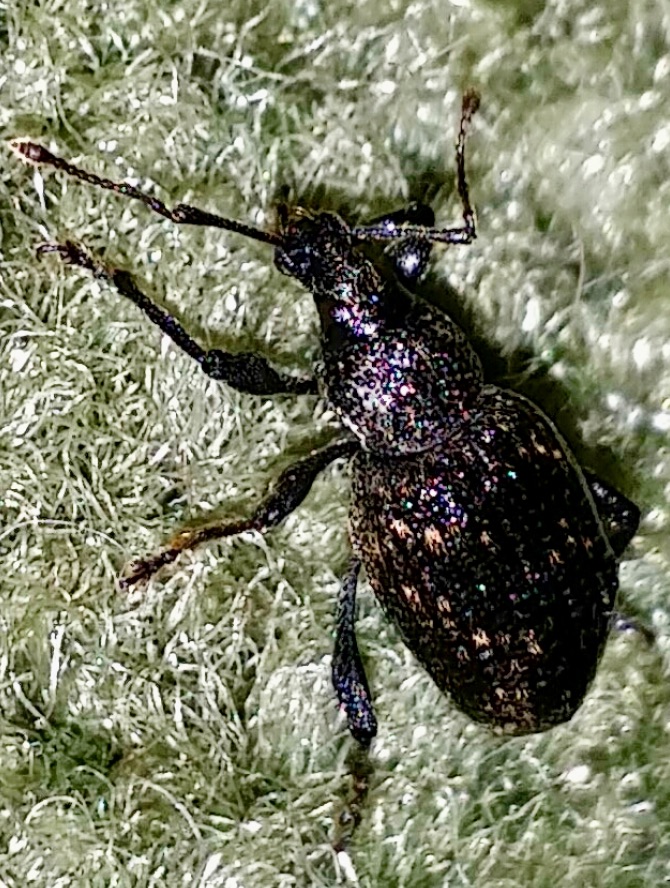 Black vine weevil, Otiorhynchus sulcatus, subfamily Entiminae, family Curculionidae. □ This black vine weevil is one of the group of weevils known as broad-nosed weevils. Compared to some of the other weevils in this family, this weevil's snout is much shorter and broader. □ It is native to Europe, but has spread to North America, where it is now quite common. Photographed by: Dave Delman. Identified by: KnowYourInsects.org. Location: New York, USA. Date: 13 December, 2017. |  Black vine weevil, Otiorhynchus sulcatus, subfamily Entiminae, family Curculionidae. □ The black vine weevil is sometimes called a cyclamen weevil, cyclamen grub, or European strawberry weevil. The larvae (grubs) eat the roots, and the adults munch on leaves. They are pests on cyclamen and many, many other plants. □ A close look reveals the fine hairs (called pubescence) on its back. This weevil only gets to be about 11 mm (0.5 inches) long. Photographed by: Derek Marshall. Identified by: KnowYourInsects.org. Location: UK. Date: 23 August, 2020. |  Black vine weevil, probably Otiorhynchus sulcatus, subfamily Entiminae, family Curculionidae. □ This black vine weevil has a lighter color than normal. This is likely due to its age — as they get older, the color can lighten, so this is probably an old individual, according to entomologist Robert S. Anderson of the Canadian Museum of Nature. Photographed by: Barb Auge. Identified by: entomologist Robert S. Anderson of the Canadian Museum of Nature. Thank you, Dr. Anderson! Location: Minnesota, USA. Date: 23 March, 2018. |
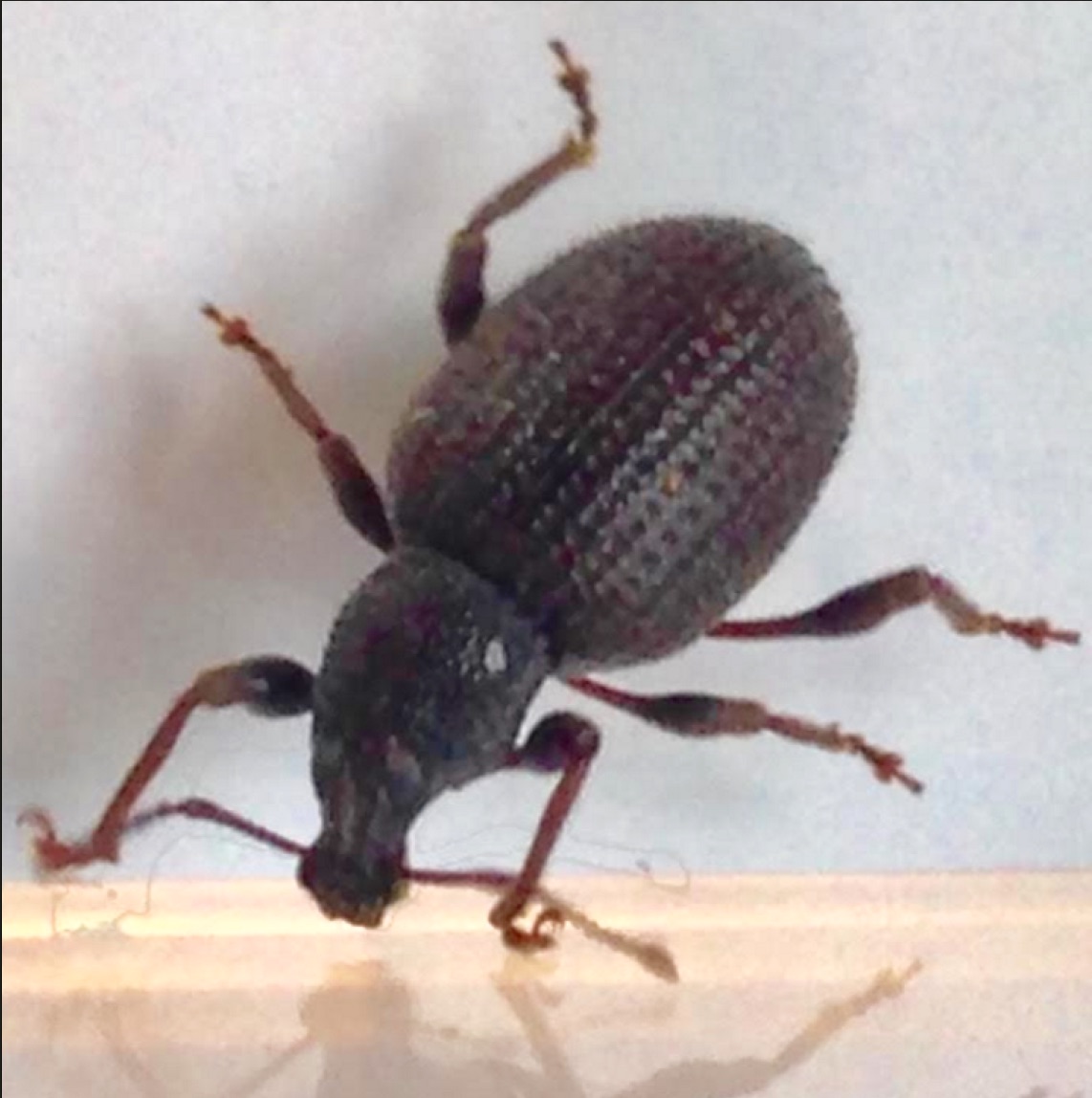 Rough strawberry root weevil, Otiorhynchus rugosostriatus, subfamily Entiminae, family Curculionidae. □Native to Europe and now in much of the world, the rough strawberry root weevil gets its name from the larvae, which are fond of the roots of strawberries, berries, and other plants. Photographed and identified to genus by: Kelly McKinne (@gonzonaturalist) Identified to species by: entomologist Robert S. Anderson of the Canadian Museum of Nature. Thank you, Dr. Anderson! Location: northern Ohio, USA. Date: 28 June 2016. Kelly says, "Found this 'lifer insect' in my bathroom today. Very cool!" |  Sri Lankan weevil, Myllocerus undecimpustulatus undatus, subfamily Entiminae, family Curculionidae. □ This Sri Lankan weevil made its way from Sri Lanka to Florida in 2000, and now it is in about half the counties in Florida, mostly the southern half of the state. It looks almost identical to another weevil called the Little Leaf Notcher (Artipus floridanus), which is native to Florida and the Caribbean. Two of the features that set the Sri Lankan Weevil apart are a slightly yellowish head (difficult to see here) and spines on its femur (noted with the yellow arrow). For more information on this species, click here. Photographed and identified as a weevil by: Marv Goldberg. Identified to species by: KnowYourInsects.org. Location: Tamarac, Florida, USA. Date: 18 January, 2019. |  Sri Lankan weevil, Myllocerus undecimpustulatus undatus, subfamily Entiminae, family Curculionidae. □ The Sri Lankan weevil has characteristic "shoulders". They are squared off in the Sri Lankan Weevil — almost as it it is wearing shoulder pads or military epaulets. Photographed by: Gail Sciarrone. Identified by: KnowYourInsects.org. Location: Lake Worth, West Palm Beach, Florida, USA. Date: 22 October, 2018. |
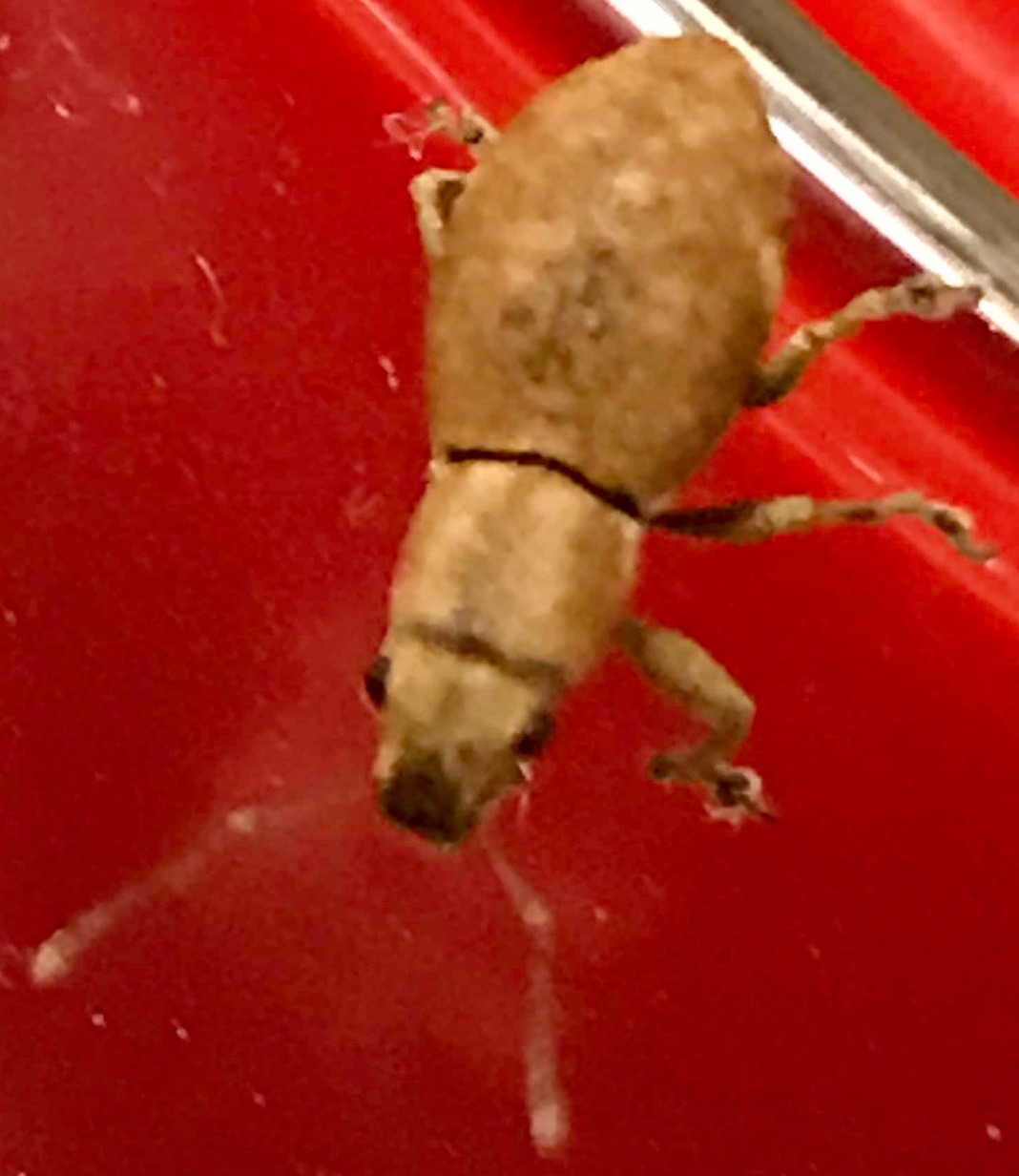 Fuller rose weevil, Naupactus cervinus, subfamily Entiminae, family Curculionidae. □ According to North Carolina State Extension, the fuller rose weevil feeds on all sorts of plants from maple and citrus trees to azalea and other flowers, and also is common in the vegetable garden on beans and potatoes. For more information on this insect, click here. Photographed by: Israel Suarez. Identified by: KnowYourInsects.org. Location: Lewisville, North Carolina, USA. Date: 7 December, 2017. Israel says, "It's about half a centimeter in length." | 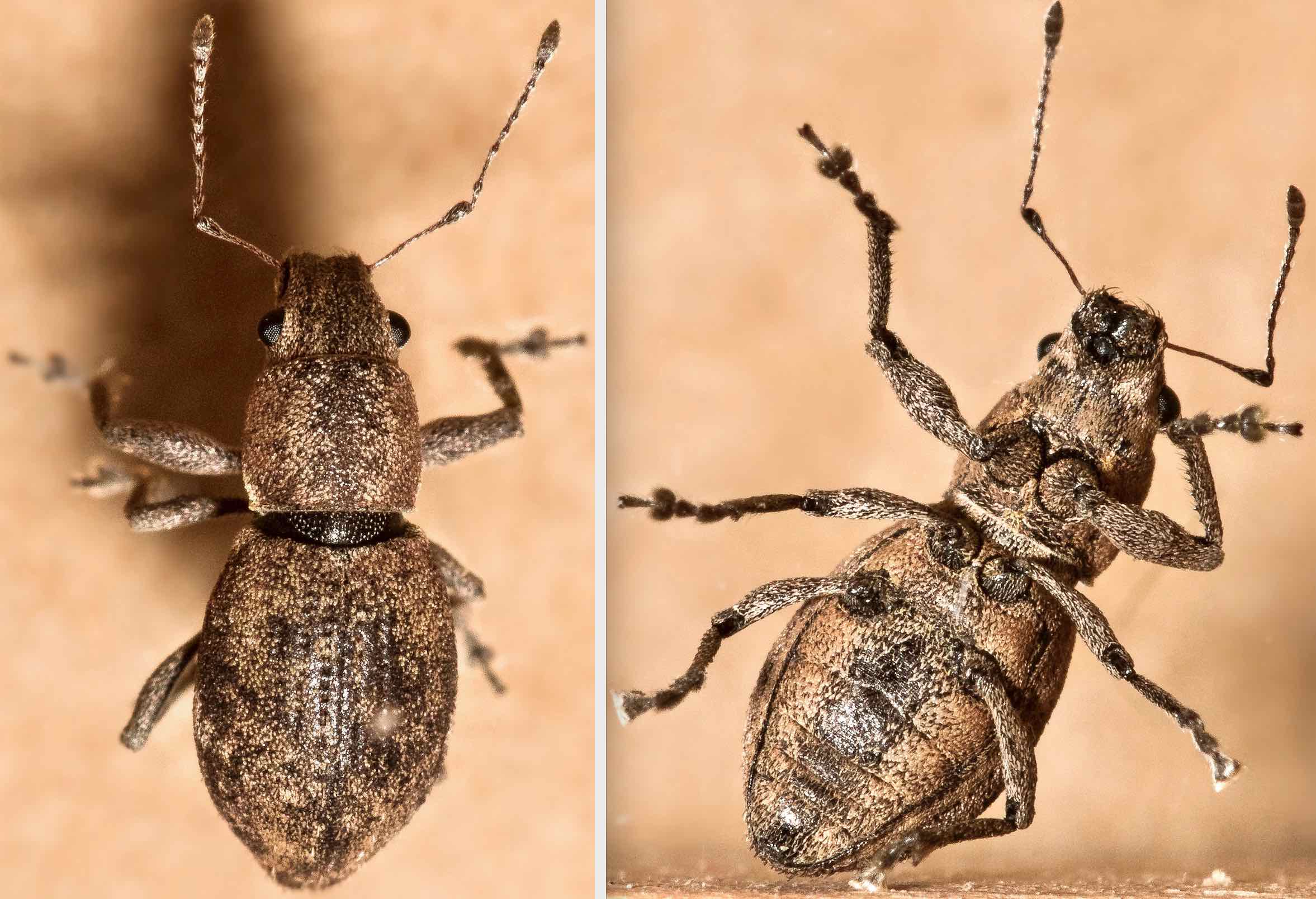 Fuller rose weevil, Naupactus cervinus, subfamily Entiminae, family Curculionidae. □ The Fuller rose weevil reproduces parthogenetically, which means that young can develop from unfertilized eggs. In typical sexual reproduction seen in most other animals, a female and a male each provide half the genetic information to produce a viable egg, but in parthogenesis, the eggs already have the full complement of genetic information, so there is no need for a male. In the fuller rose weevil, the female's young have the exact same genetic complement as she does: they are clones of her. Some other insects, such as bees and ants can reproduce either parthogenetically or sexually, so some of their members are male. With the fuller rose weevil, however, reproduction is only parthogenetic, so all are females. Photographed and identified by: Thomas Langhans. Nicely done, Thomas! See Thomas's full-size images here and here. Location: city of San Bruno, county of San Mateo, California, USA. Date: 23 October, 2021. Thomas says it was about 8mm in length, and he was able to identify it with the other photo of this species on this page. Awesome! | 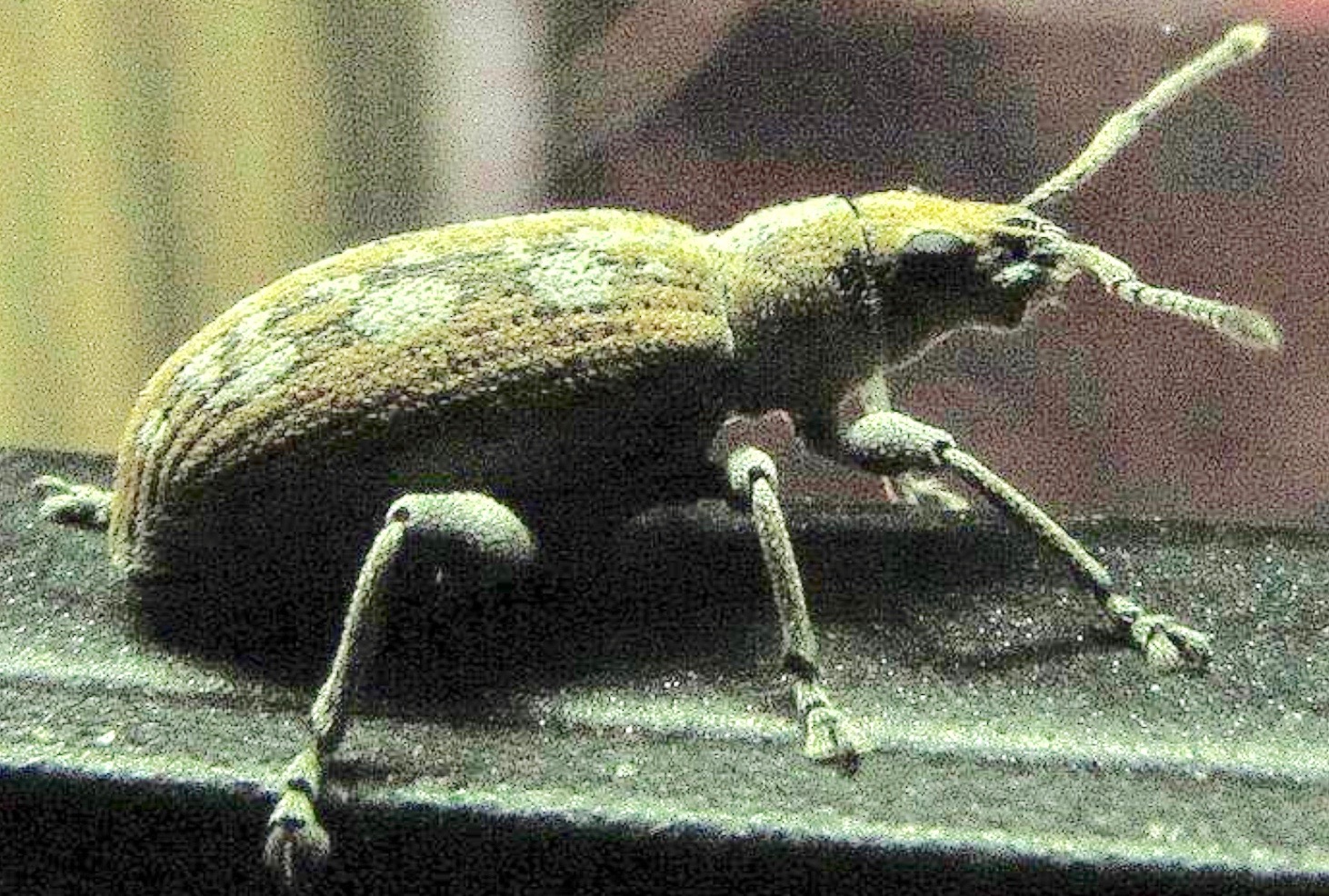 Broad-nosed weevil in the genus Myllocerus, subfamily Entiminae, family Curculionidae. Photographed and identified as a weevil by: K J Westman. Tentatively identified to genus by: Mahendran Govindasamy. Location: Nithulemada, Rajawella, Kandy, Sri Lanka. Date: 10 January, 2018. K J says, "It looks like it is some textile toy for kids." |
 Broad-nosed weevil, probably in the genus Ophryastes, subfamily Entiminae, family Curculionidae. □ The broad-nosed weevil is a member of a genus of weevils that are common to desert areas in the southwestern United States. Photographed by: Juan Jesus Hernadez. Identified by: KnowYourInsects.org. Location: Palm Springs, California, USA. Date: March 2017. |  Weevil, probably a vegetable weevil, Listroderes costirostris, subfamily Cyclominae, family Curculionidae. □ Native to South America, the vegetable weevil has been accidentally transported to other parts of the world. One of its most noticeable features is the large rostrum (the "nose"). This weevil will eat a wide variety of vegetables and other plants. Photographed by: Lynne Nguyen. Identified by: KnowYourInsects.org. Location: Montclair, California, USA. Date: 26 March, 2016. "I found it on my son's diaper this morning. (It was a) tad less than 1/4 inch." | 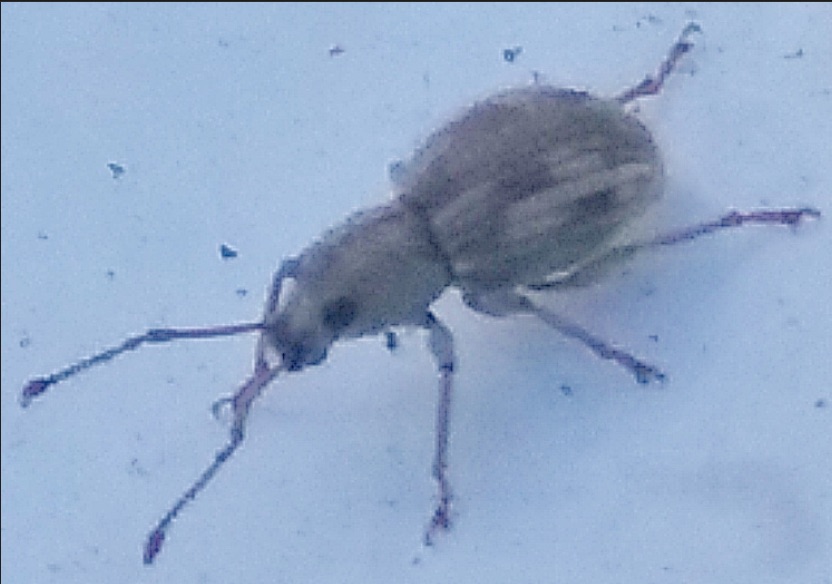 Imported long-horned weevil, Calomycterus setarius, subfamily Entiminae, family Curculionidae. □ Native to Japan, the imported long-horned weevil is now very common in much of the eastern United States and southeastern Canada, where they have become aguicultural pests on soybeans, alfalfa and other crops. The "seta" in the species name of setarius is Latin for bristles, and refers to the parallel rows of short bristles that run down the abdomen (too small to be visible in this photo). Photographed and identified as a weevil by: Carolina Torres. Identified to species by: Robert Anderson of the Canadian Museum of Nature's Beaty Centre for Species Discovery. Thank you, Dr. Anderson! Location: Galesburg, Illinois, USA. Date: 30 June, 2018. |  Pine weevil in the genus Brachyderes, subfamily Entiminae, family Curculionidae. □ The photo of this pine weevil was taken in the United Kingdom, where two similar species are found. Both are called pine weevils: Brachyderes lusitanicus and Brachyderes incants. Images of the two are available here and here. Photographed by: Cee Thompson. Identified by: KnowYourInsects.org. Location: England, UK. Date: 10 May, 2019. Cee described this weevil as about 1.2 cm long and 0.5 cm wide (about 1.3 long and 1/5 inch wide). |
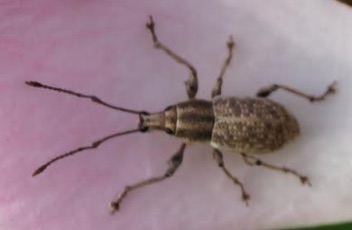 Broad-nosed weevil, possibly in the genus Catapionus, subfamily Entiminae, family Curculionidae. Photographed and identified to order by: Shefali Chaudhari. Identified to genus by: KnowYourInsects.org. Location: Location: Flori. farm, NAU, Navsari, Gujarat. Date: 10 December, 2018. | 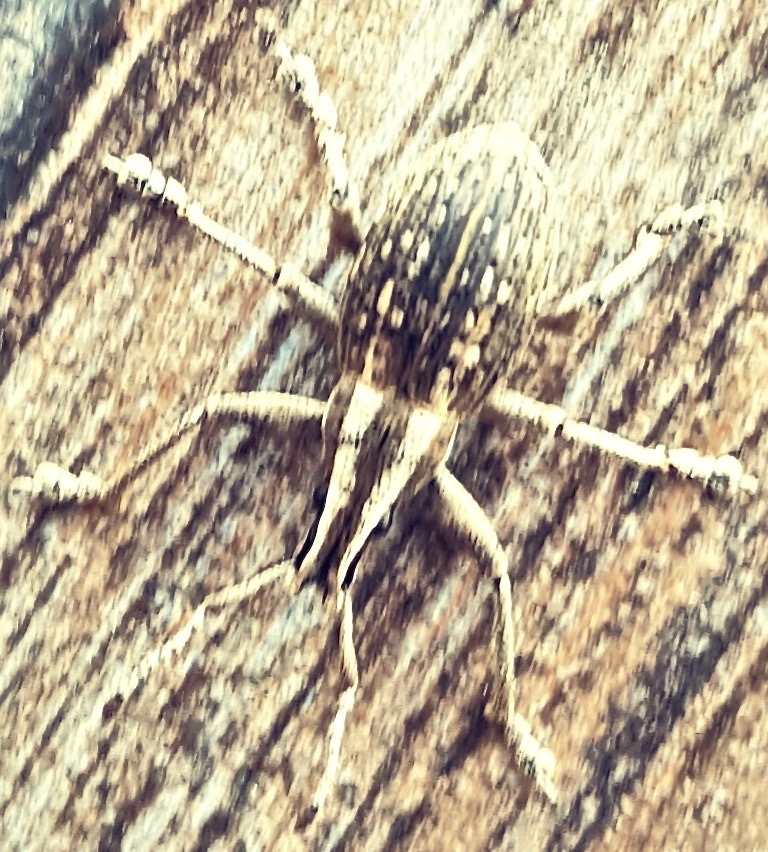 Broad-nosed weevil in the subfamily Entiminae, family Curculionidae. □ This broad-nosed weevil has a pair of bold white stripes down its head and thorax. If you happen to know the species, please let us know! Photographed by: Amit S. Identified to subfamily by: KnowYourInsects.org. Location: Pune, Maharashtra, India. Date: 27 November, 2020. |  Broad-nosed weevil in the subfamily Entiminae, family Curculionidae. □ This broad-nosed weevil has rows of pink spots along its elytra (the hardened wings covering its back), as well as pink markings on its thorax. If you happen to know the species, please let us know! Photographed and identified as a weevil by: Micaela Della Bruna. Identified to subfamily by: KnowYourInsects.org. Location: Sánchez, República Dominicana. Date: 11 November, 2019. |
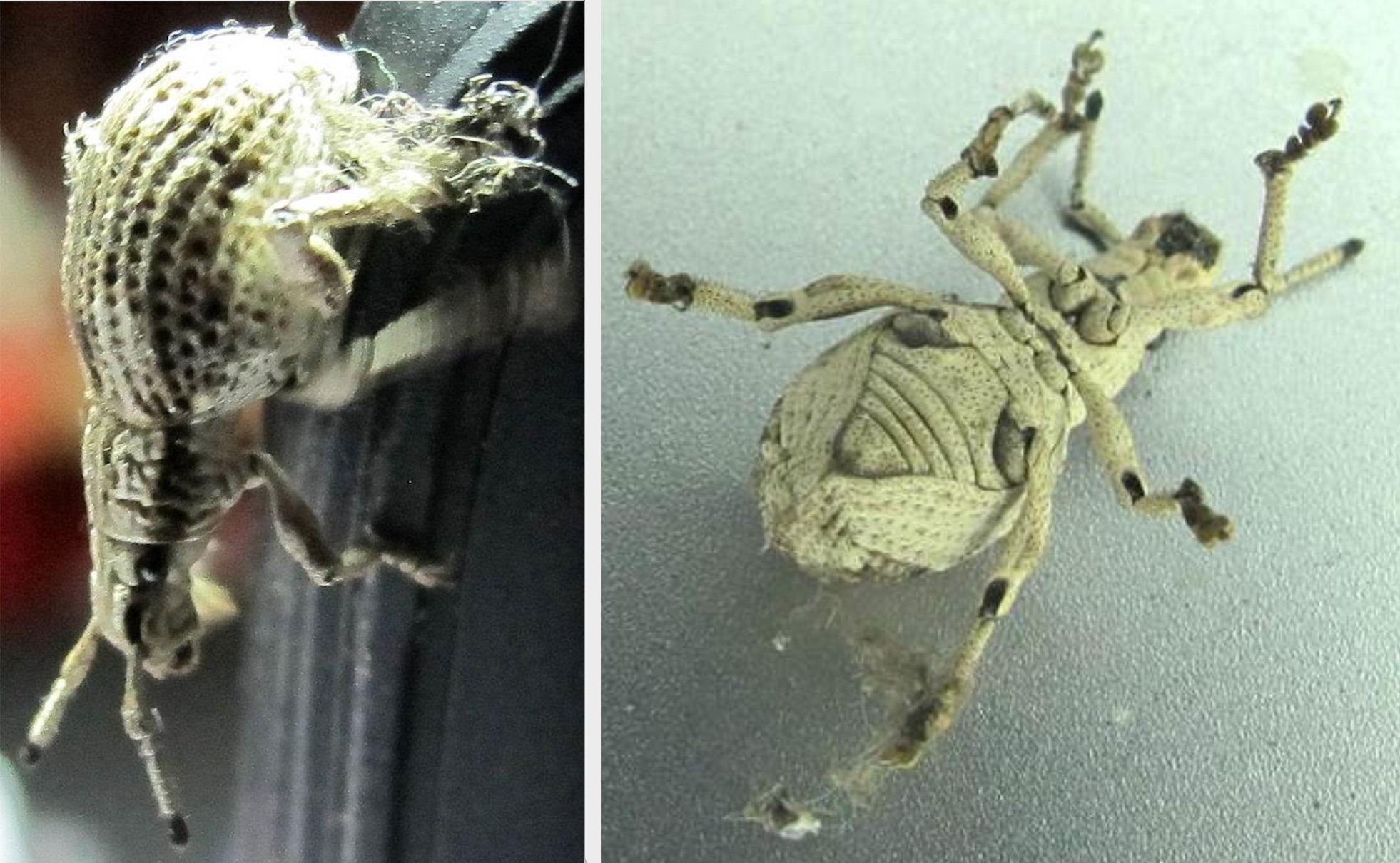 Broad-nosed weevil in the genus Episomus, subfamily Entiminae, family Curculionidae. □ This broad-nosed weevil looks like it is wearing a knitted sweater. Photographed and identified as a weevil by: K J Westman. Tentatively identified to genus by:Mahendran Govindasamy. Location: Nithulemada, Rajawella, Kandy, Sri Lanka. Date: 11 December, 2018. K J notes the "textiles" look of this weevil and says, "I find it quite intriguing with dots and dimples." |  Green immigrant leaf weevil, Polydrusus formosus, subfamily Cyclominae, family Curculionidae. □ The round scales give this little green immigrant leaf weevil its brilliant metallic-green color. Some of the scales in this individual have worn off — as they sometimes do — giving a peek at the dark-colored body underneath. Photographed by: Paul Hinkley. Identified by: KnowYourInsects.org. Location: Grand Rapids, Michigan, USA. Date: 29 August, 2017. |  Green immigrant leaf weevil, Polydrusus formosus, subfamily Cyclominae, family Curculionidae. □ The green immigrant leaf weevil is a tiny weevil at just 5-6 mm (about 0.2 inches) long. This photo shows its clubbed antennae, which is a feature of this species. Photographed and identified by: Leslie Mertz. Location: Houghton Lake, Michigan, USA. Date: 7 July, 2017. |
 Green immigrant leaf weevil, Polydrusus formosus, subfamily Cyclominae, family Curculionidae. □ green immigrant leaf weevils are often associated with yellow birch trees (Betula alleghaniensis), but they can show up just about anywhere: on flowers, on windows, on tables. The photographer spotted this one on a lawn chair in his yard. Photographed by: Bob McDevitt. Identified by: KnowYourInsects.org. Location: Saint John, New Brunswick, Canada. Date: 1 July, 2020. | 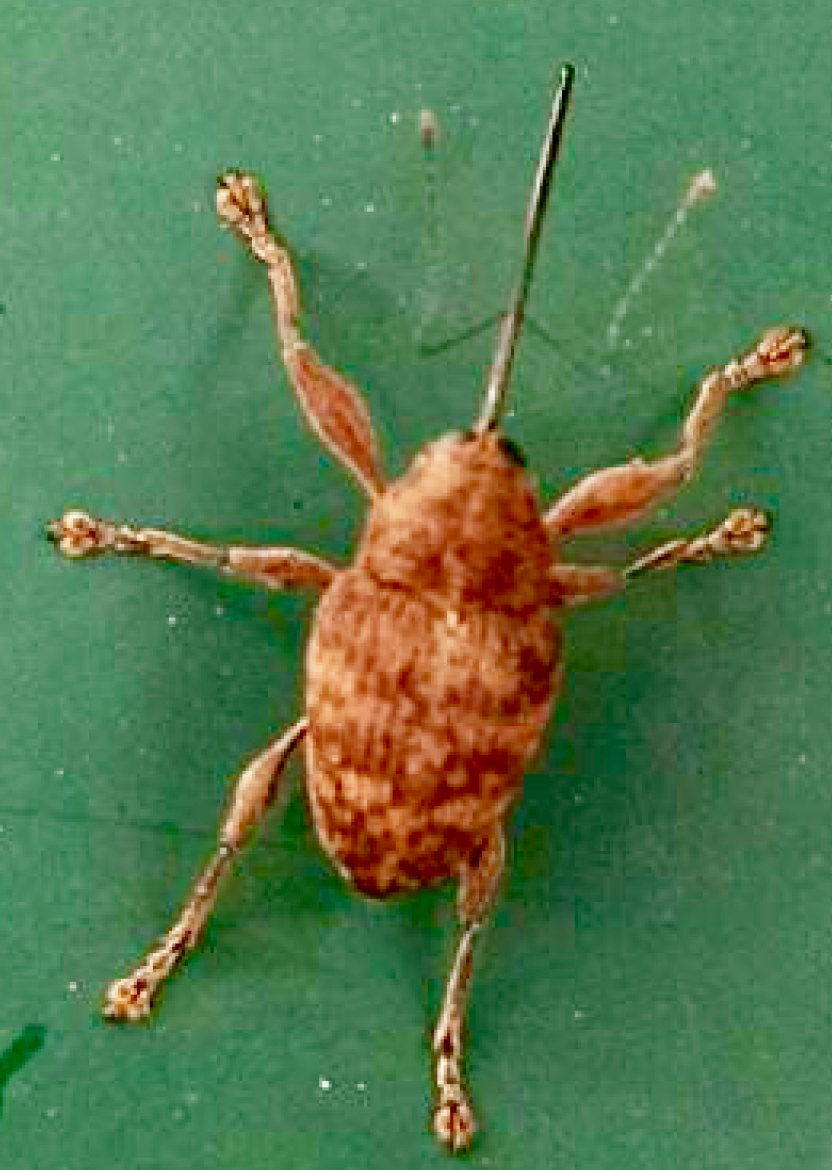 Weevil in the genus Curculio, quite possibly an acorn weevil, Curculio pardalis, subfamily Curculioninae, family Curculionidae. □ The genus Curculio includes more than two dozen species in the United States, and many look quite similar. This could be an acorn weevil. As the photographer notes, this weevil was found under an oak tree. Photographed by: Leah Gentry. Identified to genus by: entomologist Robert S. Anderson of the Canadian Museum of Nature. Thank you, Dr. Anderson! Identified to tentative species by: KnowYourInsects.org. Location: Tallahassee, Leon County, Florida, USA. Date: 3 September 2015. Leah says, "It was on my mailbox this afternoon! Mailbox sits under a water oak and several other trees." | 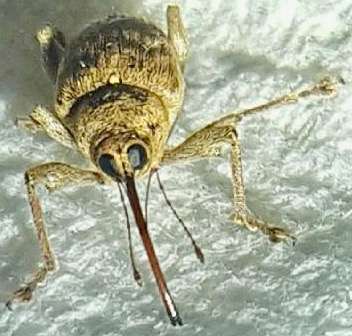 Acorn and Nut Weevil, quite possibly Curculio proboscideus, subfamily Curculioninae, family Curculionidae. □ My what big eyes you have! This is head-on, close-up photo of an acorn and nut weevil displays its almost soulful-looking eyes, as well as the amazingly long snout characteristic of the female of the species. Photographed and identified by: Amber Bedard. Location: Flint, Michigan, USA. Date: 23 August, 2019. Amber says, "They are rather cute!" KnowYourInsects.org says, "Great job with the ID, Amber!" | 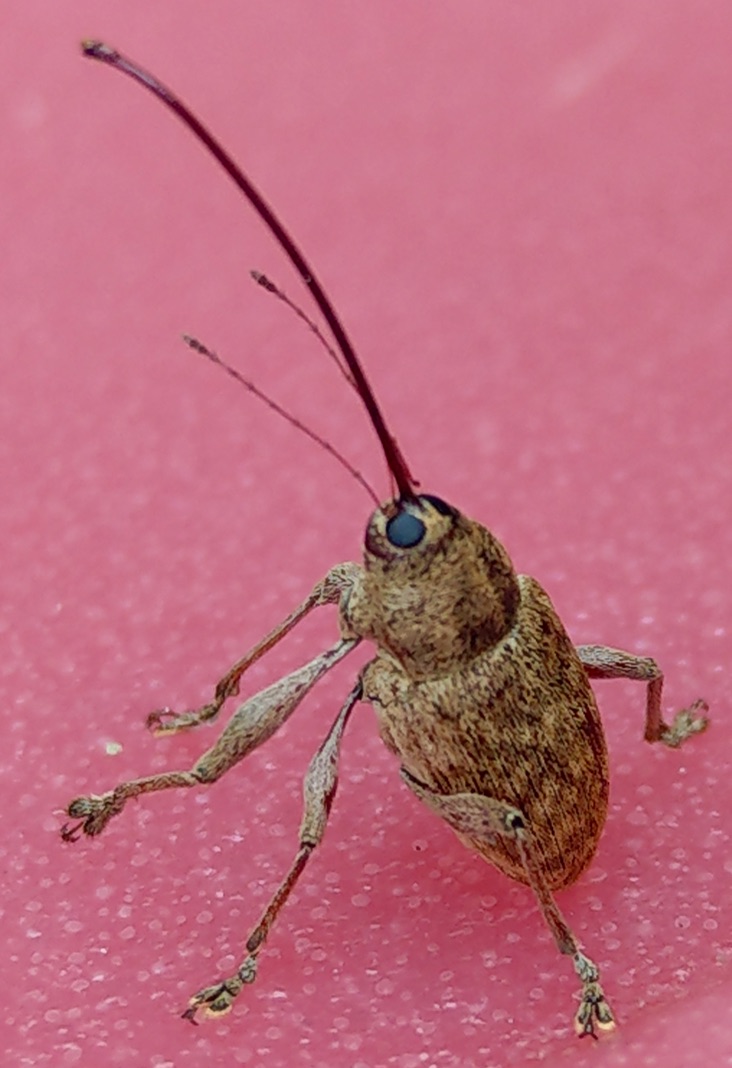 Acorn and Nut Weevil, quite possibly Curculio proboscideus, subfamily Curculioninae, family Curculionidae. □ This little acorn and nut weevil is just adorable and what a profile! The super-long snout is a characteristic of female: She pokes it into acorns, and once she makes the hole, she lays eggs inside. Photographed by: Denise Rulason. Identified by: KnowYourInsects.org. Location: Frankenmuth, Michigan, USA. Date: 31 August, 2017. Denise says, "Interesting bug I have never seen before.... I found her under an oak tree." |
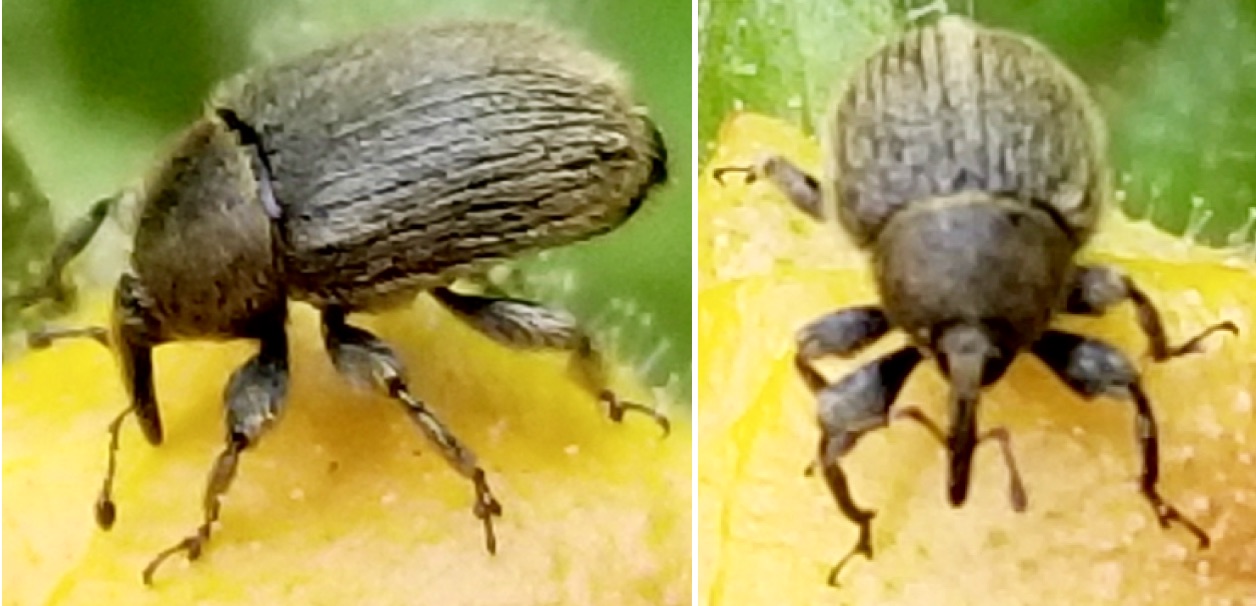 European curculionid weevil, also known as a mullein weevil, Rhinusa tetra, subfamily Curculioninae, family Curculionidae. □ The European curculionid weevil is native to Europe, and parts of Asia and Africa, but is also now found in North and South America. It also goes by the name mullein weevil, because it eats the plant common mullein (Verbascum thapsus), a plant with large, soft, and fuzzy leaves (also sometimes jokingly called nature's toilet paper). □ Characteristics of the European curculionid weevil include the covering of short hairs, and the beefy-looking femora (thighs). Photographed by: Dave Delman, M.D. Identified by: KnowYourInsects.org. Location: Roslyn, New York, USA. Date: 10 June, 2018. |  Weevil, subfamily Curculioninae. Photographed by: Yanni Petropoulos. Identified by: KnowYourInsects.org. Location: mainland of southwestern Greece. Date: January, 2021. |
 Red palm weevil, Rhynchophorus ferrugineus, subfamily Dryophthorinae, family Curculionidae. □ The red palm weevil comes in a variety of colors (including black with a red stripe), but this rust-colored variation is quite common in Cyprus where this photo was taken. These weevils can grow to about 1.3 inches (3.3 cm) long. Note: The ruler is marked in centimeters (not inches). Photographed and identified by: Katherine Toumbourou. Location: Nicosia, Cyprus. Date: 16 May, 2018. Katherine says, "Your wonderful website helped me identity a bug that flew through my window today." KnowYourInsects.org says, "Wonderful! And great job with the identification, Kath!" |  Red palm weevil, Rhynchophorus ferrugineus, subfamily Dryophthorinae, family Curculionidae. □ The red palm weevil is native to southern Asia and over to Papua New Guinea and nearby islands, but has spread to other warm climates as well. For instance, it was first reported in southern California in 2010, but after a concerted effort to find and get rid of it, it was declared eradicated in January 2015. Photographed and identified by: Katherine Toumbourou. Location: Nicosia, Cyprus. Date: 16 May, 2018. Katherine says, "They're a real problem both here and in the Middle East, and are classified as pests." | 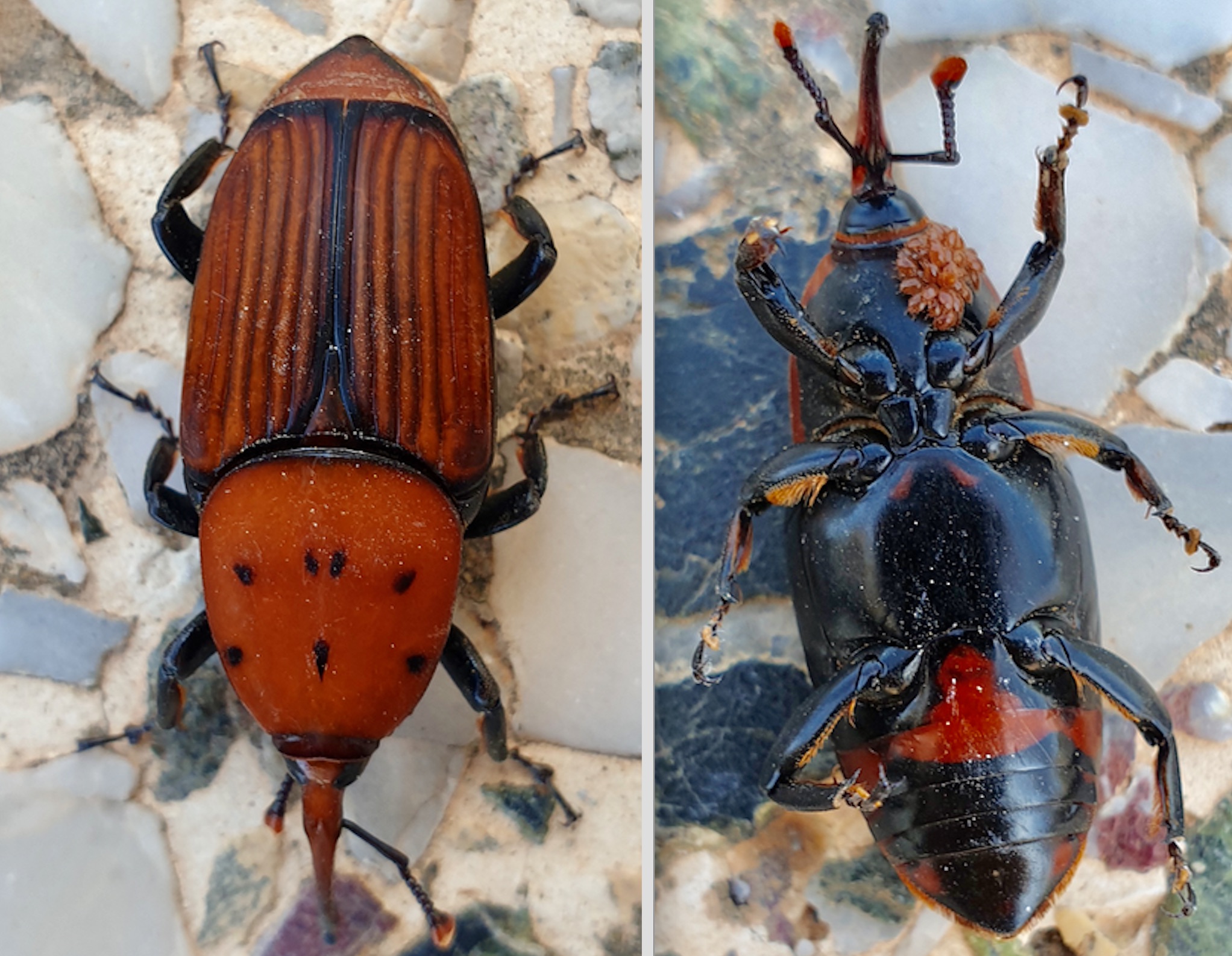 Red palm weevil, Rhynchophorus ferrugineus, subfamily Dryophthorinae, family Curculionidae. □ These photos show the top and bottom views of this red palm weevil. Some individuals have fewer spots on the thorax, as shown in the other photos of this species on this page. Notice the tiny red balls up near the head in the bottom view — Those are phoretic mites (related to ticks and spiders) that use insects like buses: They climb aboard, take a ride, and hop off. Photographed and identified to order by: Yanni Petropoulos. Location: On the mainland, Southwest Greece. Date: 19 April, 2020. Yanni says, "Took a photo of this beautiful insect today (it visited our balcony). When I checked on it again after 5 minutes, it was upside down and pretending dead! I flipped it and after a while started moving again." |
 Palmetto weevil, Rhynchophorus cruentatus, subfamily Dryophthorinae, family Curculionidae. □ Considered the largest weevil in North America, the palmetto weevil can grow to about 1.25 inches long (3.1 cm). This species has quite a bit of variability. For instance, this individual has considerable black markings on its head, while others have very little black on their heads, and still others are completely black. For more information on this pretty weevil (and to see some the variation in this species), click here. Photographed by: Jordan Knepper. Submitted by:Doug Knepper. Location: Tampa, Florida, USA. Date: 10 March, 2018. |  Banana stem weevil, Odoiporus longicollis, subfamily Dryophthorinae, family Curculionidae. □ As adults, the banana stem weevil may be 2.3-3.9 cm (1-1.5 inches) long, so they have quite a size range. They are pests of bananas, as well as plantains. Photographed and identified to order by: Rukyya Siddique. Identified to species by: KnowYourInsects.org. Location: Pauri district Uttrakhand, India. Date: 9 June, 2020. |  Sisal weevil, sometimes called an agave weevil, Scyphophorus acupunctatus, subfamily Dryophthorinae, family Curculionidae. □ This weevil is known as a sisal weevil because its host plant is a type of agave called sisal (Agave sisalana), which is often used to make twine or rope. □ Note: This is now listed as part of the subfamily Dryophthorinae, which falls under the family Curculionidae. At one time, the Dryophthorinae was listed as its own family: Dryophthoridae. Photographed by: Carlo Castoro. Identified by: KnowYourInsects.org. Location: St. Thomas, U.S. Virgin Islands. Date: 7 January, 2018. | 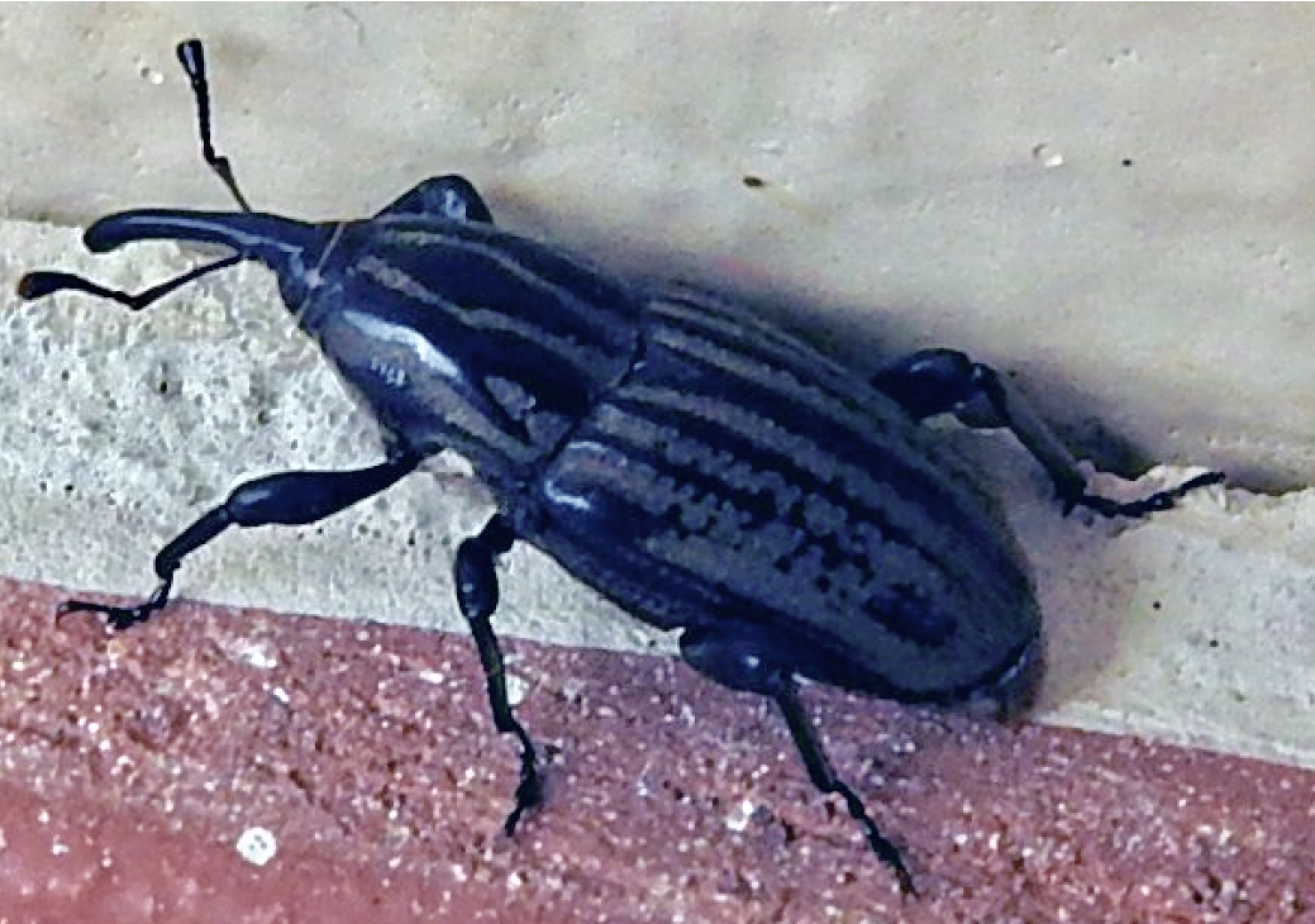 Billbug in the genus Sphenophorus, possibly Sphenophorus latinasus, subfamily Dryophthorinae, family Curculionidae. □ This weevil is known as a billbug, named for its long snout or "bill". Little has been written about Sphenophorus latinasus, which suggests that it has not been found to be a major agricultural or landscaping pest (the squeaky wheel gets the grease!). More attention has been paid to a related species, called a bluegrass billbug (Sphenophorus parvulus) that is a pest in lawns. Photographed and identified to family by: Marv Goldberg. Identified to species by: KnowYourInsects.org. Location: Tamarac, Florida, USA. Date: 25 May, 2020. |
 Rice weevil, Sitophilus oryzae, subfamily Dryophthorinae, family Curculionidae. □ Rice weevils infest rice as well as several other grains, such as wheat and corn, and is sometimes known by the name lesser grain weevil. And be sure to check out the photographer's comment below. Photographed by: Jim Coolbaugh, a retired U.S. Navy infectious disease research microbiologist. Identified by: KnowYourInsects.org. Location: in the sea near Malaysia. Date: 24 November, 2017. Jim says, "We are on a sailboat in Malaysia, and have an infestation of these insects. They are about 2mm long, and they fly." In an update, Jim says they found the source of the infestation: "They are coming from some stored, and thought-sealed pasta.... Out you weevils!" |  Rice weevil, Sitophilus oryzae, subfamily Dryophthorinae, family Curculionidae. □ These close-up photos show excellent detail of this small rice weevil, even the punctate (dimpled) surface of the body and wings. □ Adult female rice weevils will make a little hole in a bit of grain or a bean, deposit an egg inside, and then secrete some soon-hardening fluid over the hole to seal in the egg. The egg hatches, the larva begins eating the contents of the seed or bean, and when it becomes an adult, it chews its way out. Photographed by: Amit Upadhyay. Identified by: KnowYourInsects.org. Location: Navi Mumbai, India. Date: 9 July, 2021. | 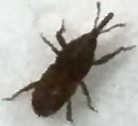 Granary weevil in the genus Sitophilus, subfamily Dryophthorinae, family Curculionidae. □ Granary weevil is a generic name for a number of small weevils that infest grains, such as rice, wheat and corn, as the photographer discovered. Two of the most common are the rice weevil (Sitophilus oryzae) and the wheat weevil (Sitophilus granarius. Photographed by: Robert E. Hilson. Identified by: KnowYourInsects.org. Location: Bath, Ontario, Canada. Date: 17 March, 2021. Robert found this weevil "in my kitchen after opening a frozen pumpkin-pecan pie and leaving it to thaw." He adds, "We also discovered that our pet cat 'Mr. Rusty Roufus' is very good at detecting them." |
 Snout weevil, Cholus zonatus, subfamily Molytinae, family Curculionidae. □ This species of snout weevil has bands across the elytra (forewings) that cover its back. In some individuals, the bands are almost solid color, but in others (as seen here), the bands are more mottled. Photographed and identified by: Ron Andrew. Location: St. Lucia. Date: 31 January, 2021. |  Snout weevil in the genus Neoerethistes, subfamily Molytinae, family Curculionidae. □ Check out the curved snout on this handsome snout weevil. The tan-colored speckles on its back almost look like it was sprinkled with sticky sand. Photographed by: Donna Sánchez. Identified to genus by: Macotulio Soto-Hernández, Instituto de Ecología, México. Location: Malinalco, México. Date: 9 July, 2017. |  Snout weevil, Conotrachelus posticatus, subfamily Molytinae, family Curculionidae. □This snout weevil is mainly brown with two little white dots on the back (look closely to see the dots in this photo). Some individuals will also have a light-colored band near the rear end. This one was on the blue tarp of a jump house: See the comment below. Photographed and identified to family by: Stephen Brown. Identified to species by: KnowYourInsects.org. Location: Houston, Texas, USA. Date: 23 April, 2020. Stephen and his family spotted a whole collection of these weevils in the yard. He says, "We were just amazed at how many we saw after deflating the jump house." |  Unidentified weevil, subfamily Molytinae, family Curculionidae. □ Keys and other identification resources for weevil in India are difficult to come by. The identification of this one, which was photographed on a cucumber, remains unknown. Photographed and identified to family by: Surabhika Panda. Location: Gunupur, Odisha, India. Date: 28 August, 2020. |
 albomarginatusWeevil_Yanni.jpg) White-margined weevil, Lixus albomarginatus, subfamily Lixinae, family Curculionidae. □ The species name of this white-margined weevil is — albomarginatus, which literally means white-margined. It has a flattened and oval silhouette and a slightly downward-curved snout, as do other members of the genus Lixus. □ Note: It is sometimes listed under its older genus name Compsolixus. Photographed by: Yanni Petropoulos. Identified by: KnowYourInsects.org. Location: mainland of southwestern Greece. Date: 30 April, 2020. |  Weevil in the genus Brachycerus, possibly Brachycerus rufipes, subfamily Brachycerinae, family Curculionidae. □ Weevils in this genus — Brachycerus — have sculpted backs. This one is reminiscent of an alligator. Most weevils have noticeably elbowed antennae, but this species has an unusual arched shape to each of its antennae. Photographed by: Yanni Petropoulos. Identified by: KnowYourInsects.org. Location: mainland of southwestern Greece. Date: 30 April, 2020. |  Rose curculio, Merhynchites bicolor, subfamily Rhynchitinae, family Curculionidae. □ The rose curculio is mainly brick-red in color, but with black legs and a long, black proboscis. Another feature of this weevil is its pair of antennae. Most other weevils have antennae that are elbowed and can bend, but the rose curculio has straight antennae (no elbow, no bending). Photographed by: Dave Delman, M.D. Identified by: KnowYourInsects.org. Location: Roslyn, New York, USA. Date: 10 June, 2018. |  Weevil, family Curculionidae. □ KnowYourInsects.org has not been able to identify this weevil. If you recognize it, please let us know! Photographed by: Anne Bannatyne. Identified to family by: KnowYourInsects.org. Location: west Scotland, UK. Date: 15 August, 2021. Anne found this weevil along a coastal path. |
Brentidae, the primitive weevils
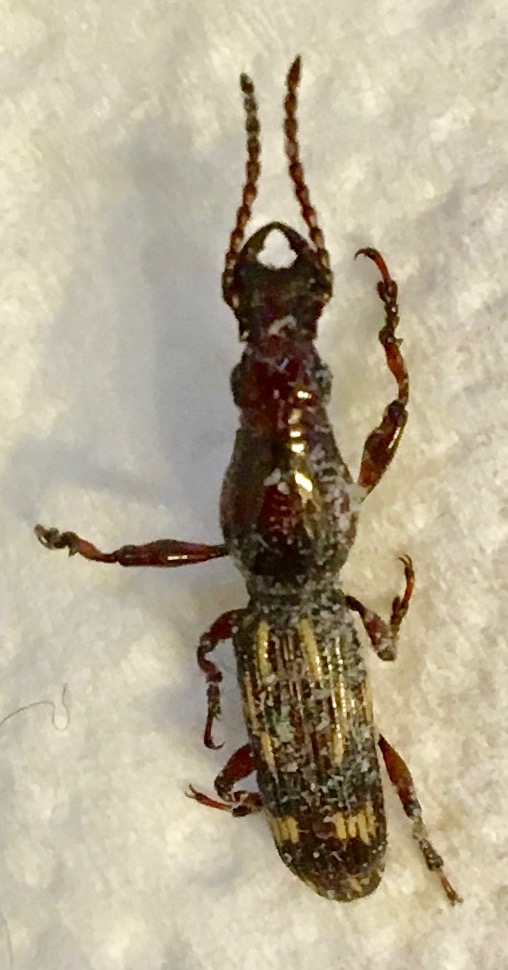 Brentid weevil, also known as an oak timberworm weevil, male, Arrhenodes minutus, subfamily Brentinae, family Brentidae. □ To tell male from female in brentid weevils, look at the mouthparts. This male has a rather robust pair of jaws, whereas the female has an elongate, tube-shaped beak. Photographed by: Ray Chin. Identified by: KnowYourInsects.org. Location: Toronto, Canada. Date: 7 January, 2018. |  Brentid weevil, also known as an Oak Timberworm Weevil, male, Arrhenodes minutus, subfamily Brentinae, family Brentidae. □ The brentid weevil is sometimes called an oak timberworm weevil because its larvae look rather like worms and will bore into wood, especially oak. Photographed by: Mary Freelove. Identified by: entomologist E. Richard Hoebeke with the University of Georgia Extension. Thank you, Rick! Location: northern Georgia, USA. Date: 30 April, 2016. |  Brentid weevil, also known as an oak timberworm weevil, male, Arrhenodes minutus, subfamily Brentinae, family Brentidae. □ This brentid weevil has a little less of the yellow markings on its elytra (the hardened wings covering its abdomen) than is typical of this species. Photographed and identified to order by: Jaymie Miller. Identified to species by: KnowYourInsects.org. Location: middle Tennessee, USA. Date: 19 May, 2019. |  Brentid weevil, also known as an oak timberworm weevil, female, Arrhenodes minutus, subfamily Brentinae, family Brentidae. □ This is the female brentid weevil, which has jaws with a much different shape than those of the male (pictured previously). She uses her long mouthparts to dig tiny tunnels into the wood of oaks and other trees, lays one egg in each hole, and then seals it up with a glue-like secretion mixed with frass (feces). The larvae hatch and feed on the wood until they become adults. Photographed by: Gina Marie. Identified by: KnowYourInsects.org. Location: New Jersey, USA. Date: 9 June, 2021. |
Lymexylidae, the ship timber beetles
 Ship timber beetle, family Lymexylidae. □ The ship timber beetle often holds its abdomen in a curled-up position as seen here. Notice the blue eyes on this one. Photographed by: Sarah Park. Identified by: KnowYourInsects.org. Location: Bangui, Central African Republic Date: 16 August, 2021. Sarah says, "When I tried to get it to go on a piece of paper so I could bring it inside to get a better look at it, it clung to the screen, and flapped its mini-dragonfly sort of wings." |  Ship timber beetle, family Lymexylidae. □ Note the very unusual — and huge — eyes on this ship timber beetle. The bottom photo shows how long this beetle's abdomen is. Photographed by: Jorge "Izzy" Irizarry. Identified by: KnowYourInsects.org. Location: Puerto Rico. Date: 29 September, 2015. Jorge says it "was very loud when flying. It died, but before it did it laid around 100 eggs." |  Hatching eggs of the ship timber beetle, family Lymexylidae. □ Although they are called ship timber beetles, these insects will bore into living trees in addition to the wood of ships and other structures. Photographed by: Jorge "Izzy" Irizarry. Identified by: KnowYourInsects.org. Location: Puerto Rico. Date: 29 September, 2015. |
Trogossitidae, the bark-gnawing beetles
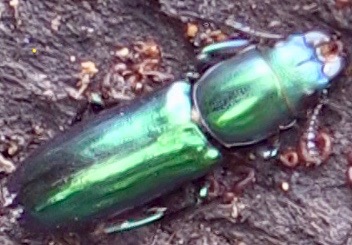 Bark-gnawing beetle, Temnoscheila chlorodia, subfamily Trogossitinae, Trogossitidae. □ A feature of this species of bark-gnawing beetle is the little crease on its head between the eyes. Photographed and identified by: Robert E. Carpenter. See Robert's slow-motion insect videos here. Location: Kerrville, Texas, USA. Date: 15 December, 2016. Robert says, "Found under bark of dead Box Elder Tree." |  Bark-gnawing beetle, Temnoscheila chlorodia, subfamily Trogossitinae, Trogossitidae. □ This bark-gnawing beetle has a metallic appearance, and may be green, purplish-black, or bluish-black. Photographed by: Aven Wright McIntosh. Submitted by: Preston French. Identified by: KnowYourInsects.org. Location: Eugene, Oregon, USA. Date: 25 May, 2020. |  |  |
Cleridae, the checkered beetles
 Red-legged ham beetle, Necrobia rufipes, subfamily Korynetinae, family Cleridae. □ A small insect at just 4.5 mm long (less than 0.2 inches), the red-legged ham beetle has a metallic blue-green back and reddish-brown to orange legs. Its antennae are also reddish-brown to orange with black, clubbed tips. This little beetle eats dried fish, and also feeds on some fly larvae, according to the Food and Agriculture Organization of the United Nations. Photographed by: Suzanne Cuomo<. Identified by: KnowYourInsects.org. Location: Wyckoff, New Jersey, USA. Date: 22 March, 2019. | 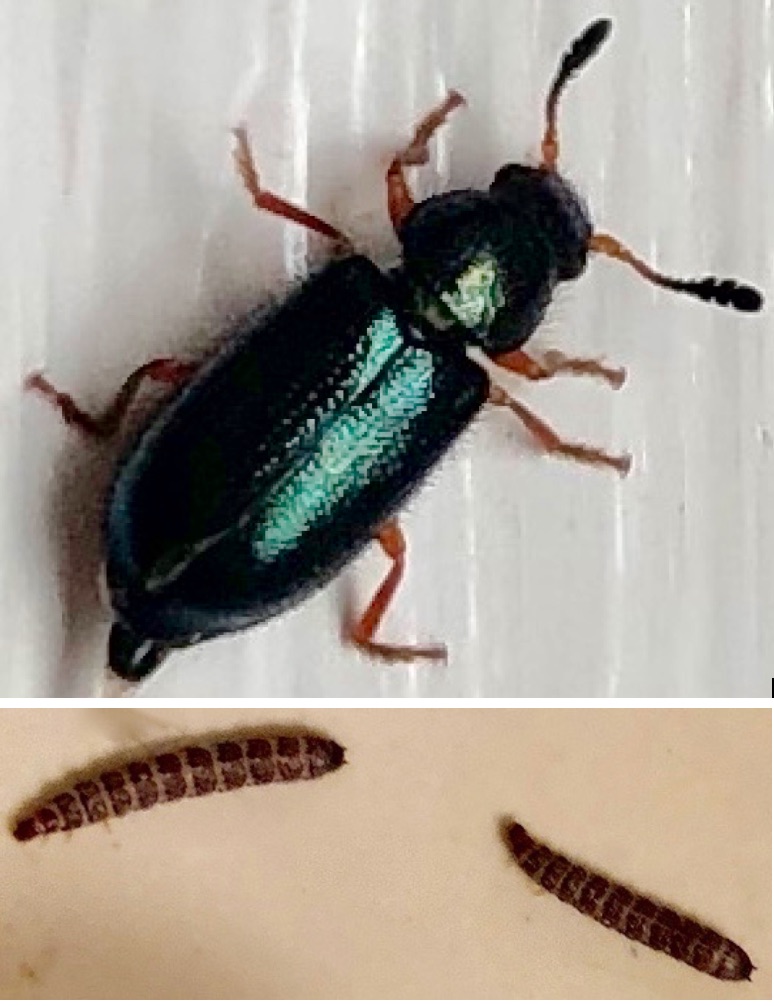 Red-legged ham beetle, Necrobia rufipes, subfamily Korynetinae, family Cleridae. □ The photographer reports that she found larvae/grubs of the red-legged ham beetle in a bag of dog food, and the adults nearby. These beetles eat meat products, particularly dried meat, and have been known to get into dog food and also pet stores, and are pests in natural history museums, where they nibble at taxidermy mounts. Photographed by: Gina Mastrogiovanni. Identified by: KnowYourInsects.org. Location: New Jersey, USA. Date: 16 September, 2019. |  Ant beetle, also known as a European red-bellied clerid, Thanasimus formicarius, subfamily Clerinae, family Cleridae. □ The ant beetle has strong jaws perfect for its diet: It crunches through the carapace of adult bark beetles, often first dismembering them so they cannot run away. It will also eat the grubs of bark beetles. As the photographer found (see the comment below), it will also use its jaws in defense. This species, shown here in dorsal and ventral (top and bottom) views, has a distinctive and quite handsome pattern on its elytra (the pair of wings covering its back). Photographed by: Howard Toon. Identified by: KnowYourInsects.org. Location: Hathern, England, UK. Date: 22 March, 2019. Howard says, "It is about 10mm long, and I just felt a bite or a sting on my neck and caught this insect." |
Melyridae, the soft-winged flower beetles
Anthicidae, the antlike flower beetles
 Soft-winged flower beetle, Anthocomus equestris, subfamily Malachiinae, family Melyridae. □ The soft-winged flower beetle is an import to North America. It is a Eurasian species. Photographed by: Susan Reinhardt. Identified by: KnowYourInsects.org Location: Bel Air, Maryland, USA. Date: 3 June, 2017. Susan says, "This is an enlarged photo taken with my iPhone. To the naked eye it is much smaller and is long and thin." |  | 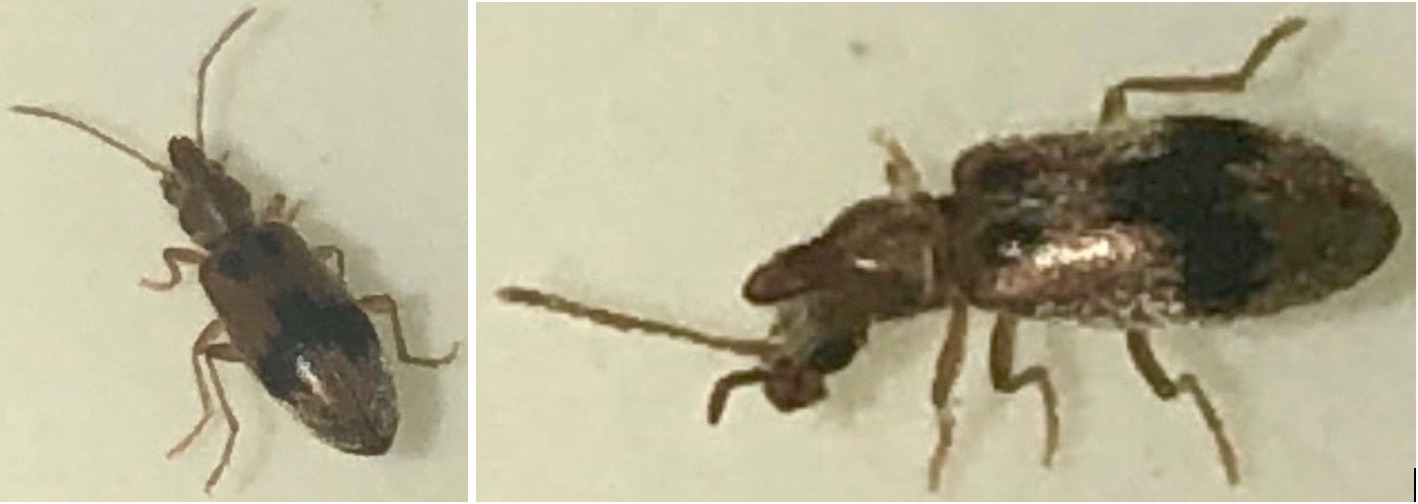 Monoceros beetle, Notoxus desertus, subfamily Notoxinae, family Anthicidae. □ The "horn" projecting forward over the head is a giveaway for the monoceros beetle. This beetle is one of the group often described as ant-like. In fact, the submitter described it as about the size of a pea or "small like an ant." This beetle has two black spots on its back, plus a V-shaped band. See the description in the comment below. Photographed by: Autumn Highstreet. Submitted by: J. H. Highstreet. Identified by: KnowYourInsects.org. Location: Michigan, USA. Date: 17 June, 2019. J. H. says, "We have named it the Minecraft bug, since it looks like the creeper face in minecraft." |
Tenebrionidae, the darkling beetles
 Darkling beetle in the genus Ocnodes, possibly Ocnodes scabricollis, subfamily Pimeliinae, family Tenebrionidae. Darkling beetle in the genus Ocnodes, possibly Ocnodes scabricollis, subfamily Pimeliinae, family Tenebrionidae.□ Like other members of this family, this darkling beetle's antennae each have 11 segments; each of its big compound eyes are notched by a ridge (visible between the eye and the antenna in this photo); and it has a 5-5-4 arrangement, which means that the front leg tarsus (the last part of the leg before the final claw) has five segments, the middle leg tarsus has five segments, and the hind leg tarsus has four segments. Photographed and identified to order by: David Meredith. Identified to tribe (Sepidiini) by: KnowYourInsects.org. Identified to genus and tentative species by: Marcin Jan Kamiński, Museum and Institute of Zoology of the Polish Academy of Sciences. Thank you, Dr. Kamiński! Location: Botswana, Africa. Date: November 2019. | 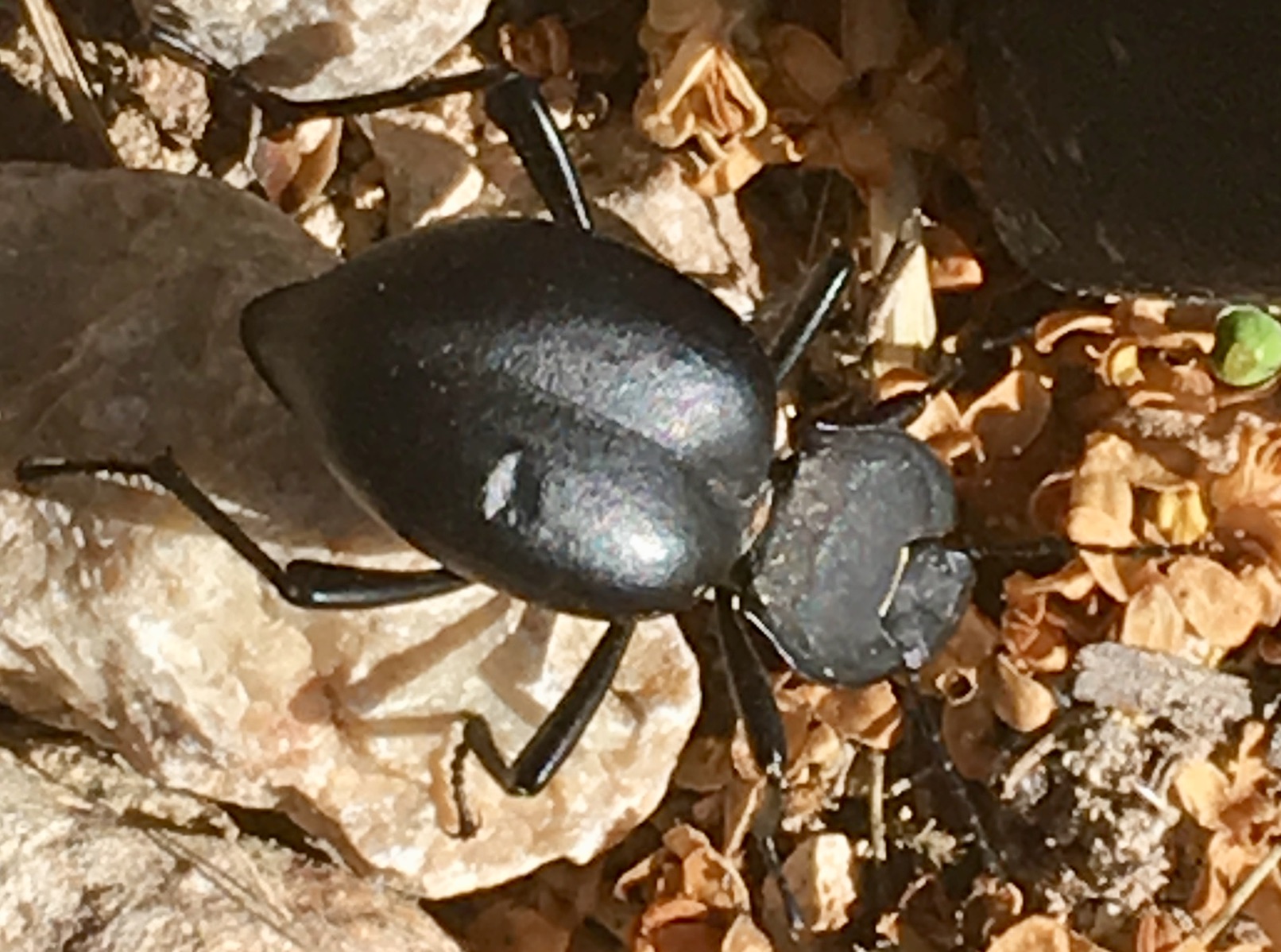 Darkling beetle, Morica planata, subfamily Pimeliinae, family Tenebrionidae. □ Most beetles raise their hard forewings (called elytra), unfold the pair of membranous flight wings that lie underneath, and fly away. With this species of darkling beetle, however, the elytra are fused, so they cannot fly. Notice this species' characteristic flattened pronotum behind the head. Photographed and identified to order by: Sanne Houwing. Identified to species by: KnowYourInsects.org. Location: Tibi, Valencia, Spain. Date: 14 June, 2018. Sanne says, "We encountered this flatheaded fellow at breakfast in Spain." |  Darkling beetle in the subfamily Pimeliinae, family Tenebrionidae. □ Although it may look a bit like a squirrel storing nuts in its cheeks, the exaggerated sideward extensions of this darkling beetle's head are a permanent part of its overall impressive structure. Photographed by: Quintin Naude. Submitted and identified to suborder by: Dawid Naude (Quintin's father). Location: Kuzuko Lodge, Eastern Cape, South Africa. Date: 17 February, 2019. KnowYourInsects.org loves it when families work together! Great job, Quintin and Dawid! |
 Desert ironclad beetle, Asbolus verrucosus, subfamily Pimeliinae, family Tenebrionidae. □ The desert ironclad beetle is sometimes called a blue death-feigning beetle because it has a bluish tint in the right lighting, and because of its interesting defensive strategy: it rolls onto its back, sticks its legs out, and becomes rigid. Its tough exoskeleton plus the lack of movement usually makes predators lose interest, and once the coast is clear, the beetle loosens up, flips over, and continues on its way. □ Although its common name is desert ironclad beetle, it is actually in the darkling beetle family (Tenebrionidae), and is not related to the ironclad beetle family Zopheridae. Photographed by: Vanessa and Mike Perez. Location: south of Phoenix, Arizona, USA. Date: 26 September, 2020. Vanessa and Mike say, "We found this in our backyard and have never seen anything like it." |  |
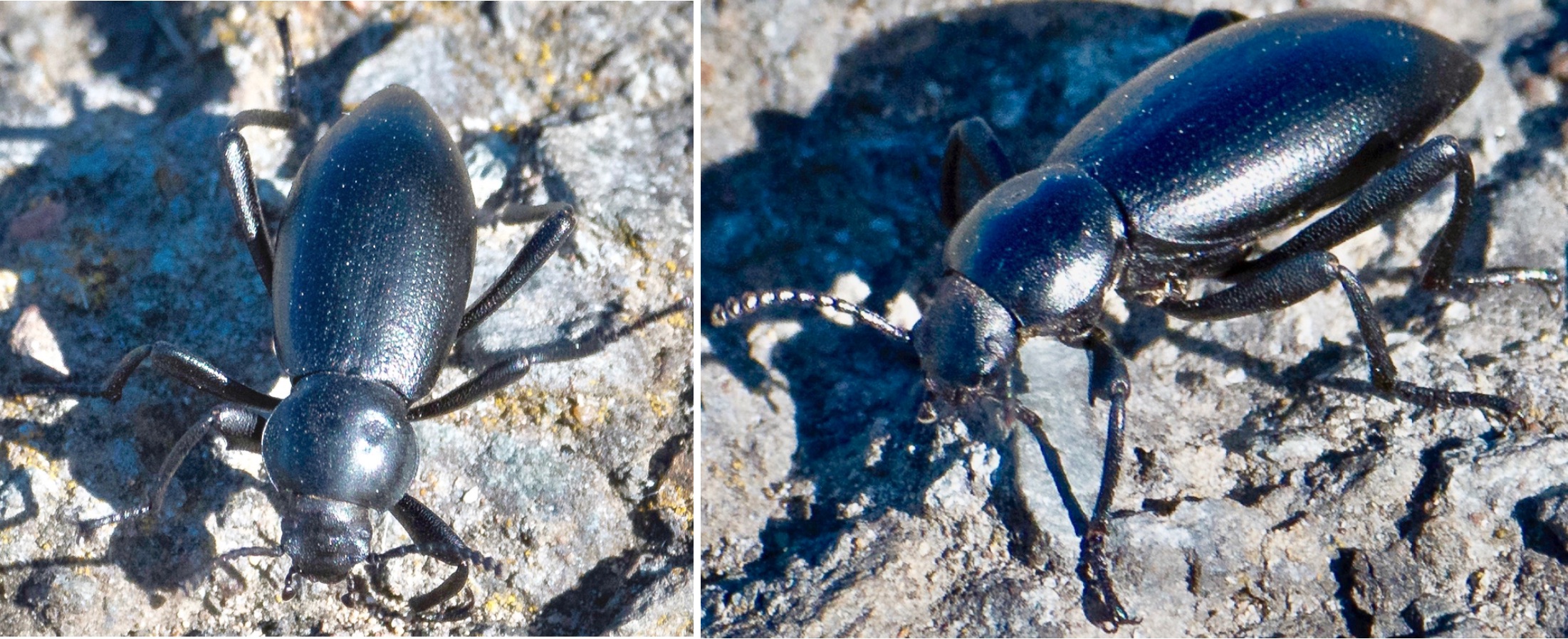 Darkling beetle, probably in the genus Eleodes, subfamily Tenebrioninae, family Tenebrionidae. □ Darkling beetles are sometimes called clown beetles, because of their habit of running around rather crazily (see the photographer's comment below) and sometimes doing a headstand when they are threatened (note: another group of beetles is also known as clown beetles &mash; see the section on Histeridae). They are also sometimes called stink beetles because one of their defensive mechanisms is to emit a smelly secretion from their rear ends. Photographed and identified to order by: Thomas Langhans. Identified by: KnowYourInsects.org. See Thomas's full-size images here and here. Location: city of South San Francisco, county of San Mateo, California, USA. Date: 28 April, 2017. Thomas says, "This one was in a real hurry to get somewhere. It was large, I can only guess now, perhaps about 4 cm (1.6 inches)." |  Flour beetle in the genus Tribolium, subfamily Tenebrioninae, family Tenebrionidae. □ There are several species of flour beetle, and the two that are especially common in houses just about everywhere in the world are the red flour beetle (Tribolium castaneum) and the confused flour beetle (Tribolium confusum. These tiny beetles look almost identical, and both feed on flour and other grains people store in the pantry. More information about these beetles is available here. Photographed by: Fatima Amer. Identified by: KnowYourInsects.org. Location: Dammam, Eastern Province, Saudi Arabia. Date: 18 March, 2019. Fatima says it was about 4mm (0.15 inches) long. She has discovered a few in her apartment. KnowYourInsects.org says, "They are definitely good and sneaking into homes!" |  |
 Frantic surface beetle in the genus Zophosis, subfamily Tentyriinae, family Tenebrionidae. □ As their common name suggests, frantic surface beetles are very busy little insects. They like dry habitats, and are active during the day, notably in the hot sun when just about every other living thing is hidden away. According to one journal article, they will ll stay in the heat as long as they can — until their body temperature gets up to near-lethal levels — and only then will seek a shady spot to cool off. Spotted by: Declan Rademan. Photographed by: Neil Rademan. Identified by: KnowYourInsects.org. Location: Clanwilliam, Western Cape, South Africa. Date: 23 November, 2020. Neil says his son Declan had to chase this little beetle, which was "running around frantically." He adds, "(Declan) got all excited about this tiny blue beetle." KnowYourInsects.org says, "We are excited too! Great find!" |  | 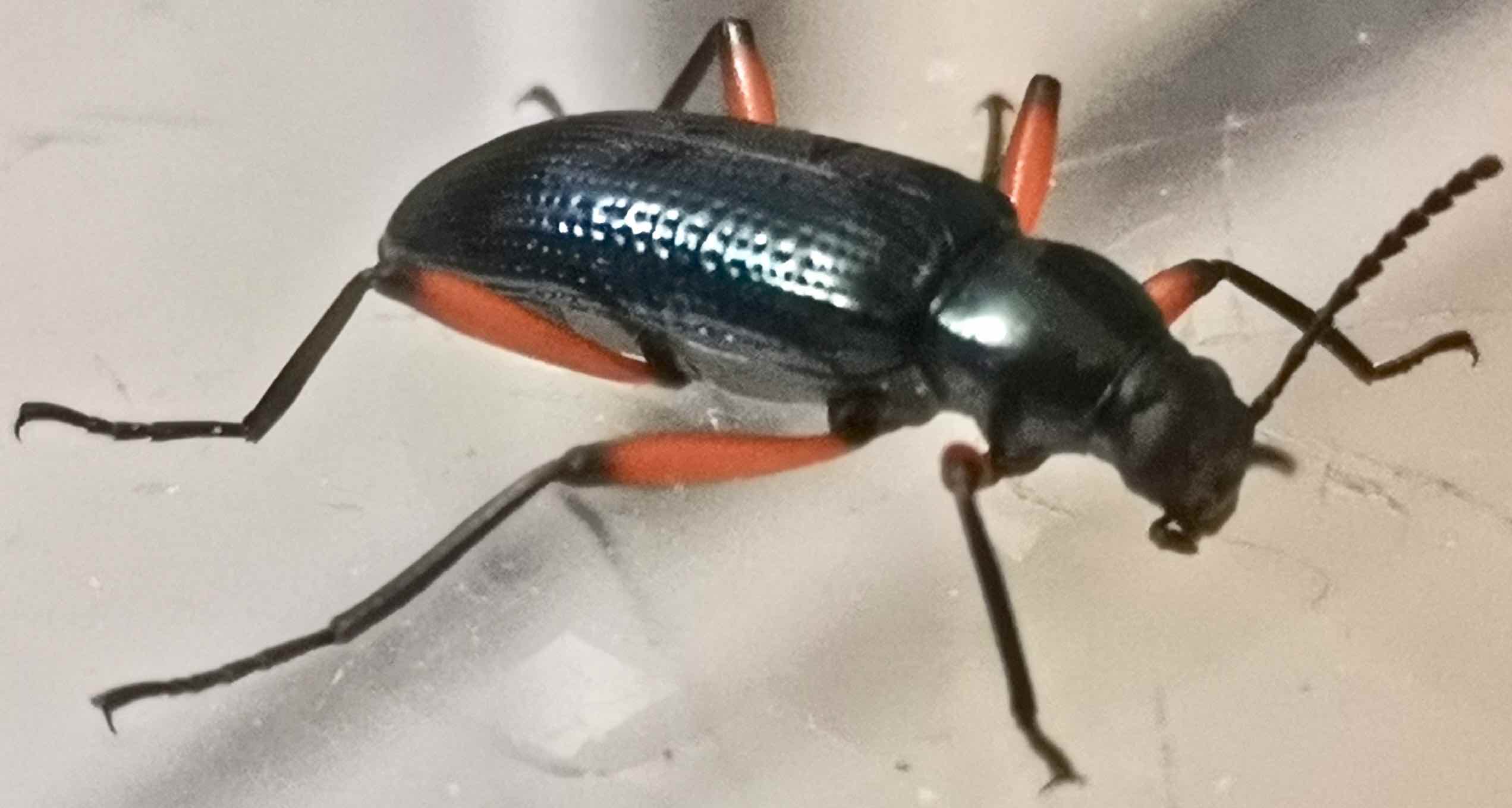 Darkling beetle, family Tenebrionidae. □ Many beetles, including darkling beetles, are identified in part by the pattern of segments in their tarsi (the last segment of their legs, or their "feet". To determine this, count the segments in the front, middle and hind legs, which in this case is 5-5-4 (five in the front two legs; four in the hind leg). All of the species in the family Tenebrionidae have this 5-5-4 tarsal pattern. Photographed by: Jessy Phuah. Identified by: KnowYourInsects.org. Location: Kuala Lumpur, Malaysia. Date: 18 September, 2020. Jessy says it was about an inch (2.5 cm) long. |
Meloidae, the blister beetles
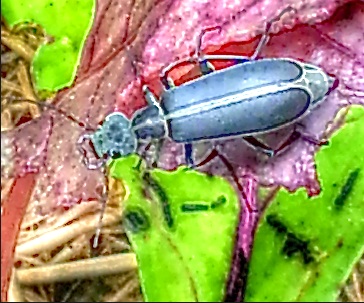 Margined blister beetle, Epicauta pestifer, subfamily Meloinae, family Meloidae. □ The thorax and each elytra (the hardened forewings that cover its abdomen) of this margined blister beetle have light-colored outlines or margins. This beetle can do some damage to several garden plants, including potatoes and tomatoes. Photographed by: Anonymous. Identified by: KnowYourInsects.org. Location: Adrian, Michigan, USA. Date: July, 2014. |  Blister beetle in the genus Epicauta,, possibly the spotted blister beetle Epicauta maculata, subfamily Meloinae, family Meloidae. □ The spotted blister beetle is pale green, gray, or gray-beige with many small black polka dots. Several species in this genus (Epicauta) look very similar. Photographed and identified to genus by: Tommy Vick. Identified to tentative species by: KnowYourInsects.org. Location: Fort Davis, Texas, USA. Date: 29 June, 2018. |  Yellow-crescent blister beetle, Pyrota insulata , subfamily Meloinae, family Meloidae. □ The yellow-crescent blister beetle often has thin slashes of orange toward the base of its two elytra (the hardened forewings that cover its back) and a orange spot at the tip of each elytra, but this one is a slightly different form with an orange-encircled spot at the base of each of its elytra, and no separated orange spot at the tip. To see the variety in this species, click here (a Texas Entomology website). Photographed and identified by: Brenda Kirschner. Nice job on the ID, Brenda! Location: Stamford, Texas, USA. Date: 25 May, 2020. |  Bronze blister beetle, Lytta polita, subfamily Meloinae, family Meloidae. □ This bronze blister beetle has beautiful shiny bronze elytra (the wings covering its abdomen), and a purple-tinged thoras and head, and black and reddish-orange legs. It is called a blister beetle because it will release some blood (called haemolymph) when it is agitated, and contact with the haemolymph can cause a reaction — non-painful, temporary blisters — in people. Photographed by: Lisa Nolan. Identified by: KnowYourInsects.org. Location: northern Florida, USA. Date: 30 December, 2019. |
 Nuttall's blister beetle, Lytta nuttalli, subfamily Meloinae, family Meloidae. □ Nuttall's blister beetle is a gorgeous beetle with a metallic head, thorax and abdomen; and purple elytra (the forewings). And it is large — see the photographer's comment below. This species eats rapeseed, which is a yellow-flowered crop often grown in Canada to make into cooking oil. Photographed by: April Roch. Identified by:KnowYourInsects.org. Location: near Lloydminster in Alberta, Canada. Date: 28 June, 2019. April says, "I saw this beautiful beetle in the early evening. It was about 2 inches long (5 cm) and that is not counting the antennae!" | 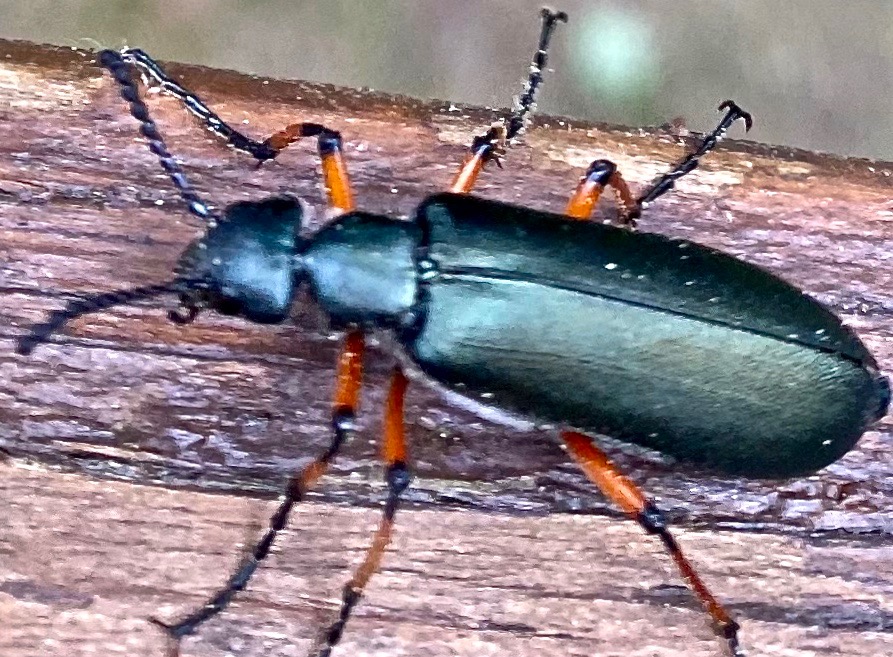 Blister beetle, Lytta sayi, subfamily Meloinae, family Meloidae. □ Two species of blister beetle look almost identical: Lytta aenea and Lytta sayi. Lytta aenea has reddish-brown elytra (the wings covering its back), and in fact its species name of aenea comes from the Latin word aeneous, which means the color/luster of brass. Lytta sayi typically has wings that are black, as seen here. Photographed by: Eric Besecker. Identified by: KnowYourInsects.org. Location: northern Vermont, USA. Date: 18 June, 2021. Eric says he saw a different type of beetle in this family a couple of years earlier, but it was much larger. |  Blister beetle, Lytta aenea, subfamily Meloinae, family Meloidae. □ This larvae of this species of blister beetle latch onto certain types of bees, which carry the larvae back to their nests. There, the larvae feed on the eggs and larvae of the bees. Adult blister beetles can often be found on oak and beech trees, as well as a number of fruit trees. Photographed and identified to genus by: John Hoagland. Nicely done, John! Identified to species by: KnowYourInsects.org. Location: Louisville, Kentucky, USA. Date: 12 April, 2021. John says, "Found three this morning." |
 Oil beetles, mating pair, in the genus Meloe, possibly Meloe impressus, subfamily Meloinae, family Meloidae. □ The photographer described the larger oil beetle (the female) as being approximately 1.5 inches (3.8 cm) long, and the smaller one (the male) at about 1.25 inches (3.2 cm) long. The size along with the flared antennal segment about halfway down each of his antennae suggests they are the species Meloe impressus. See the photographer's comments below. Photographed and identified to genus by: Susan Anderson. Identified to tentative species by: KnowYourInsects.org. Location: Bethesda, Maryland, USA. Date: 25 November, 2018. Susan found this pair in her garden. She says they "seemed green in sunlight." | 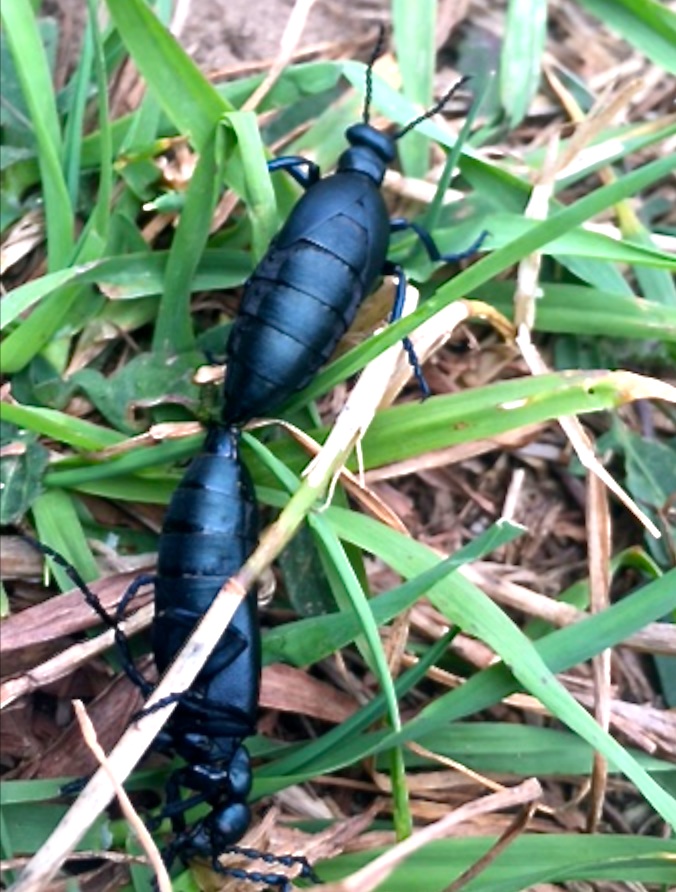 Oil beetle in the genus Meloe, subfamily Meloinae, family Meloidae. Photographed by: Chris G. Briggs Sr. Identified by: KnowYourInsects.org. Location: northern Muskegon County, Michigan, USA. Date: 5 October, 2015. Craig says, "A lone one was cutting through a grass blade with short, strong mandibles." | 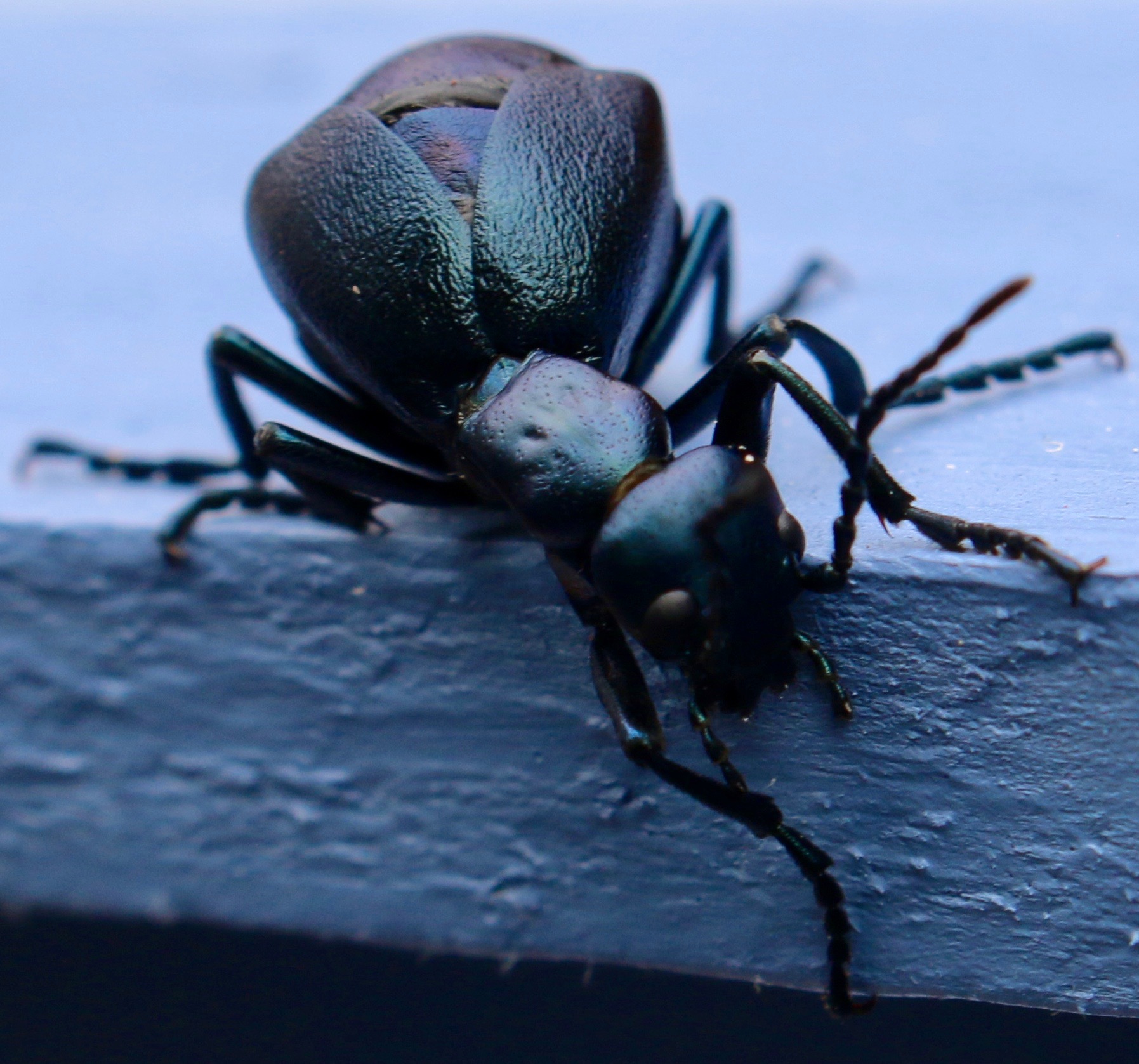 Oil beetle, Meloe angusticollis, subfamily Meloinae, family Meloidae. Photographed by: Alexandra Scheumann, WoodHeaven Photography. Identified by: KnowYourInsects.org. Location: Hurleyville, Sullivan County, New York, USA. Date: 20 October, 2017. |
 Oil beetle in the genus Meloe, subfamily Meloinae, family Meloidae. □ Although it may look from the top view of this oil beetle that the last pair of legs sprouts from the abdomen, all six of its legs arise from the thorax. (This is true of all adult insects.) Photographed and identified by: Josh Bozarth. Location: Proud Lake Recreation Area, Wixom, Michigan, USA. Date: 31 October, 2018. |  Oil beetle in the genus Meloe, subfamily Meloinae, family Meloidae. □ When disturbed, oil beetles release fluid from their joints (as seen here). It is sometimes called "reflexive bleeding." The fluid is distasteful to potential predators, so it serves a protective function. Another feature of oil beetles is that the thorax is considerably narrower than the abdomen, and also narrower than the head. Photographed by: Pat (no last name given). Identified by: KnowYourInsects.org. Location: Belding, Michigan, USA. Date: 7 October, 2014. | 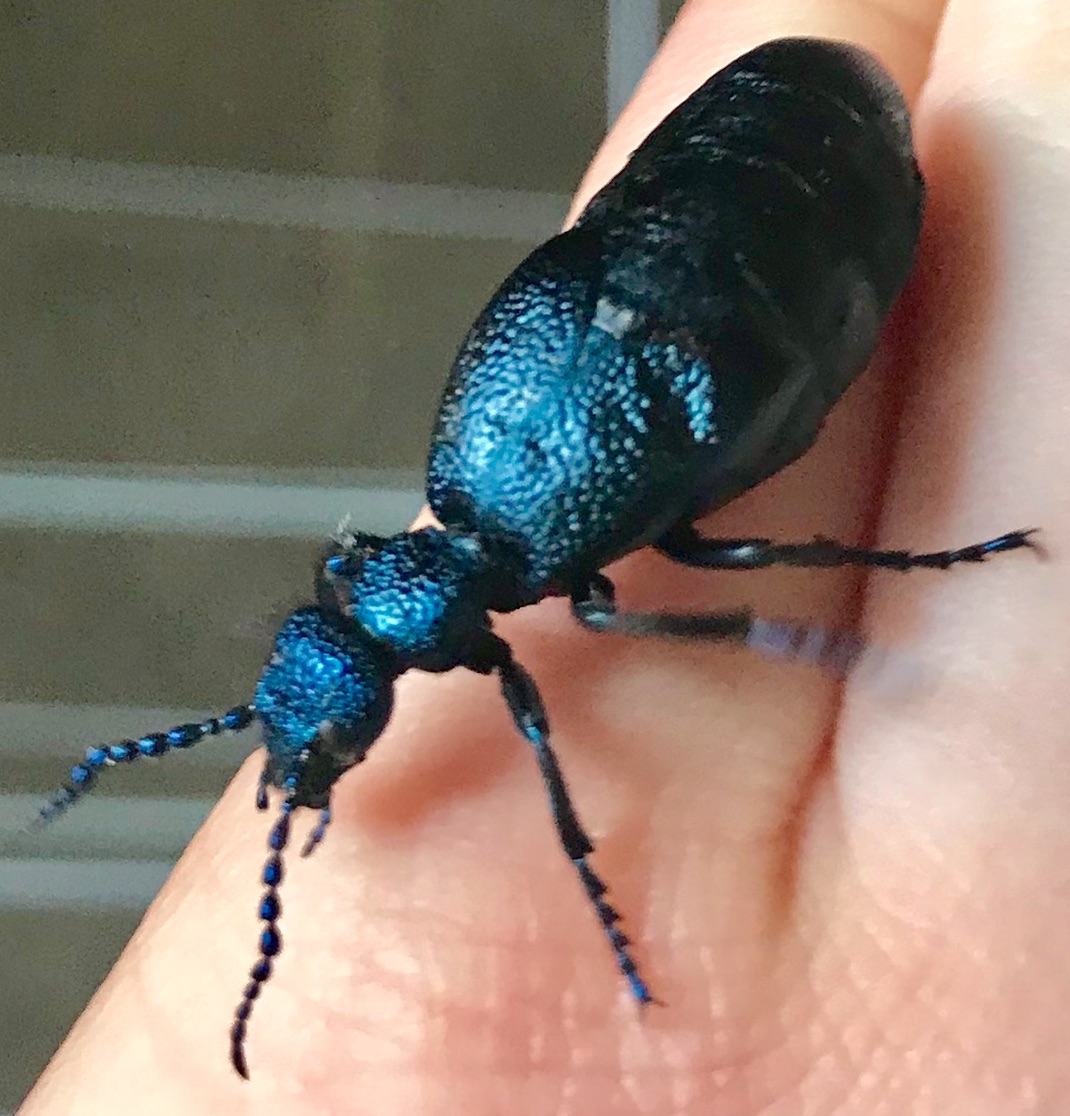 Oil Beetle, probably Meloe proscarabaeus, subfamily Meloinae, family Meloidae. □ This bright blue-colored oil beetle is tentatively identified as the species Meloe proscarabaeus by oil beetle experts Carolina Bravo and Mario García-París, but Dr. Bravo notes that only a good view of the mesonotum (the middle segment of the thorax) can rule out the almost identical species Meloe violaceus. Photographed and identified as an oil beetle by: Matthew Rodda. Identified to genus and tentative species by: Carolina Bravo of the National Museum of Natural History of Spain and Mario García-París of the Spanish National Research Council. Thank you, Drs. Bravo and García-París! Location: Adjara, country of Georgia (between Western Asia and Eastern Europe). Date: 4 March, 2018. Matthew found it in a rainforest. | 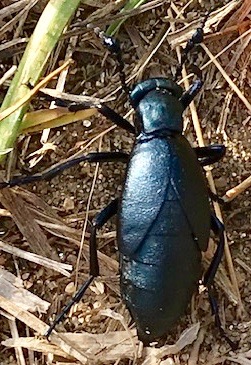 Oil beetle in the genus Meloe, subfamily Meloinae, family Meloidae. □ The photographer described this oil beetle beautifully: "black with a dashing turquoise sheen and short elytra." Its body is about 3/4 inches (1.9 cm) long. □ Males release a noxious fluid from their joints, and that fluid contains cantharidin. Cantharidin had been used historically to make Spanish fly, an aphrodisiac. Photographed and identified to order by: Victoria Meller. Identified to genus by: KnowYourInsects.org. Location: Kensington Metropark, Milford Township, Michigan, USA. Date: 27 September, 2020. |
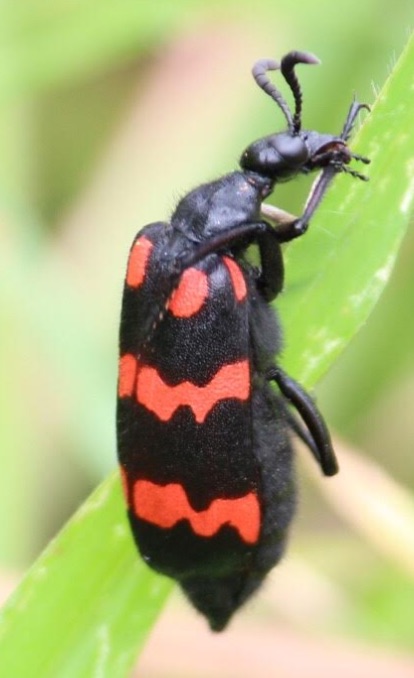 Orange blister beetle, Hycleus pustulata, subfamily Meloinae, family Meloidae. □ The orange blister beetle — and other blister beetles in this family — actually do cause blistering if they are handled. Note: This species is sometimes listed as in the genus Mylabris. Photographed by: Ajay Antony. Identified by: KnowYourInsects.org. Location: Tamilnadu, India. Date: 24 May, 2017. |  Orange blister beetle, Hycleus pustulata, subfamily Meloinae, family Meloidae. □ Notice the jaws and palps on this orange blister beetle. The palps are the small structures just below the jaws (they almost look like little antennae). The palps have sensory receptors on them, so they help the beetle to taste. Note: This species is sometimes listed as in the genus Mylabris. Photographed by: Shefali Chaudhari. Identified by: KnowYourInsects.org. Location: Gujarat, India. Date: 13 July, 2020. |  Iron cross blister beetle, Tegrodera aloga), subfamily Meloinae, family Meloidae. □ The iron cross blister beetle has an interesting life cycle: The females lay eggs in buds of a Palo Verde tree, and by the time the flower opens, the eggs begin hatching into tiny larvae that then hitch a ride on a visiting digger bee (a type of bee that lives in underground nests) to get to its nest. There, the larvae eat the pollen and nectar the bees have collected, as well as bees' offspring. Once the beetles become adults, they fly off to mate and start the cycle all over again. Photographed by: Sandy Moody. Identified by: KnowYourInsects.org. Location: Mesa, Arizona, USA. Date: 12 May, 2021. |  Blister beetle, species unknown, family Meloidae. □ KnowYourInsects.org could determine the species of this striking blister beetle — if you know the genus or species, please let us know! Photographed by: Ajay Antony. Identified by: KnowYourInsects.org. Location: Tamilnadu, India. Date: 24 May, 2017. |
Oedemeridae, the false blister beetles
 Wharf borer, Nacerdes melanura, subfamily Oedemerinae, family Oedemeridae. □ wharf borer larvae (grubs) bore long tunnels in moist, decaying wood, often in wharfs, but anywhere they can find moist wood. The adults only live a week, and they usually emerge all at once. Photographed and identified to order by: Mattias Lindstedt. Identified to species by: KnowYourInsects.org. Location: southern Spain. Date: 9 June, 2018. Mattias says, "Length without antennas approx. 2 cm." That's a bit less than an inch long. | 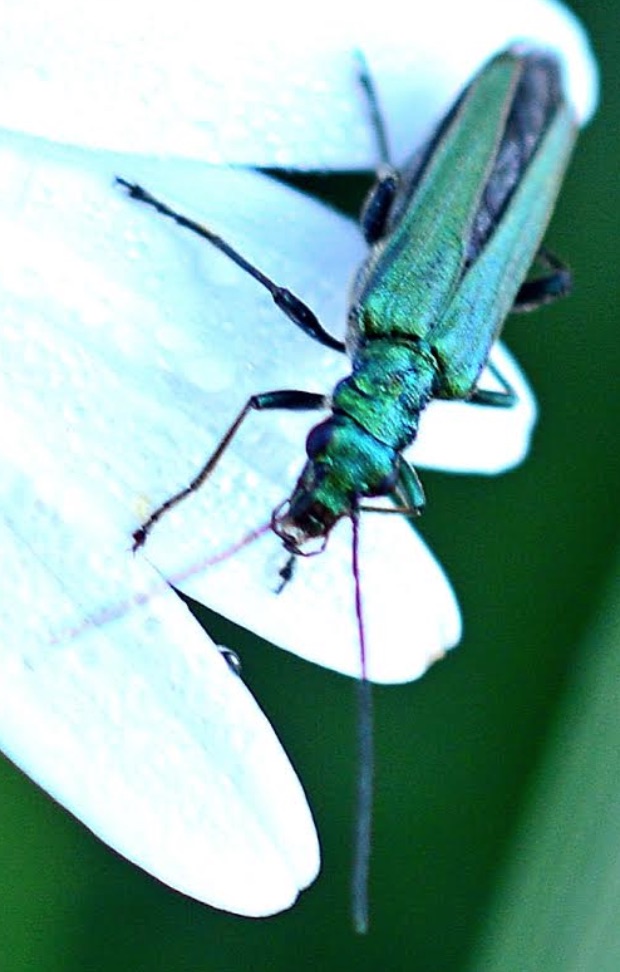 Swollen-thighed beetle, also known as a thick-legged flower beetle, female, Oedemera nobilis, subfamily Oedemerinae, family Oedemeridae. □ One of the features of this swollen-thighed beetle — besides the beautiful metallic blue-green color — is that its elytra (hardened forewings) do not entirely cover the abdomen, as shown in this photo. A similar-looking beetle is the lesser thick-legged flower beetle (Ischnomera cyanea), but it does not have the gap between the elytra. Photographed by: Bryan Wenham-Baker. Identified by: KnowYourInsects.org. Location: Ivybridge, South Hams, South Devon, England, UK. Date: 1 August, 2018. | 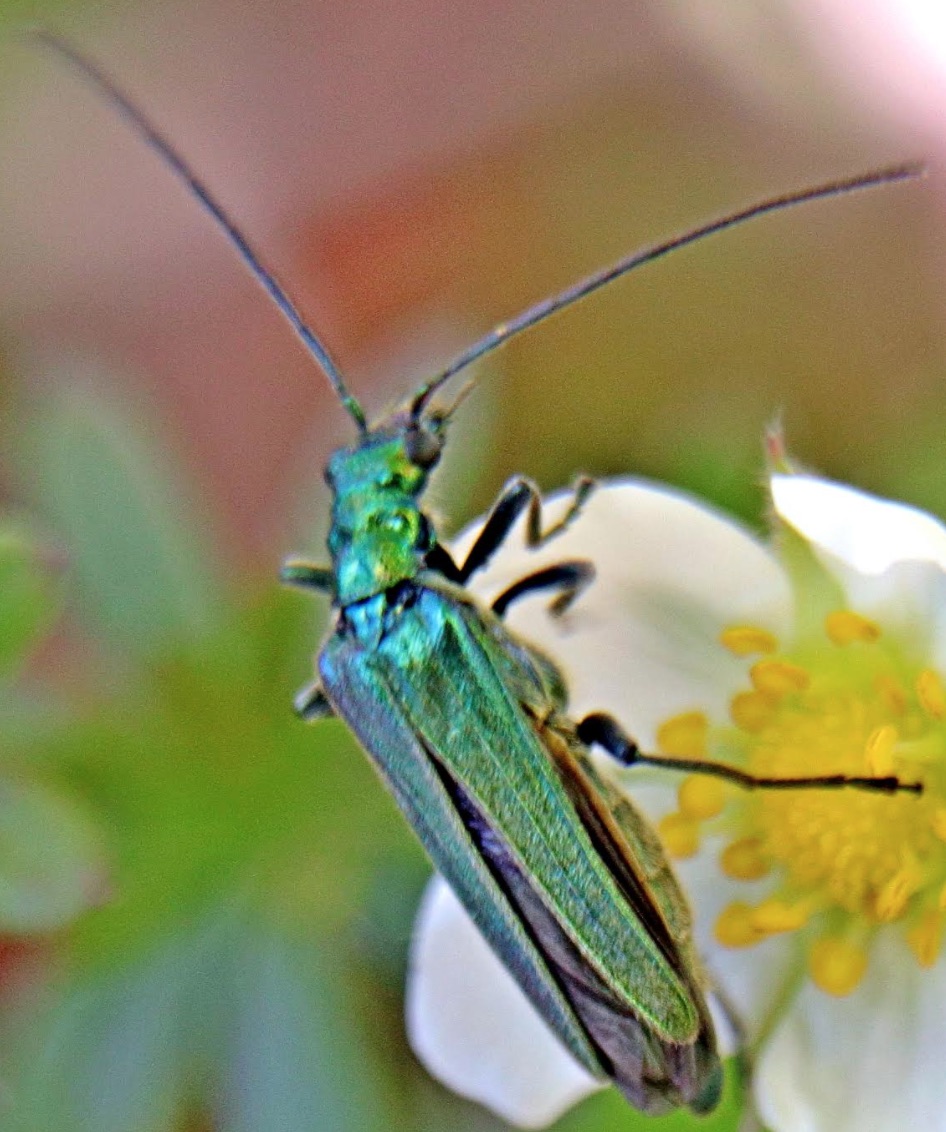 Swollen-thighed beetle, also known as a thick-legged flower beetle, female, Oedemera nobilis, subfamily Oedemerinae, family Oedemeridae. □ A similar species — Oedemera lurida — of flower beetle also makes its home in the UK. Oedemera lurida is gray-green in color, while the swollen-thighed beetle shown here is more of a brilliant green. As the photographer noted, the swollen-thighed beetle is also sometimes known as false oil beetle. Photographed by: Bryan Wenham-Baker. Identified by: KnowYourInsects.org. Location: Ivybridge, South Hams, South Devon, England, UK. Date: 17 May, 2020. | 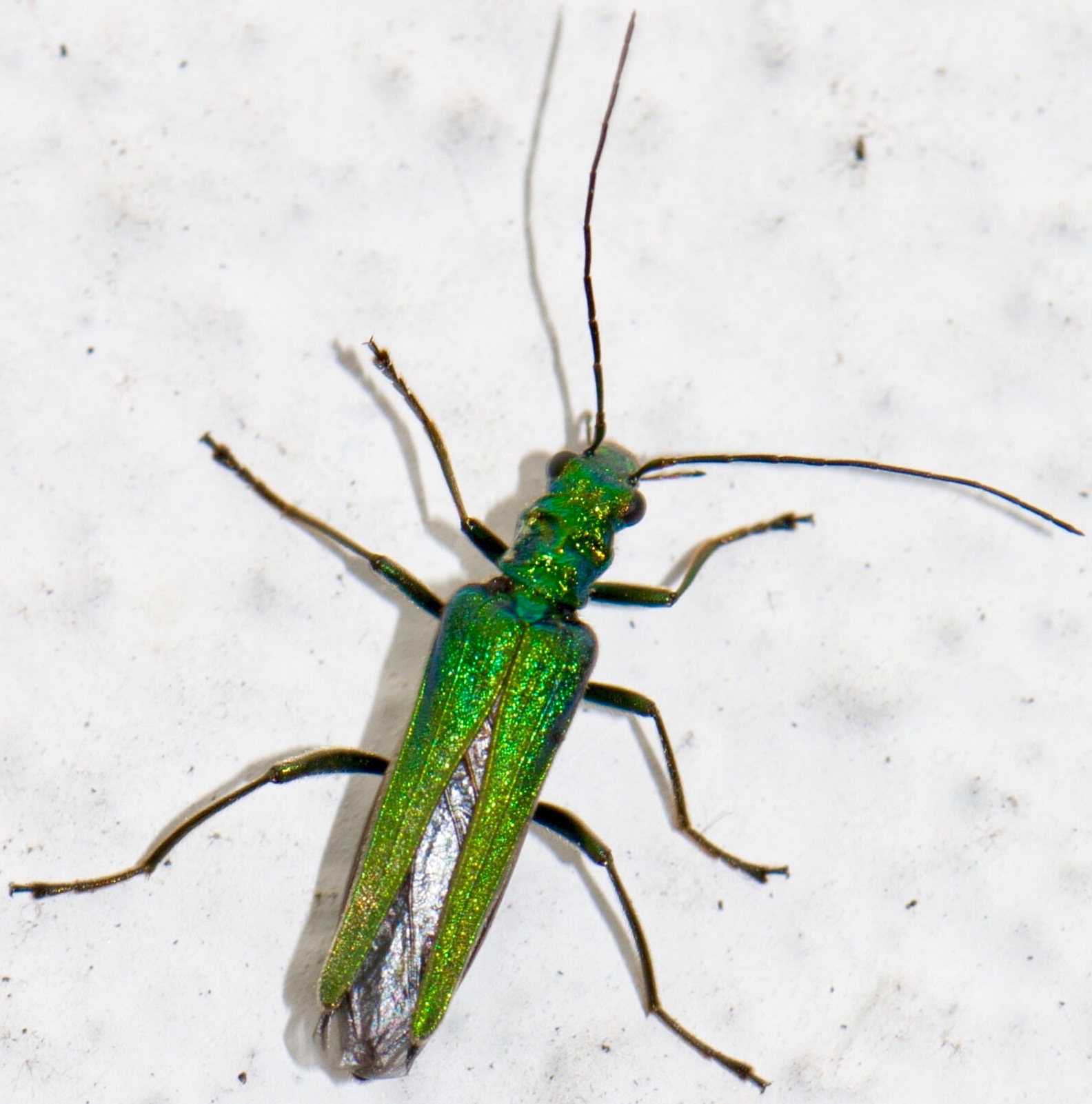 Swollen-thighed beetle, also known as a thick-legged flower beetle, female, Oedemera nobilis, subfamily Oedemerinae, family Oedemeridae. □ Both the male and female swollen-thighed beetles have metallic bodies, which are usually green, but sometimes blue or purple. Photographed and identified by: Jean-Louis Metzger. Location: St. Pée-sur-Nivelle, France. Date: 21 May, 2018. Jean-Louis photographed this beautiful beetle in the garden. |
 Swollen-thighed beetles, also known as thick-legged flower beetles, Oedemera nobilis, subfamily Oedemerinae, family Oedemeridae. □ The male and female swollen-thighed beetle can be distinguished. The male (left photo) has quite-enlarged and swollen-looking femora (femurs) on its hind legs, as well as beefed-up tibiae (the segment behind the femur). The female's legs are slender, as seen in the right photo. Photographed and identified by: Jean-Louis Metzger. Location: Oxford, England, UK. Date: 27 May, 2019, for the female; and 29 May, 2019, for the male. |  Swollen-thighed beetle, also known as a thick-legged flower beetle, male, Oedemera nobilis, subfamily Oedemerinae, family Oedemeridae. □ The femurs on the hind legs of this swollen-thighed beetle almost look like they have been inflated with a bicycle tire pump. The metallic green — a slight different hue on the head and thorax — is quite eye-catching. Photographed and identified by: Melanie Pritchard. Location: Lousã, Portugal . Date: 15 May, 2020. |
Mordellidae, the pintail beetles or tumbling flower beetles
 Tumbling flower beetle in the genus Mordella, subfamily Mordellinae, family Mordellidae. □ This is a close-up of one of a pair of tumbling flower beetles the photographer found on a Queen Anne's lace plant. Queen Anne's lace is also known as wild carrot. See the comment below. Photographed by: Ed Hendrickson. Identified to genus by: entomologist Enrico Ruzzier of the Natural History Museum in London, UK. Location: North Carolina, USA. Date: 5 May, 2018. Entomologist Enrico Ruzzier noted that it is "impossible to identify at species level without genitalia dissection." He made the identification of this photo while doing field work in Cuba! Thank you for the ID! |  Tumbling flower beetle in the genus Mordella, subfamily Mordellinae, family Mordellidae. □ The tumbling flower beetle has a humped thorax, a tapered abdomen, and a head that hangs downward. □ When Tumbling Flower Beetles feel threatened, they do a little jump/tumble maneuver to get themselves in a better position so they can fly away to safety. Photographed by: Denise Rulason. Identified to genus by: KnowYourInsects.org. Location: Mayville, Michigan, USA. Date: 2018. |  Pintail beetle in the genus Hoshihananomia, subfamily Mordellinae, family Mordellidae. □ This polka-dotted pintail beetle has a very noticeable "tail," which is the pointed end of its abdomen. The photographer described it as "about 1 cm long with pointed spike at end." See the comment below. Photographed by: Chandan Kumar. Identified to genus by: entomologist Enrico Ruzzier of the Natural History Museum in London, UK. Location: Kunustoria Colliery, West Bengal, India. Date: 5 May, 2018. Entomologist Enrico Ruzzier noted that it is "impossible to identify at species level without genitalia dissection." He made the identification of this photo while doing field work in Cuba! Thank you for the ID! |  Tumbling flower beetle in the family Mordellidae. □ This tumbling flower beetle was sharing a flower with a swollen-thighed beetle. Photographed by: Melanie Pritchard. Identified to family by: KnowYourInsects.org. Location: Lousã, Portugal. Date: 15 May, 2020. |
Zopheridae, the ironclad beetles and the cylindrical bark beetles
Coccinellidae, the ladybugs or ladybird beetles
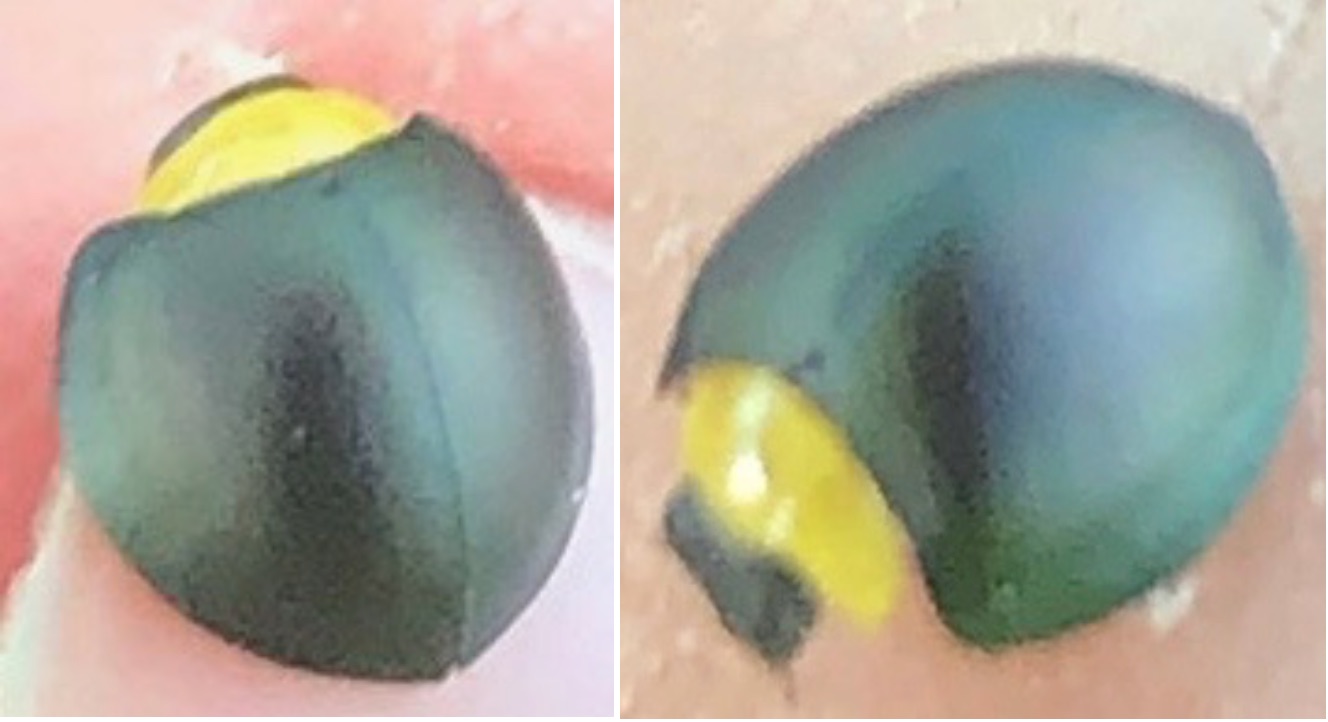 Yellow-crested aegis, Egius platycephalus, subfamily Chilocorinae, family Coccinellidae. □ The yellow-crested aegis is distinguished by its flat-black coloration with a contrasting yellow pronotum. It eats pest-damaging aphids and scale insects. This one was found in West Palm Beach, Florida. It is an introduced species to Florida and was only first recorded in the state in 2013 in Broward County. More information about this little beauty (only about 4mm or 0.17 inches long), can be among the ladybugs listed here. Photographed and identified to family by: Heather Collazo. Identified to species by: KnowYourInsects.org. Location: West Palm Beach, Florida, USA. Date: 5 March, 2020. Heather says, "This is the second I have seen in the past three months." | 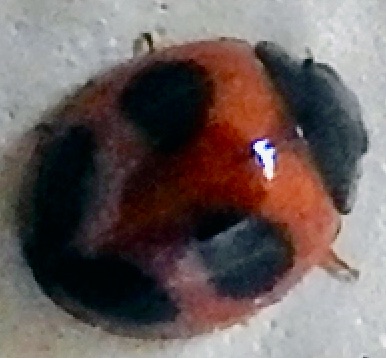 "Minilady" ladybug, Exochomus childreni, subfamily Chilocorinae, family Coccinellidae. □ This species of ladybug has no official common name, so the photographer named it the "minilady". He described it as "small enough to be on an aphid's dinner plate" (see his comment below). It has a black head and thorax, and dark orange to brown elytra (the hardened forewings covering its back) with black blotches on the ends and often black blotches toward the front of its elytra, as seen here. Photographed and identified to family by: Marv Goldberg. Identified to species by: KnowYourInsects.org. Location: Tamarac, Florida, USA. Date: 25 May, 2020. Marv says, "This huge beast was about 1/8 inch (3 mm). I wasn't even sure it was an insect, so I had to photograph it." |  Cactus ladybug, sometimes called a cactus lady beetle, pupa, Chilocorus cacti, subfamily Chilocorinae, family Coccinellidae. □ Once it is ready to become an adult, the back will split open and the adult will emerge. To see an adult emerging from the pupa, click here (bugguide.net). The adult, seen here (bugguide.net), is black with two large red spots. Photographed by: Jack Slatter. Identified by: KnowYourInsects.org. Location: Emory, Texas, USA. Date: 8 August, 2020. Jack spotted this pupa while repairing the eave on his house. |  Subvittate ladybug, Myzia subvittata, subfamily Coccinellinae, family Coccinellidae (the ladybugs or ladybird beetles) □ Some subvittate ladybugs tend to be more yellow (like this one) and others are more orange, and the amount of black streaking also varies quite a bit, but they all have two white blotches on the thorax, and most have the two white smears in the center of the back just behind the thorax. Photographed by: Carole Martens. Identified by: KnowYourInsects.org. Location: Whistler, British Columbia, Canada. Date: 28 July, 2020. |
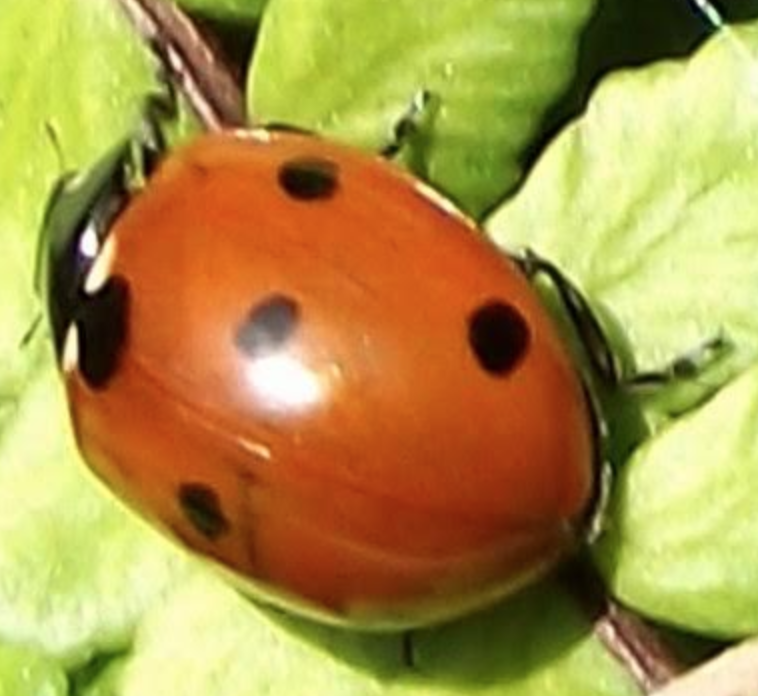 Seven-spot ladybird beetle/ladybug, larva Coccinella septempunctata, subfamily Coccinellinae, family Coccinellidae. □ The seven-spot ladybird beetle does indeed have seven spots: three smaller spots on each of the two forewings (or elytra) and one larger one that spreads onto the front of both elytra (between the two white spots). This is quite a common species in Europe. Photographed and identified by: Bryan Wenham-Baker. Location: Ivybridge, South Hams, South Devon, England, UK. Date: unknown. |  Seven-spot ladybird beetle/ladybug, Coccinella septempunctata, subfamily Coccinellinae, family Coccinellidae. □ This head-on view of the seven-spot ladybug (called a ladybird beetle in the UK) shows the pair of small white dots on its head, the larger white spots on either side of its pronotum (the shield that covers the thorax), and the pair of white spots just behind the pronotum. Photographed by: Thomas Langhans. See Thomas's full-size image here Location: San Bruno, county of San Mateo, California, USA. Date: 4 November, 2018. | 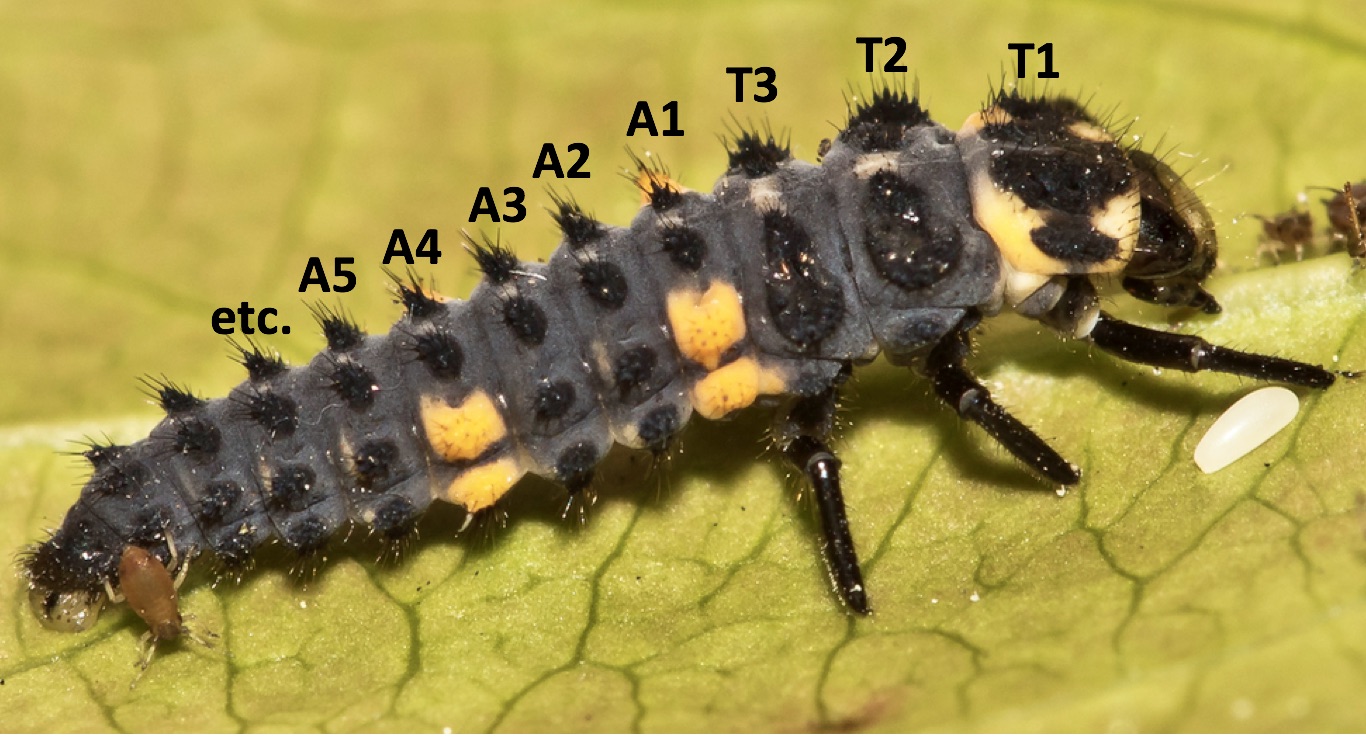 Seven-spot ladybird beetle/ladybug, larva, Coccinella septempunctata, subfamily Coccinellinae, family Coccinellidae. □ The larva of the seven-spot ladybug can be distinguished from other ladybug larvae by the red markings on its abdomen. It has no red markings past the fourth abdominal segment (abdominal segments are noted as A1, A2, A3, etc.; the three segments of the thorax are labeled as T1, T2 and T3). □ The seven-spot ladybug has such a hunger for aphids that it has been introduced multiple times in the United States (where this photo was taken). Photographed by: Thomas Langhans. See Thomas's original, full-size image here Location: San Bruno, county of San Mateo, California, USA. Date: 12 March, 2018. |
 Seven-spot ladybird beetle/ladybug, larva, Coccinella septempunctata, subfamily Coccinellinae, family Coccinellidae. □ Gardeners like seven-spot ladybug larvae because they prey on plant-damaging aphids. A close look at this photo will reveal an aphid crawling on this larva's back, and more in the lower right corner. Photographed by: Thomas Langhans. See Thomas's full-size image here Location: San Bruno, county of San Mateo, California, USA. Date: 12 March, 2018. |  Seven-spot ladybird beetle/ladybug, larva Coccinella septempunctata, subfamily Coccinellinae, family Coccinellidae. □ Occasionally, seven-spot ladybird beetles (like this one) have only faint white spots just behind the thorax. Compare this one to others pictured on this page. Photographed by: Mark Andersen. Identified by: KnowYourInsects.org. Location: Central Minnesota, USA. Date: 8 September, 2021. |  Three-banded ladybug/ladybird beetle, Coccinella trifasciata, subfamily Coccinellinae, family Coccinellidae. □ Often, three-banded ladybugs are orange with black bands that are outlined in yellow, but sometimes (as in this one) they are yellow with black bands. Photographed and identified by: Leslie Mertz. Location: Houghton Lake, Roscommon County, Michigan, USA. Date: 7 July, 2017. Leslie says, "Such a pretty little ladybug!" |  |
 14-spot ladybird beetle, Propylea quattuordecimpunctata, subfamily Coccinellinae, family Coccinellidae. □ The spots on the back of a 14-spot ladybird beetle often run together, as they do on the beetle in this photo. To see the variation within this species, click here (on naturespot.org.uk). Photographed and identified to family by: Bryan Wenham-Baker. Location: Ivybridge, South Hams, South Devon, England, UK. Date: 11 May, 2019. |  Spotless ladybug, Cycloneda sanguinea, subfamily Coccinellinae, family Coccinellidae. □ Not surprisingly, the spotless ladybug lacks spots on the elytra (hardened forewings). To tell the female from the male, look at the pattern on the pronotum. In the male, the white outline continues around the front of the pronotum and he has a white line partially down the center of the pronotum (photo here on bugguide.net). In the female, the white outline is broken and she has no central white line (photo here). Photographed by: Marv Goldberg. Identified by: KnowYourInsects.org. Location: Tamarac, Florida, USA. Date: 5 April, 2019. Marv says, "I don't believe I ever saw a no-spotted ladybug before (I swear, I didn't paint it)." |  Spotless ladybug, larva, Cycloneda sanguinea, family Coccinellidae. □ This is the larva of the spotless ladybug. The adult is one of the "spotless" ladybird beetles, so called because its elytra (the hard wings that cover most of the insect) are completely red with no spots. It is also sometimes called a blood-red ladybug. Photographed by: Sue Sifford. Identified by: KnowYourInsects.org. Location: Gulf Coast of Texas near Galveston, USA. Date: 1 March, 2017. Sue says, "Found it on our orange tree." | 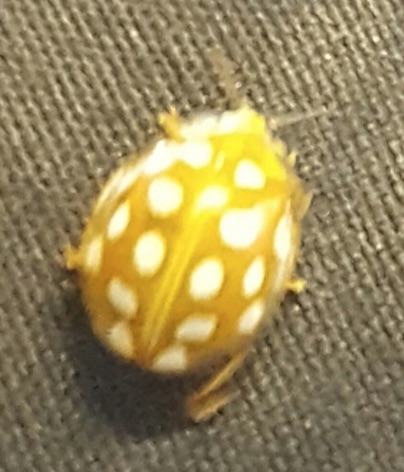 Orange ladybird beetle, Halyzia sedecimguttata, family Coccinellidae. □ The orange ladybird beetle was once quite rare, but is now becoming more common in the UK. Photographed and identified by: Yvonne Ugarte. Location: Leeds, West Yorkshire, UK. Date: 17 October, 2016. Yvonne says, "I do not see these very often. It has been very mild so far though (this fall)." |
 Two-spot ladybird beetle, Adalia bipunctata, subfamily Coccinellinae, family Coccinellidae. □ The two-spot ladybird beetle has a wide range of patterns, some red with two little black spots, some orange with more than a dozen spots, and some like this one: black with only a few red markings. Photographed by: Diana. Location: Riga, Latvia. Date: Date unknown. |  15-spotted ladybug/ladybird beetle), Anatis labiculata, subfamily Coccinellinae, family Coccinellidae. □ This is the typical color and pattern of the 15-spotted ladybug: 15 black spots on a light-gray (sometimes orangish) background with the orange line down the middle of the back. The following photos show how the coloration darkens with age. Photographed by: Denise Rulason. Identified by: KnowYourInsects.org. Location: Interlochen, Michigan, USA. Date: 23 June, 2018. |  15-spotted ladybug/ladybird beetle), Anatis labiculata, subfamily Coccinellinae, family Coccinellidae. □ Typically, the 15-spotted ladybug indeed has 15 black spots on a light-gray to orange background. As they age, however, they sometimes become quite dark, like this one, although the black spots are still visible. Photographed by: Jane Weaver. Submitted by: Lisa Hechler. Identified by: KnowYourInsects.org. Location: Algonquin Lake, Hastings, Michigan, USA. Date: 5 May, 2018. |  15-spotted ladybug/ladybird beetle), Anatis labiculata, subfamily Coccinellinae, family Coccinellidae. □ This is another older 15-spotted ladybug with even darker coloration than the previous photo. Photographed and identified by: Leslie Mertz. Location: Houghton Lake, Roscommon County, Michigan, USA. Date: 7 July, 2017. Leslie says, "I met a woman who told me she was seeing ticks all over the place, and it turned out to be these brownish-black ladybugs!" |
 Eye-spotted ladybug, pupa, Anatis mali, subfamily Coccinellinae, family Coccinellidae. □ Beetles go through four phases: egg, larva, pupa, adult. This is the pupa, likely from an eye-spotted ladybug. As seen in the photo at left, the pupa will often attach one end to a surface, usually a leaf or stem, but in this case man-made material. To see a great time-lapse video of a ladybug going through its four stages here. □ The adult eye-spotted ladybug is orange with white-outlined black spots. Photographed by: Amanda Russell. Identified by: KnowYourInsects.org. Location: Camillus, New York, USA. Date: 3 July, 2020. Amanda says, "I've never seen a ladybug pupa before, but it looked really cool." |  |
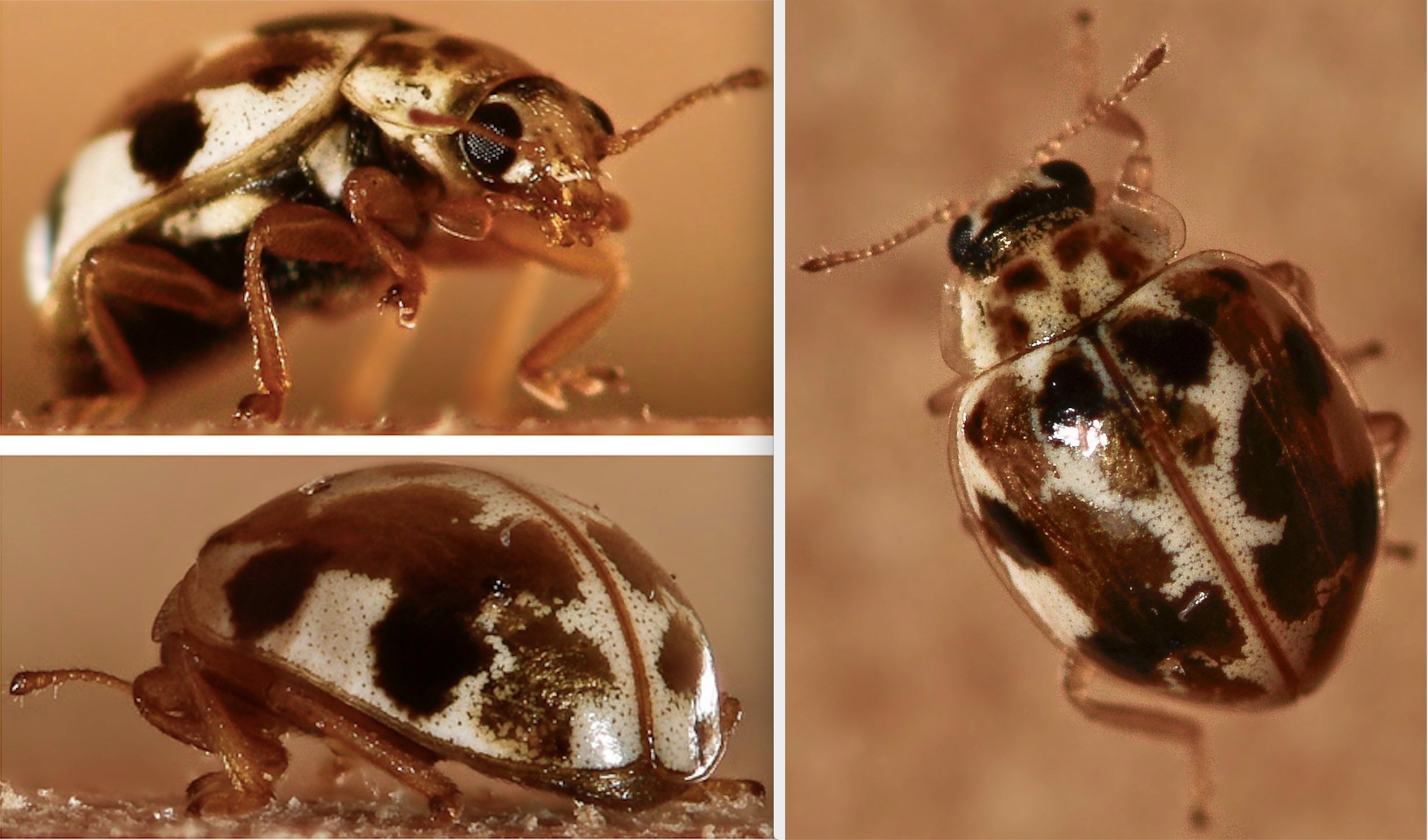 20-spotted lady bug, Psyllobora vigintimaculata, subfamily Coccinellinae, family Coccinellidae. □ The design on this 20-spotted lady bug has a splotchy pattern of brown and slightly lighter brown on its elytra (the forewings covering its back). This design is only seen on individuals in this species within California (where this photo was taken). Outside California, this species has separate brown or black spots, and the white background occasionally has a pale-orange tint. Photographed by: Thomas Langhans. See full-size photos (clockwise from upper left) here, here, and here. Identified by: KnowYourInsects.org. Location: San Bruno, county of San Mateo, California. Date: 4 July, 2021. Thomas said it was only about 2 mm long. |  20-spotted ladybug/ladybird beetle, Psyllobora vigintimaculata, subfamily Coccinellinae, family Coccinellidae. □ All of the 20-spotted lady bugs in California have this pattern. To see what they look like in other parts of their range, click here or here (bugguide.net). Photographed and identified by: Damian Duron. Location: Watsonville, California, USA. Date: 19 October, 2017. Damian says, "This guy is itty bitty, it's around 5 mm (?). That was taken on my very old formica counter." KnowYourInsects.org replies, "Nice estimation on size, Damian! This beetle is indeed tiny, growing to about 3 mm long." |  |
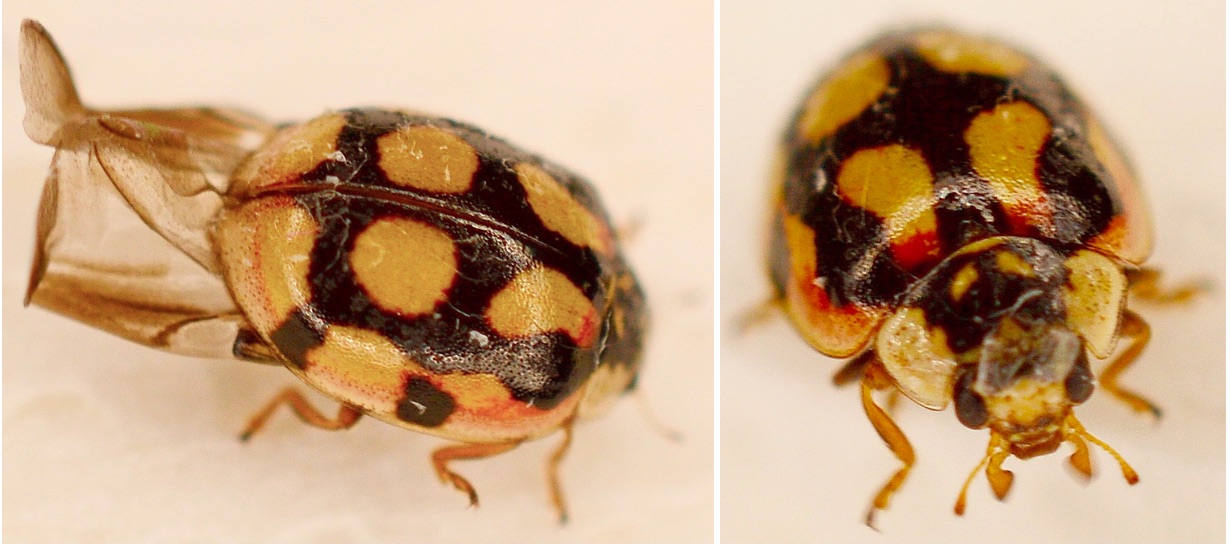 10-spot ladybird beetle, Adalia decempunctata, subfamily Coccinellinae, family Coccinellidae. □ The 10-spot ladybird beetle is quite a variable species. This specimen has 10 spots, but not all of them do. To see the considerable variation within this species, click here (on naturespot.org.uk). Photographed and identified by: Bryan Wenham-Baker. Location: Ivybridge, South Hams, South Devon, England, UK. Date: 2 January, 2018. Bryan says, "Looks like a tortoise, but it's only 4mm long! Two shots of it, one with wings partly unfurled." |  Eastern 10-spotted ladybird beetle, larva, Bothrocalvia pupillata, subfamily Coccinellinae, family Coccinellidae. □ The eastern 10-spotted ladybird beetle is a different species from the 10-spot ladybird beetle (Adalia decempunctata) shown previously. This larva of an eastern 10-spotted ladybird beetle has a distinctive pattern of large and small black spots on a lighter-colored background. The background may be white (as seen here), orange, yellow or a combination of white, orange and/or yellow. □ The eastern 10-spotted ladybird beetle is a native of Hong Kong, but has been intentionally introduced to Hawaii, where this photo was taken, to combat plant lice. Photographed by: Christian Moratin. Identified by: KnowYourInsects.org. Location: Heeia, Oahu, Hawaii, USA. Date: 26 May, 2020. |
 |  Predaceous ladybird beetle, larva, Harmonia eucharis, subfamily Coccinellinae, family Coccinellidae. □ The larvae of this species of predaceous ladybird beetle all have these lovely cream-colored markings on the abdomen — almost like embroidery looped stitches. The adults of this species, however, come in a wide color and pattern variation, as shown here. Photographed by: Syed Gazanfar. Identified by: KnowYourInsects.org. Location: Kashmir, India. Date: 23 April, 2018. |  Large spotted ladybird beetle, larva, Harmonia octomaculata, subfamily Coccinellinae, family Coccinellidae. □ This is the larva of a large spotted ladybird beetle. The adult is red with black markings, as seen here (Cook Islands Biodiversity Database). Photographed by: Carolyn Noake. Identified by: KnowYourInsects.org. Location: Moruya, New South Wales, Australia. Date: 12 June, 2020. |  Ladybird beetle, Harmonia dimidiata, subfamily Coccinellinae, family Coccinellidae. □ This ladybird beetle has a variety of appearances, including this one with its orange "shoulders", each centered with a black spot. Photographed by: Nayab Wahab. Identified by: KnowYourInsects.org. Location: Swabi, Khyber Pakhtunkhwa, Pakistan. Date: 7 July, 2021. |
 Harlequin ladybird beetle, also known as an Asian multicolored ladybug, Harmonia axyridis, subfamily Coccinellinae, family Coccinellidae. □ Harlequin ladybird beetles come in a wide range of color patterns, but this is one of the most common. This species is native to eastern Asia, and was purposely introduced to Europe as well as North America to control pests, such as aphids. It is now common in its new environs. Photographed and identified by: Leslie Mertz. Location: Houghton Lake, Roscommon County, Michigan, USA. Date: 7 July, 2017. |  Harlequin ladybird beetle, also known as an Asian multicolored ladybug, Harmonia axyridis, subfamily Coccinellinae, family Coccinellidae. □ This harlequin ladybird beetle has white "cheeks" (actually the sides of the pronotum), while many other individuals in this species are decorated with a white "W". This page has a few photos of Harlequins posted to show some of the wide variation in colors and patterns within this species. Photographed and identified by: Leslie Mertz. Location: Houghton Lake, Roscommon County, Michigan, USA. Date: 7 July, 2017. |  Harlequin ladybird beetle, also known as an Asian multicolored ladybug, Harmonia axyridis, subfamily Coccinellinae, family Coccinellidae. □ This harlequin ladybird beetle has minimal spotting, while some other members of this species have 20 or more spots. Photographed and identified by: Leslie Mertz. Location: Houghton Lake, Roscommon County, Michigan, USA. Date: 7 July, 2017. |  Harlequin ladybird beetle, also known as an Asian multicolored ladybug, Harmonia axyridis, subfamily Coccinellinae, family Coccinellidae. □ Although native to Southeast Asia, harlequin ladybird beetles are now found in North and South America, throughout Europe and Asia, and in Africa. Photographed by: Yvonne Ugarte. Identified by: KnowYourInsects.org. Location: Leeds, West Yorkshire, UK. Date: 17 October, 2016. |
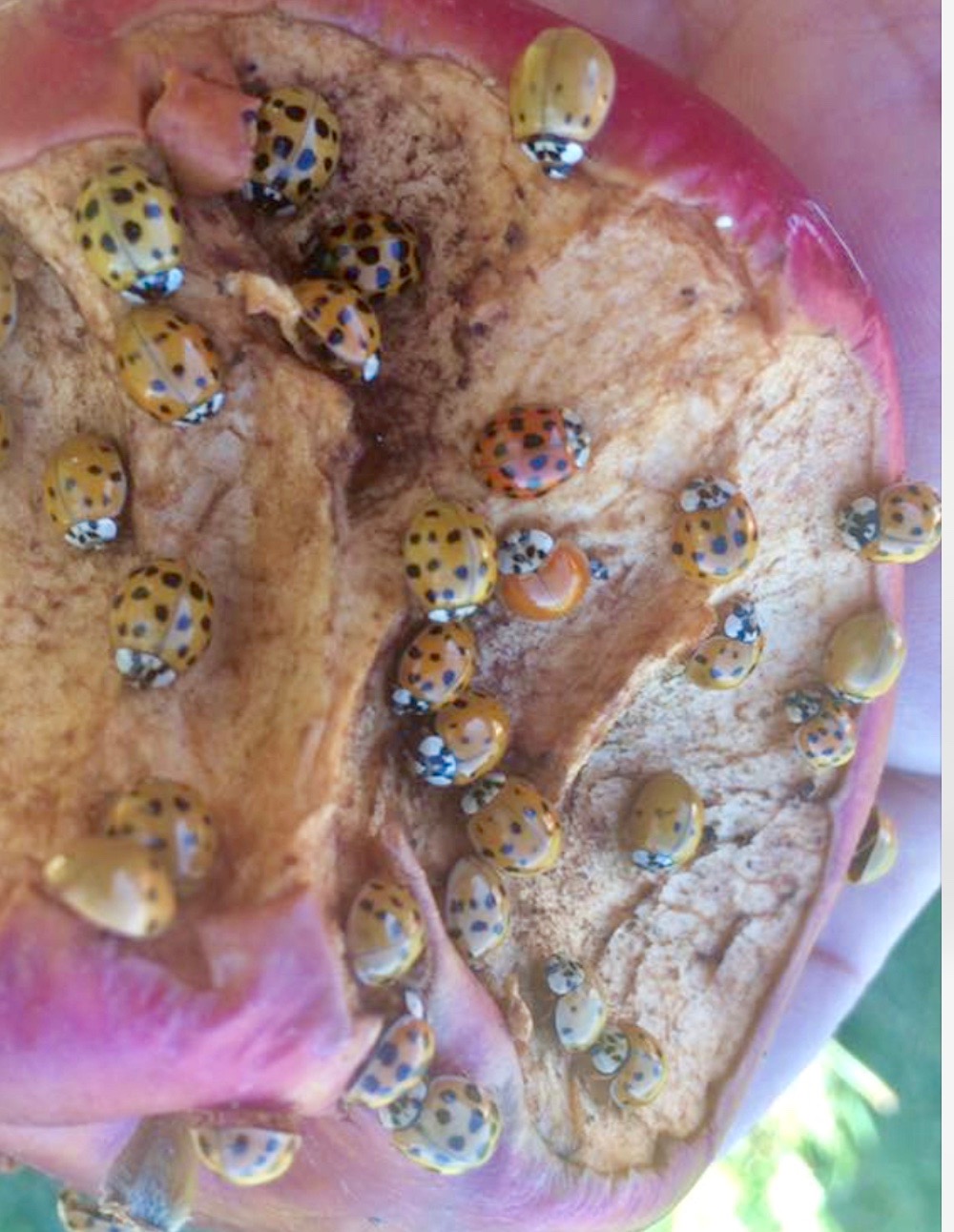 Harlequin ladybird beetle, also known as an Asian multicolored ladybug, Harmonia axyridis, subfamily Coccinellinae, family Coccinellidae. □ The wide color variation among harlequin ladybird beetles is evident in this swarm on an apple. Photographed and identified as ladybugs by: John Hayes. Identified to species by: KnowYourInsects.org. Location: Maple Park, Illinois, USA. Date: 21 October, 2017. |  Harlequin ladybird beetle, also known as an Asian multicolored ladybug, Harmonia axyridis, subfamily Coccinellinae, family Coccinellidae. □ Take at look at the collection of photos that follow — They are all the same species: harlequin ladybird beetles! They are amazingly diverse. Photographed by: Yvonne Ugarte. Identified by: KnowYourInsects.org. Location: Leeds, West Yorkshire, UK. Date: 17 October, 2016. |  Harlequin ladybird beetle, also known as an Asian multicolored ladybug, Harmonia axyridis, subfamily Coccinellinae, family Coccinellidae. □ Harlequin ladybird beetles take on a number of different color patterns as adults, as seen here. Photographed by: Dick Ford. Identified by: KnowYourInsects.org. Location: Marsolan, Midi-Pyrénées, southwest France. Date: 28 May, 2017. Dick says, "I live in southwest France, where we have been devastated by the box tree moth caterpillar (Cydalima perspectalis) which is gobbling up box hedges throughout the countryside. Searching for the beastly thing in my box hedge I came across this chap." |  Harlequin ladybird beetle, also known as an Asian multicolored ladybug, Harmonia axyridis, subfamily Coccinellinae, family Coccinellidae. □ For more information about harlequin ladybird beetles and misinformation about sexually transmitted diseases (see photographer's comment below), click here. Photographed and identified by: Bryan Wenham-Baker. Location: Ivybridge, South Hams, South Devon, England, UK. Date: 11 October, 2018. Bryan says, "In certain UK areas, Manchester, Birmingham, Loughborough and Gloucester as example towns, there are swarms of Harlequins, extra spots, or black, invading various premises including people's houses. Residents are concerned about their carrying of STDs, but authorities (are) trying to educate people that they are not harmful to humans." |
 Ladybug, larva, likely the Harlequin ladybird beetle, also known as an Asian multicolored ladybug, Harmonia axyridis, subfamily Coccinellinae, family Coccinellidae. □ This larva was about the size of a large grain of rice. It is likely a harlequin ladybird beetle. Photographed by: Rhonda Baxter. Identified by: KnowYourInsects.org. Location: Dearborn, Michigan, USA. Date: 8 June, 2016. Rhonda says, "The larva survived and grew! I put it out on my rosebush. I was wondering if it made it through to an adult today, and as I was eating my dinner, this ladybug landed on my window screen across from me. It is the only one I have seen around my house at all this year. I am hoping it was the one I saved. I guess I am a crazy bug lady. LOL." | 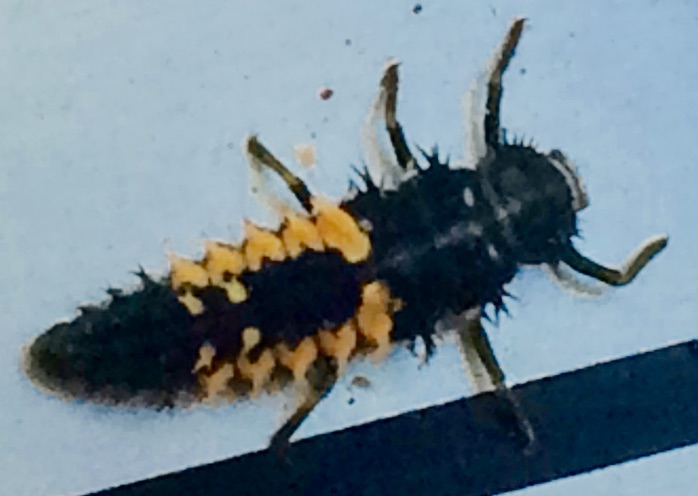 Harlequin ladybird beetle, also known as an Asian multicolored ladybug, Harmonia axyridis, subfamily Coccinellinae, family Coccinellidae. Photographed by: Carlo Castoro. Identified by: KnowYourInsects.org. Location: Duff Park, Monroeville, Pennsylvania, USA. Date: 4 Octover, 2014. |  Harlequin ladybird beetle, also known as an Asian multicolored ladybug, Harmonia axyridis, subfamily Coccinellinae, family Coccinellidae. □ The photographer was fortunate to find the pupa of this harlequin ladybird beetle in her garden and then to see the adult emerge 11 days later. How cool is that! Newly emerged ladybird beetles will develop their adult coloration within a few hours. Photographed by: Lynsey Popham. Identified by: KnowYourInsects.org. Location: Alton, England, UK. Date: 6 and 17 June, 2019. Lynsey found the pupa in the garden. |
 Ladybug, pupa, probably the Harlequin ladybird beetle, also known as an Asian multicolored ladybug, Harmonia axyridis, subfamily Coccinellinae, family Coccinellidae. Photographed and identified to family by: Thomas Langhans. See Thomas's full-size image here. Location: San Bruno, county of San Mateo, California, USA. Date: 29 March, 2019. | .jpg) Harlequin ladybird beetle, also known as an Asian multicolored ladybug, larva, Harmonia axyridis, family Coccinellidae. Photographed by: Jason Frankel. Identified by: KnowYourInsects.org. Location: West Virginia, USA. Date: 1 June, 2021. |  |  Convergent ladybug/convergent ladybird beetle, Hippodamia convergens, subfamily Coccinellinae, family Coccinellidae. □ The convergent ladybug is native to North America. This species has a black pronotum (the shield over the thorax) outlined in white, and decorated with a pair of white, slightly curved markings. Each elytra (forewing) has a large black spot in front, followed by a pair of small black spots, and a trio of large black spots at the rear. Photographed by: Thomas Langhans. See Thomas's original, full-size image here Location: San Bruno, county of San Mateo, California, USA. Date: 21 August, 2016. |
 Convergent ladybug/convergent ladybird beetle, pupa, probably Hippodamia convergens, family Coccinellidae. Photographed by: Rachel Van Horn. Identified by: KnowYourInsects.org. Location: Cedar Springs, Michigan, USA. Date: 10 June, 2016. Rachel says, "I realized after I sent it that it was some kind of pupa, because there was just a casing left a few hours later and our little guy was gone." |  Convergent ladybug/convergent ladybird beetle, larva, probably Hippodamia convergens, family Coccinellidae. □ As seen here, the larva of a convergent ladybug has four prominent orange spots on its abdomen. Some individuals have extra spots, and sometimes two row of them that run down the rear half of the abdomen. Photographed by: Jody Isenberg. Submitted by: Nicky Schauder. Identified by: KnowYourInsects.org. Location: San Bernardino, California, USA. Date: 17 April, 2021. |  Ladybug, larva, in the genus Scymnus, possibly Scymnus castaneus, subfamily Scymninae, family Coccinellidae. □ The adult of the ladybug Scymnus castaneus is small, so it is often called a dwarf ladybug, and it is brown in color and covered with short fine hairs (or in scientific terms, densely punctate). To see the adult, click here. Photographed and identified by: Maharshi Nilesh Patel. Location: outskirts of Vansda National Park, Vansda tehsil, Navsari District of Gujarat State, India. Date: 27 August, 2019. |  Ladybug, larva, in the genus Scymnus, possibly Scymnus castaneus, subfamily Scymninae, family Coccinellidae. □ This unusual-looking ladybug, probably a dwarf ladybug larva looks like it is adorned with tufts of white cotton. Photographed by: Arkopal Gupta. Identified by: KnowYourInsects.org. Location: district Alipurduar, state west Bengal, India. Date: 28 February, 2011. |
Nitidulidae, the sap beetles
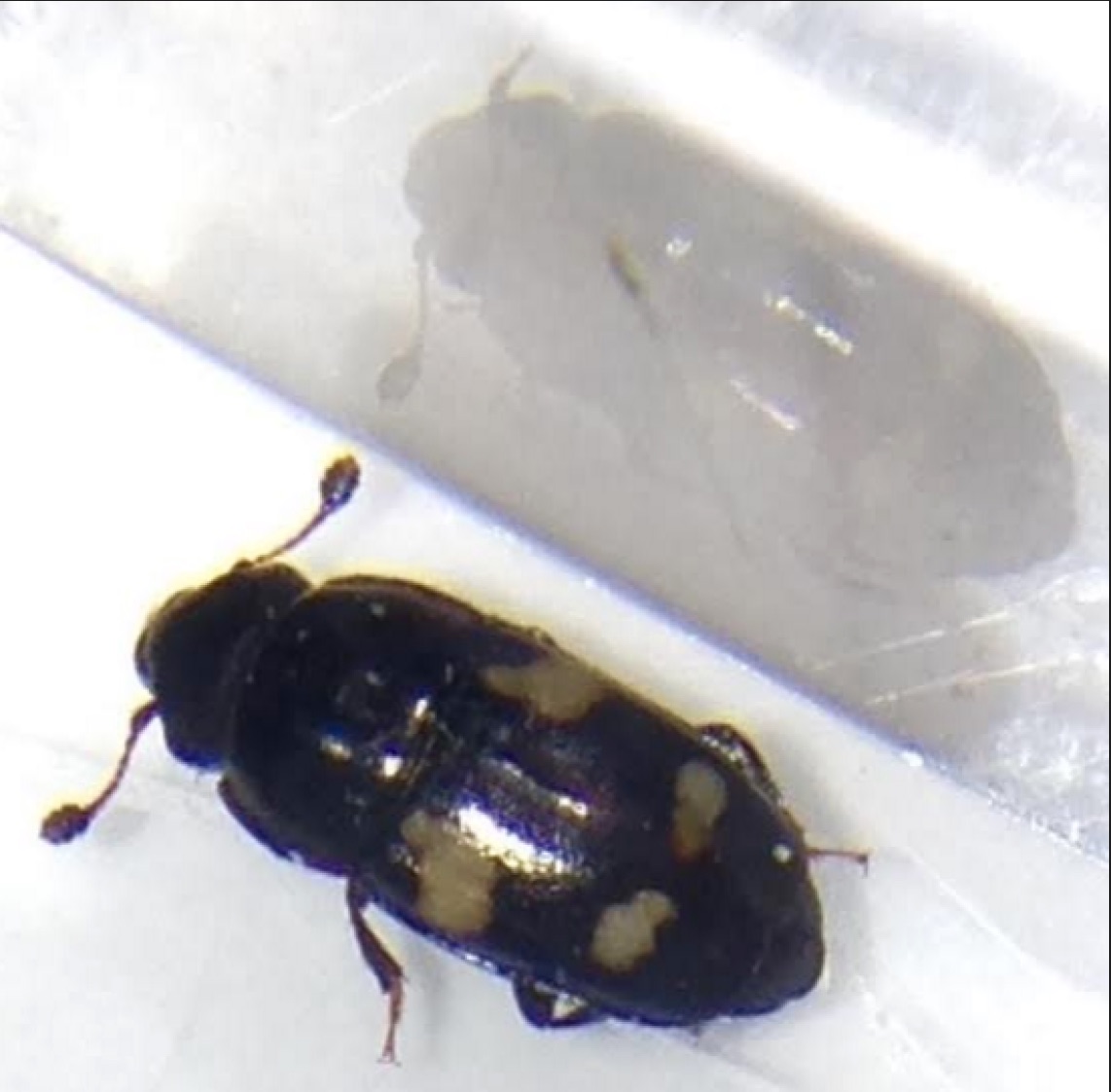 Four-spotted sap beetle, Glischrochilus quadrisignatus, subfamily Cryptarchinae, family Nitidulidae. □ The shadow is a great touch in this photo of a four-spotted sap beetle. Photographed and identified by: Kelly McKinne (@gonzonaturalist). Location: northern Ohio, USA. Date: July 2016. |  Sap Beetle, probably a small hive beetle, Aethina tumida, subfamily Nitidulinae, Nitidulidae. □ This specimen is tiny (and yes, it's a bit crushed). The small hive beetle is originally from sub-Saharan Africa, and was first seen in the United States in the late 1990s in a commercial bee hive. Since then it has spread across U.S. Photographed by: Harold Vines. Identified by: KnowYourInsects.org. Location: Grand Rapids, Michigan, USA. Date: 9 March, 2017. |  |  |
Silvanidae, the flat bark or silvanid beetles
Cucujidae, the flat-back beetles
 Saw-toothed grain beetle, Oryzaephilus surinamensis or Oryzaephilus mercator, subfamily Silvaninae, family Silvanidae. □ The saw-toothed grain beetle is a quite common household pest. It feeds on grain or whatever other pantry food it can find, and it is a small insect, so it can get in even the tiniest of places. Note the tiny spikes on its thorax — they help to identify this beetle as one of the two species mentioned. Photographed by: Laura Vasquez. Identified by: KnowYourInsects.org. Location: central Minnesota, USA. Date: 1 July, 2018. |  |  | 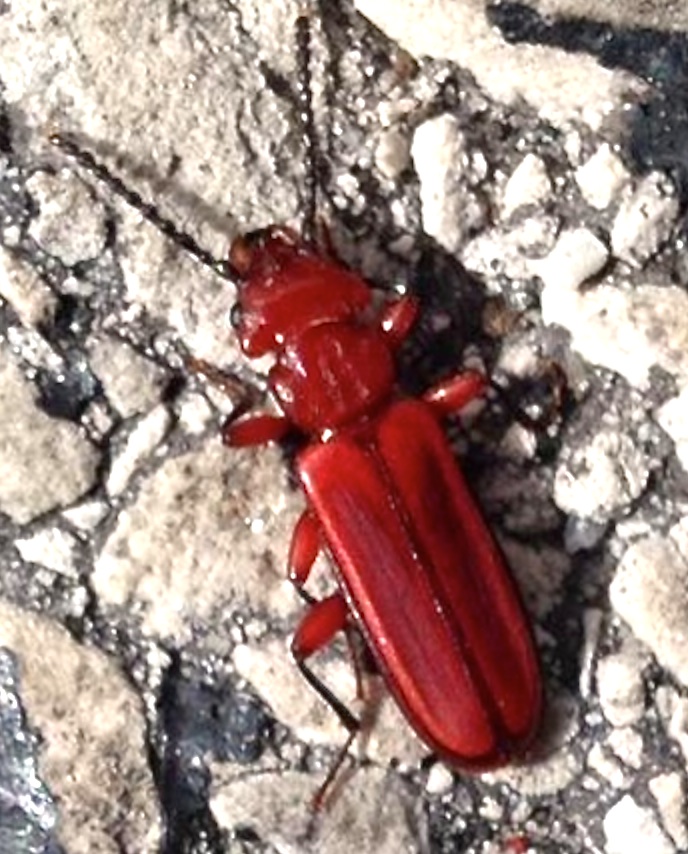 Flat bark beetle, family Cucujidae. Photographed and identified by: Kelly McKinne (@gonzonaturalist). Location: Black Swamp Bird Observatory, Oak Harbor, Ohio, USA. Date: 12 April, 2015. |
Carabidae, the ground beetles
 Tyrant ground beetle, also known as a spotted ground beetle, in the genus Anthia, probably Anthia mitchelli, subfamily Anthiinae, family Carabidae. □ The tyrant ground beetle has a gland at the rear of the abdomen from which it can squirt a chemical secretion that contains some bad-tasting and bad-smelling chemicals. See the photographer's comment below about how her dog learned about this ability." Photographed by: Lindsey Southern. Identified by: KnowYourInsects.org. Location: Whiteriver, Mpumalanga, South Africa. Date: 6 May, 2019. Lindsey says, "It seems to also squirt an unpleasant liquid out its butt, as when my dog went close to it — to sniff it — she came away very suddenly and was trying to wipe off her muzzle. |  Caterpillar hunter, larva, in the genus Calosoma, subfamily Carabinae, family Carabidae. □ This beetle larva looks like it is covered in black armor plates. They are called caterpillar hunters for good reason: Both the larva and the adult do eat caterpillars. □ It is difficult to distinguish between the larvae of different species in this genus. One possibility is the Black Caterpillar Hunter Calosoma sayi — the adult is a dull black with ridges and tiny red indententations on its elytra (the wings that cover its back). To see the adult Black Caterpillar Hunter, click here. Photographed by: Douglas Cox. Identified by: KnowYourInsects.org. Location: Canyon Lake, Texas, USA. Date: 28 April, 2020. Douglas says, "It played dead for about a minute so I could photograph it, then ran off." |
 Fiery hunter, Calosoma calidum, subfamily Carabinae, family Carabidae. □ The fiery hunter is sometimes called a fiery searcher. A large beetle at about 1.5 inches (3.8 cm), this black beetle has rows of red depressions (called fovea) on its back. Its mouthparts, including the finger-like palps, can be seen in the shadow. Note: This species was once listed under the genus Callisthenes. Photographed and identified by: Leslie Mertz. Location: Kalkaska County, Michigan, USA. Date: 24 May, 2012. Leslie says, "Look at the texture on its elytra (its back), especially highlighted with those tiny red dots. Gorgeous!" |  Snail killer carabid, Scaphinotus angusticollis, subfamily Carabinae, family Carabidae. □ The snail killer carabid is black and deep-red, and may be shiny (like this one) or dull. They live in moist places where they can find — and eat — snails and slugs. Photographed and identified to order by: Doug Pollock. Identified to species by: KnowYourInsects.org. Location: along a trail in Sooke, British Columbia, Canada. Date: 8 December, 2019. Doug, says, "There are definitely plenty of slugs on Vancouver Island were we live. This was the first time seeing this little beetle." |  Purple-rimmed carabus, also known as the European ground beetle, bronze ground beetle or bronze carabid, Carabus nemoralis, subfamily Carabinae, family Carabidae. □ The purple-rimmed carabus, which is also known as a European ground beetle, was introduced to the United States, where this photo was taken, from its native Europe. Note the color variation in the species between this and the next photo. Photographed and identified to genus by: Ryan King. Identified to species by: KnowYourInsects.org. Location: Fairview, Michigan, USA. Date: 19 April, 2019. Ryan says, "I happened upon a beetle under a log ... that looked rather interesting." |  Purple-rimmed carabus, also known as the European ground beetle, bronze ground beetle or bronze carabid, Carabus nemoralis, subfamily Carabinae, family Carabidae. □ The diet of the purple-rimmed carabus includes slugs, snails, centipedes and millipedes. Gardeners often find it during the day under leaf litter. This flightless, nocturnal beetle has a greenish-bronze coloration with hints of purple or reddish-copper around the edges, and also has tiny, gold-centered depressions (called fovea) on its back. Photographed and identified to family by: Karen Bradfield. Identified to species by: KnowYourInsects.org. Location: Haute Vienne, France. Date: 30 January, 2020. Karen says, "A warmish but wet evening, he was climbing the wall near my back door." |
 Blue-spotted tiger beetle, also known as gold-spotted tiger beetle, Cicindela aurulenta, subfamily Cicindelinae, family Carabidae. □ This set of photos shows the broad spectrum of colors in the blue-spotted tiger beetle, the white spots (three on a side), and those amazing jaws! □ Tiger beetles have excellent eyesight and are very quick, so once a tiger beetle spots a prey insect — and the it will eat amost anything — it will chase down the prey and put its powerful jaws to work. Photographed and identified by: Margaret Minor. Location: Kam Shan Country Park, Hong Kong. Date: 21 July, 2019. Margaret says this little beetle can "run 5 mph AND fly." For the metric world, 5 mph is 8 kph! |  Blue-spotted tiger beetle, also known as gold-spotted tiger beetle, Cicindela aurulenta, subfamily Cicindelinae, family Carabidae. □ The eye-catching blue-spotted tiger beetle is often seen on sandy beaches, sand dunes, sandy river shores, and other — you guessed it — sandy areas. Not a large insect, this beetle is less than 2 cm (about 3/4 inch) long. Photographed by: Abhiroop Singh Gill. Identified by: KnowYourInsects.org. Location: Amritsar, India. Date: 18 November, 2016. |
 Green tiger beetle, Cicindela campestris, subfamily Cicindelinae, family Carabidae. □ This green tiger beetle, which can be up to 1.5 cm (0.6 inches) long, has shiny green elytra (the hardened forewings covering its back) with sparse, small white to yellowish spots, and a thorax and head colored in green and bronze metallic. Photographed and identified to order by: Yanni Petropoulos. Identified by: KnowYourInsects.org. Location: mainland of southwest Greece. Date: 30 April, 2020. |  Six-spotted tiger beetle, Cicindela sexguttata, subfamily Cicindelinae, family Carabidae. □ Most people see six-spotted tiger beetles when these insects come out of the woods and run across sidewalks or paths. Occasionally, this beetle will be blue rather than green. Photographed and identified by: Leslie Mertz. Location: Kalkaska County, Michigan, USA. Date: 28 May, 2012. Leslie says, "That green metallic is even prettier in person." |  Six-spotted tiger beetle, Cicindela sexguttata, subfamily Cicindelinae, family Carabidae. □ Six-spotted tiger beetles have small white spots on their metallic emerald-green elytra (the hardened forewings covering its back). Many have only six spots ringing the outside of edge, but some either have two more spots toward the middle (like this one), or have two less. Photographed and identified by: Kyle Lengerich. Location: Indiana, USA. Date: 2019. |  Six-spotted tiger beetle, Cicindela sexguttata, subfamily Cicindelinae, family Carabidae. □ The Six-spotted tiger beetle will actually run after prey (other small insects) and attack with their strong jaws. When they have grabbed one, the beetle will drag it into an underground burrow and eat it. Photographed and identified to order by: Keith Rehbein. Location: western Massachusetts, USA. Date: 6 June, 2020. Keith says he spotted this with his kids. Go, Rehbein family! |
 Littoral tiger beetle, female, Calomera littoralis, subfamily Cicindelinae, family Carabidae. □ This bronze-colored littoral tiger beetle has cream spots on its elytra (hardened wings covering its back) and a sideways, green "8$rdquo; marking on its pronotum (the shield over its thorax). Photographed and identified as a tiger beetle by: Yanni Petropoulos. Location: southern Greece. Date: 22 June, 2020. Yanni says, "I found it just by the sandy shore, feeding next to the waves." |  Tiger beetle in the genus Cicindela, likely a Bronzed Tiger Beetle, Cicindela repanda, subfamily Cicindelinae, family Carabidae. □ This pair of photos show not only the scrolled markings on this tiger beetle's back, but also the metallic coloration on its body and legs, and the multitude of hairs on this insect. See the comment below about these insects, which were photographed on the harder, upland sandy bank at the very edge of a reservoir. Photographed and identified to order by: Jo Belasco. Identified to species by: KnowYourInsects.org. Location: Wheatland, Wyoming, USA. Date: 13 June, 2019. Jo's sister Dawn sent in the photos, and she says, "It was a sunny day and the sand was warm. These creatures were hopping all over the sand, mating, and reminded me of water striders in the way they moved. (They are clearly not water striders; I am only telling you how they seemed to skitter about on the sand.)" To see a water strider, click here. |  Six-Spot Ground Beetle or Domino Beetle, Anthia sexguttata, subfamily Anthiinae, family Carabidae. □ The six, large, white spots help identify this aptly named six-spot ground beetle, sometimes also suitably called a domino beetle. Photographed by: Amit S. Identified by: KnowYourInsects.org. Location: Pune, Maharashtra, India. Date: 6 August, 2021. Amit says this large beetle was "very shy." |
 Ground beetle, also known as a harp beetle, Bradycellus californicus, subfamily Harpalinae, family Carabidae. □ This ground beetle's body has a finish like a polished, brown, patent-leather shoe. Like many species in this subfamily, the thorax is smooth, while the elytra (wings covering the abdomen) have slight ridges on them. The beetle uses the four finger-like palps on its mouthparts (two labial palps and two maxillary palps) to feel, taste and manipulate food items. □ The insect leg has two small sections called a coxa and trochanter between the body and the femur ("thigh"), but in some insects, the trochanter is enlarged, as it is in this Ground Beetle. The enlarged trochanter is visible in the hind leg in the center photo, and hangs down alongside the femur up near the body. Photographed and identified to order by: Thomas Langhans. Identified to species by: KnowYourInsects.org. See Thomas's full-size images here, here and here. Location: San Bruno, county of San Mateo, California, USA. Date: 12 February, 2020. Thomas says it was about 9 mm (1/3 inch) long. |  Green-winged lebia, Lebia viridipennis, subfamily Harpalinae, family Carabidae. □ This green-winged lebia's is red with dark-green elytra (the hardened forewings). Unlike many other species in this family (the ground beetles, family Carabidae) that have ridged and dull elytra, the green-winged lebia has smooth, shiny elytra. Photographed and identified to order by: Frederic Strawbridge. Identified to species by: KnowYourInsects.org. Location: southeastern Pennsylvania, USA. Date: 11 September, 2020. |
 Ground beetle, either Scarites quadriceps or Scarites vicinus, subfamily Scaritinae, family Carabidae. Photographed by: Eric Grewe. Identified by: KnowYourInsects.org. Location: Novi, Michigan, USA. Date: 16 June, 2015. Eric found this beetle at work. Insects are indeed everywhere! |  Ground beetle, Archicolliuris bimaculata, subfamily Lebiinae, family Carabidae. □ The long thorax on this ground beetle is sometimes mistaken for a neck, so it is sometimes called a "long-necked ground beetle." Although difficult to see in this photo, its elytra (the hardened wings covering its back) are a darker brown on the back half, where the two spots are located. Its species name of bimaculata actually means two spots. Photographed by: Saloni Sharma. Identified by: KnowYourInsects.org. Location: India. Date: 27 August, 2020. |  |  Ground beetle, larva, family Carabidae. □ Ground beetles go through the four stages of other types of beetles: egg, larva (grub), pupa, and adult. The typical larva of a ground beetle is elongate, as seen here, with a large head equipped with noticeable, curved jaws ideal for chewing. The species of this larva is unknown. Photographed by: Steve McKay. Identified by: Professor Jim Hardie, Director of Science, Royal Entomological Society. Location: Den Haag, the Netherlands. Date: 25 April, 2021. Steve tried identifying it with the KnowYourInsects.org key to no avail, and then sought advice from Dr. Hardie and a Dutch insect website, so he says, "all in, this larvae ID has had a very international flavor!" |
Dytiscidae, the predaceous diving beetles
 Predaceous diving beetle, also known as a giant diving beetle, Cybister fimbriolatus, subfamily Dytiscinae, family Dytiscidae. □ Predaceous diving beetles spend much of their lives in the water of ponds and lakes, but they can fly and will often head for streetlights or other lights on land. As noted by the photographer (see below), this one was indeed spotted on land. Photographed by: Brianna Sutterfield. Identified to family by: Mark Stephens, 2016 Conservation Educator of the Year. Mark runs the wonderful Project F.I.S.H. program in Michigan. Identified to species by: KnowYourInsects.org. Location: Mount Pleasant, Michigan, USA. Date: 27 February, 2018. Brianna says, "I found this big guy in a parking lot tonight! He was at least an inch and a half long and about an inch wide!" |  Predaceous diving beetle, also known as a giant diving beetle, Cybister fimbriolatus, subfamily Dytiscinae, family Dytiscidae. □ Predaceous diving beetles are quite large: The photographer estimated it at about 1.5 inches (3.8 cm) long. The silhouette and the light-brown border help identify it. Photographed by: Shawn McComb. Identified by: KnowYourInsects.org. Location: in Kalamazoo, Michigan, USA. Date: 6 April, 2020. Shawn says, "It was by a library (and) there is a fish hatchery a few miles down the road." |  Predaceous diving beetle, family Dytiscidae. □ The identification of this predaceous diving beetle is difficult from the photo, but its size (about that of an almond, according to the photographer) and its gold highlights suggest it could be a member of the genus Meridiorhantus or possibly Thermonectus. To see other members of either genus, click here or click here (both at bugguide.net). Photographed by: Tyler Oberding. Identified to possible genus by: Tyler Oberding and KnowYourInsects.org. Location: Las Tunas, Cuba. Date: 9 January, 2021. |
 Predaceous Diving Beetle, Dytiscus circumflexus, subfamily Dytiscinae, family Dytiscidae. □ These photos of a predaceous diving beetle show the long hind legs, which are perfect for helping this beetle maneuver in the water. The photo from the underside shows the legs particularly well. □ These photos are screen grabs from a video of this beetle flipping from its back to an upright position. It accomplished the feat by opening its wings and using its elytra (the stiff forewings) as levers, but throughout the process, it was moving its hind legs like mad! Photographed and identified to family by: Ellie Russell. Identified to species by: KnowYourInsects.org. Location: Clare, Ireland. Date: 12 June, 2021. Ellie spotted this one when it flew into the car window one June night. |  Water Tiger, likely in the genus Dytiscus, subfamily Dytiscinae, family Dytiscidae. □ The water tiger is the generic name for the larva of a predaceous diving beetle. It is a fierce predator with its sharp and strong jaws, which work well to attack and subdue prey. According to the photographer, the local people in Odisha, India, call them hardabhanga, which he said translates to "bone breaker," so named because their bite is so painful (see the comments below). Photographed and identified to common name by: Skrahim bakas. Identified to genus by: KnowYourInsects.org. Location: Odisha, India. Date: 31 July, 2018. Skrahim says, "I found them in a muddy field where farmers are ready to plant paddy crops. Generally this insect has a shrimp-like body structure, and the mouth is like a centipede's. And it is venomous, equal to scorpion." |
Cantharidae, the soldier beetles
 Goldenrod soldier beetles, Chauliognathus pensylvanicus, subfamily Chauliognathinae, family Cantharidae. □ Look closely to see the female underneath the male — in this pair of mating goldenrod soldier beetles. As with many insect species, the female is often larger than the male. Instead of sitting on goldenrod, this pair is on milkweed. □ Compare these goldenrod soldier beetles to the margined leatherwings (Chauliognathus marginatus) shown elsewhere on this page, and note the different orientation of the black bar on the pronotum (thorax) — this helps to distinguish the two. Photographed by: Diana Koss. Identified by: KnowYourInsects.org. Location: L'Anse, Michigan, USA. Date: 9 August, 2016. |  Goldenrod soldier beetles, Chauliognathus pensylvanicus, subfamily Chauliognathinae, family Cantharidae. □ Goldenrod soldier beetles typically have a dark spot that covers about half of each elytra (the hardened wings covering the abdomen). The photograph spotted these beetles in flight, and snapped this shot when they landed. Photographed by: Lisa Sells. Identified by: KnowYourInsects.org. Location: Cool Creek Park, Carmel, Indiana, USA. Date: 30 August, 2020. Lisa says, "They were sure active little things!" |  Goldenrod soldier beetles, Chauliognathus pensylvanicus, subfamily Chauliognathinae, family Cantharidae. □ Goldenrod soldier beetles feed on pollen and nectar, and occasionally on aphids. Often when they are feeding, their banded abdomen shows, as seen here. Photographed by: Dale Nieminski. Identified by: KnowYourInsects.org. Location: Chicagoland area, Illinois, USA. Date: 26 August, 2021. |
 Margined Leatherwing, Chauliognathus marginatus, subfamily Chauliognathinae, family Cantharidae. □ This margined leatherwing is almost identical in appearance to the goldenrod soldier beetle (shown elsewhere on this page). One way to help tell them apart is to consider the time of year: Margined leatherwings are common earlier in the summer season, while goldenrod soldier beetles become more numerous later in the summer — about the time that goldenrod (in the genus Solidago) is blooming. Photographed and identified to genus by: Christopher Barger. Identified to species by: KnowYourInsects.org. Location: East Tennessee, USA. Date: 12 June, 2020. |  Margined leatherwing, Chauliognathus marginatus, subfamily Chauliognathinae, family Cantharidae. □ This species has a lot of variation. Some margined leatherwings, like this one, have a good deal of black on the elytra. Others, however, just a black spot at the rear of the elytra. Photographed by: Marv Goldberg. Identified by: KnowYourInsects.org. Location: Tamarac, Florida, USA. Date: 17 May, 2019. Marv says, "Amazing what comes to visit me right outside my door." |  Margined Leatherwing, Chauliognathus marginatus, subfamily Chauliognathinae, family Cantharidae. □ Individual margined leatherwings can look a bit different from one another. This one has orange "shoulders" and just a small black spot on its pronotum. Photographed by: Marv Goldberg. Location: Tamarac, Florida, USA. Date: 28 May, 2019. Marv says, "Another beetle-ish visitor." |  Margined Leatherwing, Chauliognathus marginatus, subfamily Chauliognathinae, family Cantharidae. □ This photo of a pair of mating margined leatherwings illustrates the difference in size between the sexes. Like many insects, the female is much larger than the male. Photographed by: Marv Goldberg. Location: Tamarac, Florida, USA. Date: 29 June, 2020. |
 Soldier beetle, Pacificanthia rotundicollis, subfamily Cantharinae, family Cantharidae. □ "You lookin' at me?" This soldier beetle seems to be as curious about the photographer as the photographer is about the beetle in this nice shot! This soldier beetle is very similar in appearance to the brown leatherwing seen elsewhere on this page. In fact, both are in the same genus. One difference is that the legs are all orange in this soldier beetle, while they are orange and black in the brown leatherwing. Photographed and identified by: Iggy Tavares. Location: Big Sky Resort, Montana, USA. Date: June, 2015. |  Soldier beetle, Pacificanthia rotundicollis, subfamily Cantharinae, family Cantharidae. □ This nice view from the top shows the rounded pronotum (the shield covering the thorax) in this soldier beetle. Its species name of rotundicollis refers to the rounded pronotum. Photographed by: Judi Ragsdale. Identified by: KnowYourInsects.org. Location: Lafayette, (northern) California, USA. Date: 6 June, 2018. Judi says, "I am a member of a Facebook group of photographers from Flowers From All Over the World and when someone asked me what the insect was I was stumped. Now, I have a name! Thank you for identifying it." KnowYourInsects.org says, "Glad to help!" |  Rustic soldier beetle, Cantharis rustica, subfamily Cantharinae, family Cantharidae. □ Adult rustic soldier beetles are often found on plants in the carrot/parsley family (plants with a flower head that's made up of many flowers, each extending from a little stalk), where they prey on insects and also dine on nectar and pollen. See the note below. Photographed and identified to order by: Elizabeth Colley. Identified to species by: KnowYourInsects.org. Location: Sutton-In-Ashfield, Nottinghamshire, UK. Date: 19 June, 2021. Elizabeth witnessed this rustic soldier beetle eating a scarlet lily leaf beetle (Lilioceris lilii), an interesting observation because she could find no information about it preying on lily beetles. |
Elateridae, the click beetles
 Click beetle, Chalcolepidius validus, subfamily Agrypninae, family Elateridae. □ This attractive click beetle has pinstriped elytra (the wings covering its abdomen) and a white-tinged thorax. The photo at right shows its underside, including the mechanism, which looks blue in the photo, that allows it to jump into the air. It is latched in place most of the time, but when the beetle feels threatened, it can let the latch go, and this springs the beetle into the air. The leap is accompanied by a little click, which is how they get the name click beetle. Photographed and identified by: Ron Andrew. Location: St. Lucia. Date: 4 March, 2021. |  Western eyed click beetles, mating pair, Alaus melanops, subfamily Agrypninae, family Elateridae. □ This photo shows a mating pair of western eyed click beetles. Some people call click beetles "skip jacks" or "snapping beetles" for the snapping noise they make as they leap or skip into the air to avoid predators. □ This species is often quite dark and lacks any light-colored patches on its head. In fact, its species name of melanops is Greek for for black (melas) and face (ops). Photographed and identified by: Nancy James. Location: Coeur d'Alene, Idaho (about 100 miles south of the Canadian border, USA. Date: 21 April, 2019. Nancy found this pair in her driveway. |
 Eyed click beetle, Alaus oculatus, subfamily Agrypninae, family Elateridae. □ When the eyed click beetle has its legs pulled in and out of sight, this large beetle looks more like a fishing lure than a living insect. Photographed and identified by: Keith Grix. Location: Hadley, Michigan, USA. Date: 1 June, 2014. |  Eyed click beetle, Alaus oculatus, subfamily Agrypninae, family Elateridae. □ The "click" part of the eyed click beetle's name refers to the ability of these beetles to jump due to the presence of a hinge mechanism on their ventral (belly) side. When this mechanism releases, the beetle pops off the ground. If you're holding one when it clicks, it can be a little startling! Photographed and identified by: Leslie Mertz. Location: Kalkaska County, Michigan, USA. Date: 12 July, 2011. |  Eyed click beetle, Alaus oculatus, subfamily Agrypninae, family Elateridae. □ The "eyed" part of the eyed click beetle's name refers to the two big black spots on the thorax. They may look like eyes — and the spots are even called "eyespots" but the spots are just colored spots. Their actual eyes are much smaller and located forward on the head. Photographed by: Earl McKay. Location: Union, Michigan, USA. Date: 19 June, 2016. Earl says, "Caught this insect, have never seen one like it in my area, ever!" |  Eyed click beetle, Alaus oculatus, subfamily Agrypninae, family Elateridae. □ As seen here, the eyespots in the eyed click beetle are quite large and encircled with a white outline. Compare it to the Texas Click Beetle and Western Eyed Click Beetle, pictured elsewhere on this page. Photographed by: Roderick Jefferson. Identified by: KnowYourInsects.org. Location: northern Florida, USA. Date: 27 August, 2019. |
 Eyed click beetle, Alaus oculatus, subfamily Agrypninae, family Elateridae. □ This photo shows the size of this large eyed click beetle. It takes a very careful look to see past the huge eyespots and see its little black eyes: the two compound eyes are on outside of the head, just behind and to the side of the antennae. Photographed and identified by: Cindy and Ray Green. Location: Rose Township, Michigan, USA. Date: 10 June, 2016. |  Texas click beetle, Alaus lusciosus, subfamily Agrypninae, family Elateridae. □ This nice photo of a Texas click beetle shows the characteristic yellowish flush next to the false eyes on its pronotum. The photo also includes a second, smaller creature in the shot. It's a pillbug, which is actually a type of crustacean. Seven-year-old Noah spotted this pair in a dead tree (great job, Noah!), and his mom took the photo. Spotted by: Noah Louvat. Photographed and identified to genus by: Elizabeth Louvat. (Good work on the identification, Elizabeth!) Identified to species by: KnowYourInsects.org. Location: Central Texas, USA. Date: 21 April, 2019. |  |  Wireworm beetle, Conoderus rudis, subfamily Agrypninae, family Elateridae. □ This wireworm beetle has a rounder rather than flatter body, as seen in the flat wireworm shown elsewhere on this page. The photographer noticed small, light-colored triangles on its back — this is an identifying characteristic. To see the triangles clearly, click here. Photographed by: Milliann Abrams. Identified by: KnowYourInsects.org. Location: North Carolina, USA. Date: 12 September, 2020. |
 Flat wireworm beetle, Aeolus mellillus, subfamily Agrypninae, family Elateridae. □ It's called a flat wireworm beetle in reference to the larva, which looks like a flat, soft, yellowish grub. Its flatness separated the grub from similar grubs of related species. Photographed by: Chris M. Identified by: KnowYourInsects.org. Location: Peoria Heights, Illinois, USA. Date: 29 August, 2016. After learning it is a type of click beetle, Chris says, "It made an amazing jump off my hand, and I think I do recall hearing a click or pop sound." |  Flat wireworm beetle, Aeolus mellillus, subfamily Agrypninae, family Elateridae. □ The flat wireworm beetle goes through its entire life cycle — egg to larva/grub to pupa to adult in one year. Related beetles typically take two to four years. It is considered an agricultural pest, especially in fields that have been recently plowed. Photographed by: John Craig. Identified by: KnowYourInsects.org. Location: central Indiana, USA. Date: 19 May, 2020. John says it was tiny. Indeed, adult Flat Wireworms only get to by about 8mm (less than 1/3 inch) in length. |  Flat wireworm beetle, Aeolus mellillus, subfamily Agrypninae, family Elateridae. □ Entomologist George M. Stirrett named this the flat wireworm in a 1936 journal article, and described the adult as "having four darker elytral spots and a dark spot of the same color upon the thorax", as shown here, and the larva/grub as flat and light yellow. Photographed by: Brooke Keaton. Identified by: KnowYourInsects.org. Location: Charlotte, North Carolina, USA. Date: 10 June 2020. Brooke says, "I woke up with it crawling on me this morning." |  |
 Click beetle in the genus Orthostethus, subfamily Elaterinae, family Elateridae. □ One defensive mechanism of click beetles is to play dead, as the photographer describes below. Another is to fling themselves into the air, using the latch mechanism on their underside. A characteristic of this genus is the series of sharp points on the outside-rear edges of the pronotum (the shield-like covering on the thorax). Photographed by: Debbie Miranda. Identified by: KnowYourInsects.org. Location: Warren, Rhode Island, USA. Date: 13 July, 2019. Debbie says, "I saw it on my desk upside down. I moved it. I thought it was dead. I flipped it over to take a pic and after a couple minutes, it started walking." |  Glowing click beetle, also known as a cocuyo, Ignelater havaniensis, subfamily Agrypninae, family Elateridae. □ The glowing click beetle is known for the two bioluminescent spots on its elytra (the forewings covering its back). The spots glow freen at night. Another species (Deilelater physoderus) is also called a glowing click beetle or gold spot click beetle. By comparison, Deilelater physoderus is a bit smaller at 0.6-0.7 inches (1.5–2.0 cm) long, compared to Ignelater havaniensis, which is 1-1.2 inches (2.5–3.0 cm) long; it has noticeable ridges on its elytra, compared to smoother elytra in Ignelater havaniensis; and lacks the tiny spines that Ignelater havaniensis has on the rear end of its elytra (barely visible in the photo at right. Photographed by: Marv Goldberg. Identified by: KnowYourInsects.org. Location: Tamarac, Florida, USA. Date: 17 May, 2019. Marv says, "This guy was pretty big. At least an inch long." |  Click beetle, larva, Ignelater havaniensis, subfamily Agrypninae, family Elateridae. □ The photographer found this larva (grub) of a click beetle in a maple-tree log while cutting firewood. Photographed by: Jim Keatley. Identified by: KnowYourInsects.org. Location: Manitoulin Island, Ontario, Canada. Date: 29 April, 2020. |
Brachypsectridae, the Texas beetles
 Texas beetle, larva, Brachypsectra fulva, family Brachypsectridae. □ This larva of a Texas beetle, which looks more like a trilobite than a typical beetle grub. As an adult, it looks similar to — and is related to — click beetles in the family Elateridae (examples elsewhere on this page). □ The species in this photo is the only species known from North America, specificially in southwestern North America. There are only seven other species in this entire family, including one that was just identified in Australia in 2020. Photographed by: Abraham Ibarra. Identified by: Abraham Ibarra with online help. Location: San Antonio, Texas, USA. Date: 29 June, 2020. Abraham says, "It looks prehistoric." |  |  |
Lycidae, the net-winged beetles
 End band net-wing beetle, Calopteron terminale, subfamily Lycinae, family Lycidae. □ With its forewings up and out of the way, the hind wings of this end band net-wing beetle become visible. Photographed by: Claire M.Montgomery. Identified by: KnowYourInsects.org. Location: southern Louisiana, USA. Date: 1 September, 2014. |  End band net-wing beetle, Calopteron terminale, subfamily Lycinae, family Lycidae. □ The end band net-wing beetle usually only has one band on the end of the elytra (the forewings covering the abdomen), as shown here. Similar-looking species include Calopteron discrepans and Calopteron reticulatum — both known as banded net-wing beetles — that typically (although not always, as shown elsewhere on this page) have an additional black band running through the center of their elytra. Photographed by: Claire M.Montgomery. Identified by: KnowYourInsects.org. Location: southern Louisiana, USA. Date: 1 September, 2014. |  Banded net-wing beetle, Calopteron reticulatum, subfamily Lycinae, family Lycidae. □ This banded net-wing beetle lacks the second black band, which occurs in some individuals. This makes it look like the end-band net-wing beetle pictured elsewhere on this page, but the banded net-wing beetle can be distinguished by the smooth edge on its forewings (elytra) and the varying heights to the ridges on the elytra, which can be seen in this photo. Photographed by: J. Graham. Identified by: KnowYourInsects.org. Location: Noble County, Indiana, USA. Date: 12 August, 2019. |
 Banded net-wing beetle, Calopteron reticulatum, subfamily Lycinae, family Lycidae. □ There are two species of banded net-wing beetle — Calopteron discrepans and Calopteron reticulatum — both of which typically have a black band across the middle of each of the two forewings (called elytra). Calopteron discrepans has a band that is the same width all the way across the wing, while Calopteron reticulatum has a band that tapers off toward the outside edge of each wing. This photo appears to be Calopteron reticulatum. Photographed by: Jim Hartzel. Identified by: KnowYourInsects.org. Location: Burke, Virginia, USA. Date: 11 July, 2018. |  Net-wing beetle, possibly in the genus Calopteron, subfamily Lycinae, family Lycidae. □ This net-wing beetle has a single, relatively narrow, yellowish band on its otherwise black forewings. It also sports just a touch of orange at the base of each of the wings (near the "shoulders") and an orange stripe on each side of the thorax. Photographed and identified to family by: Tarran P. Maharaj. Identified to tentative genus by: KnowYourInsects.org. Location: Trinidad/Tobago. Date: 16 July, 2021. |  |  Net-wing beetle in the genus Thonalmus, subfamily Lycinae, family Lycidae. □ This net-wing beetle appears completely reddish-orange in this top view, except for the wide band of black at the tip of its forewings. Photographed and identified to family by: Tarran P. Maharaj. Identified to genus by: KnowYourInsects.org. Location: Trinidad/Tobago. Date: 16 July, 2021. |
Lampyridae, the fireflies or lightningbugs
 Douglas fir glowworm, Pterotus obscuripennis, subfamily Lampyrinae, family Lampyridae. □ The Douglas fir glowworm gets its name from the female of the species: she looks like a larva, cannot fly and glows. The male, pictured here, has wings, can fly, and has spectacular antennae, but he does not glow. □ This species is found on the west coast of the United States. Photographed by: Carlen Altman. Identified by: KnowYourInsects.org. Location: Beverly Hills, California, USA. Date: 4 April, 2021. Carlen says, "I am sure this glowworm is so happy to be photographed in all his glory in Beverly Hills, California! He is the true shining star!!!" |  Winter firefly, also known as diurnal or day-flying firefly, Ellychnia corrusca, subfamily Lampyrinae, family Lampyridae. □ The winter firefly is distinguished from the black firefly (Lucidota atra), which occupies a somewhat similar range, by being larger, lighter in coloration, and having thinner antennae. The black firefly is shown elsewhere on this page. Photographed by: Leslie Mertz. Identified by: Jackie Lucier. Location: Kalkaska County, Michigan, USA. Date: 28 May, 2012. |  Winter firefly, also known as diurnal or day-flying firefly, Ellychnia corrusca, subfamily Lampyrinae, family Lampyridae. □ Winter fireflies are not only diurnal, but as adults age they no longer light up (bioluminesce). Larvae and pupae both bioluminesce, as do newly metamorphosed adult fireflies. Photographed and identified by: Leslie Mertz. Location: Gaylord, Otsego County, Michigan, USA. Date: 27 May, 2017. |  Black firefly, Lucidota atra, subfamily Lampyrinae, family Lampyridae. □ This black firefly has a colorful yellow, red and black pronotum (the shield covering its thorax). When it flies, its black elytra (the hard forewings) spread to the sides, revealing its membranous flight wings. The flight wings unfold to take it into the air. The adult female of this species flashes, but the adult male only flashes for a short time immediately after he transforms from a pupa to and adult. Photographed by: Debby Wright. Identified by: KnowYourInsects.org. Location: Waterford, Michigan, USA. Date: 9 June, 2020. Debby says, "Oh my goodness. I love fireflies." |
 Big dipper firefly, Photinus pyralis, subfamily Lampyrinae, family Lampyridae. □ Big dipper fireflies have black elytra (the forewings that cover most of their backs) with cream-colored outlines around each. The thorax has a large pink blotch with a black center. See the underside of this insect in the next photo. Photographed by: Margaret Molyson. Identified by: KnowYourInsects.org. Location: Georgia, USA. Date: 10 August, 2019. |  Big dipper firefly, Photinus pyralis, subfamily Lampyrinae, family Lampyridae. □ Big dipper fireflies have a large white band on their abdomens, as shown in this photo. It is quite a lovely insect from top and bottom! Photographed and identified as a firefly by: Cheryl Ellis. Identified to species by: KnowYourInsects.org. Location: Howell, Michigan, USA. Date: July, 2019. |  Either a larva of a firefly, family Lampyridae (the fireflies or lightningbugs) OR of a net-winged beetle, family Lycidae. □ With the plates on the back, the weird retractable head, and the long body, it is hard to believe that this could be a larva (immature) of a firefly or a net-winged beetle! Photographed by: Maiya Patrick. Identified by: KnowYourInsects.org. Location: Southwest Michigan, USA. Date: 26 April, 2018. Maiya says, "I did get to see the head pop out! It was really cool." |  Firefly, larva, family Lampyridae (the fireflies or lightningbugs). □ Although fireflies and net-winged beetles both have larvae that look like this, the photographer has seen many adult fireflies in the vicinity, so this is likely a firefly larva. Photographed by: Kuno. Jointly identified by: Kuno and and KnowYourInsects.org. Location: Barbados. Date: 13 February, 2021. Kuno says the adults, "come out at dusk and hang out in our yard around the bushes and trees. It'ss very cool to watch." |
 Either a larva of a firefly, family Lampyridae (the fireflies or lightningbugs) OR of a net-winged beetle, family Lycidae. □ Even though fireflies and net-winged beetles are in two separate families, their larvae are essentially indistinguishable. Either way, this a a cool larva ... and check out that retractable head! Photographed by: Eric Smith. Identified by: KnowYourInsects.org. Location: Hoover, Alabama, USA. Date: 8 February, 2017. |  Either a larva of a firefly, family Lampyridae (the fireflies or lightningbugs) OR of a net-winged beetle, family Lycidae. □ See the photographer's comment below. Photographed by: Cheryl Hennessy. Identified by: KnowYourInsects.org. Location: Prince's Grant estate in KwaZulu-Natal, South Africa. Date: 13 January, 2018. Cheryl says, "Could be a firefly larva as we have observed one in a similar location. I have never seen this little one before, which is why I am so curious. It also uses its abdomen in locomotion, and the end of its abdomen has small appendages which it can use to grip." |  Larva of a firefly, possibly Nyctophila caucasica, subfamily Lampyrinae, family Lampyridae. □ This larva is shown curled up. Such a posture helps to protect the softer underside of the insect from predators. Photographed by: K J Westman. Identified to family by: Audrey Maran. Thank you, Audrey! Tentatively identified to species by: KnowYourInsects.org. Location: Nitulemada, Digana, Rajawella, Kandy, Sri Lanka. Date: 11 July, 2014. |  Either a larva of a firefly, family Lampyridae (the fireflies or lightningbugs) OR of a net-winged beetle, family Lycidae. □ This pair of photos shows the top and bottom views of this beetle larva, which could be a firefly or a net-winged beetle. Photographed by: Yanni Patropolus. Identified by: KnowYourInsects.org. Location: mainland of southwest Greece. Date: 23 June, 2020. |
Phengodidae, the glowworm beetles
 Glowworm beetle, male, Phengodes plumosa, subfamily Phengodinae, family Phengodidae. □ The male glowworm beetles have amazing, comb-like (pectinate) antennae. The female, shown elsewhere on this page, looks quite different ... and glows in the dark! Photographed by: Jill Roberts. Identified by: KnowYourInsects.org. Location: Milledgeville, Georgia, USA. Date: 30 June, 2017. Jill says, "It is the weirdest bug I've ever seen around these parts." KnowYourInsects.org says, "We love 'weird'!" |  Glowworm beetle, male, in the genus Phengodes, subfamily Phengodinae, family Phengodidae. □ When not flying, typical beetles have large elytra (hardened forewings) that cover the membranous flight wings beneath. The male glowworm beetle has very small elytra — difficult to even see in this photograph — so the membranous flight wings are in plain view. Photographed by: Jordan Ivy. Identified by: KnowYourInsects.org. Location: Texas, USA. Date: 15 July, 2019. |  |  |
 Glowworm beetle, female or grub, in the genus Phengodes, subfamily Phengodinae, family Phengodidae. □ The adult female and the grubs of glowworm beetles in this genus (Phengodes) look much alike, so this could be either one. The females are seen more often than the grubs, so this is likely an adult female. (See the next entry.) Photographed by: Michelle Hicks. Identified by: KnowYourInsects.org. Location: Charlotte, North Carolina, USA. Date: 31 May, 2019. |  Glowworm beetle, adult female or possibly a grub, in the genus Phengodes, subfamily Phengodinae, family Phengodidae. □ Adult female glowworm beetles will sometimes curl up, as seen here. □ The red patches are bioluminescent, and will glow, which is why they are called glowworms. Some people think the patches look like the lit windows of passenger railroad cars, which gives female glowworm beetles the alternate name of a railroadbug. Photographed by: Angie McElhannon. Identified by: KnowYourInsects.org. Location: Bogart, Georgia, USA. Date: 15 September, 2020. Angie says, "I have never ... nor anyone I know ever seen anything like this." |  Glowworm beetle, female or grub, in the genus Phengodes, subfamily Phengodinae, family Phengodidae. □ As noted in the previous entries, female glowworm beetles glow in the dark, but why? It doesn't seem to attract males (they find females by scent/pheromones), but the glow does seen to alert predators that they are not palatable, so predators should bypass them and find something else to eat. Photographed by: Walter DeHaven. Submitted by: Lauren deSerres. Identified by: KnowYourInsects.org. Location: Pittsboro, North Carolina, USA. Date: 30 September, 2020. |
Buprestidae, the metallic wood-boring beetles
 Flat-headed hardwood borer, Dicerca divaricata (possibly Dicerca tenebrica), subfamily Chrysochroinae, family Buprestidae. □ The color of this metallic flat-headed hardwood borer ranges from more of a copper/brown-gray color to a bluish tone (like this one). Photographed by: Hannah Lipshutz. Identified by: KnowYourInsects.org. Location: Rochester, New York, USA. Date: 28 May, 2017. |  Flat-headed hardwood borer, either Dicerca divaricata or Dicerca tenebrica, subfamily Chrysochroinae, family Buprestidae. Photographed by: Maeve Pernot. Identified by: KnowYourInsects.org. Location: Accord, New York, USA. Date: 21 May, 2018. Maeve says, "This insect came to say hi to me today: It just flew over and landed on my finger! It looked brownish-gray with a gold sheen." |  Flat-headed hardwood borer, either Dicerca divaricata or Dicerca tenebrica, subfamily Chrysochroinae, family Buprestidae. □ This flat-headed hardwood borer made an unscheduled but welcome appearance for this photo. Photographed and identified by: Molly Fitzgerald. Location: Grand Rapids Michigan, USA. Date: 25 May, 2020. Molly says, "I took a picture of this beetle that I believe to be a flat-headed hardwood borer thanks to your website!" KnowYourInsects.org says, "Very cool!" |
 Red-legged buprestis, Buprestis rufipes, subfamily Buprestinae, family Buprestidae. □The red-legged buprestis has characteristic yellow markings and, of course, red legs! The photo at right shows the beetle with its forewings partially open, displaying the membranous hind wings beneath them. The larvae (grubs) of this species tunnel under the bark in dead or dying hardwood trees. Photographed and identified to order by: April Christie. Identified to species by: KnowYourInsects.org. Location: Chalfont, Pennsylvania, USA. Date: 11 April, 2019. April says, "Kind of resembles similarities of a snapping beetle; the colors are vibrant." |  Red-legged buprestis, Buprestis rufipes, subfamily Buprestinae, family Buprestidae. □The red-legged buprestis has red legs, but the green of its head and thorax are even more noticeable. Photographed and identified by: Maggie Merriman. Nice job, Maggie! Location: Ringgold, Georgia, USA. Date: 23 June, 2020. Maggie says, "I think I have the insect name correct, but he was just a pretty little front porch visitor :-)." |  Jewel beetle, sometimes called a pink-faced jewel beetle, Buprestis lyrata, subfamily Buprestinae, family Buprestidae. □ This jewel beetle is sometimes called a pink-faced jewel beetle because of the pinkish or orangish blush shown here. Usually, however, the face is not seen. It is typically found on a dead or dying Douglas fir or other pine trees, so it helps with forest regeneration. Photographed by: Linda Evans Thörnqvist. Identified by: KnowYourInsects.org. Location: Crystal Lake, Oregon, USA. Date: 16 August, 2019. Linda says, "We saw numerous of these beetles on a tree trunk," which she later identified as a pine tree trunk. |
 Striated borer, Buprestis striata, subfamily Buprestinae, family Buprestidae. □The striations on this striated borer are evident in this photo. Photographed and identified by: Leslie Mertz. Location: Otsego Township, Gaylord, Michigan, USA. Date: 18 July, 2017. Leslie says, "Although the color doesn't show up perfectly in this photo, it was a bronze metallic color with reddish stripes running down the back." |  Jewel beetle, Buprestis laeviventris, subfamily Buprestinae, family Buprestidae. □ The larvae of this jewel beetle bore into pine trees. Photographed by: Shelli St. Clair. Identified to family by: Kelly McKinne (@gonzonaturalist). Identified to species by: Michael S. Caterino of Clemson University. Thank you to Kelly and Dr. Caterino! Location: Sonora, California, USA. Date: 10 June, 2016. Shelli says, "This flew into my hair today! I've never seen one like it before. Beautiful, isn't it?" |  Golden Bupestrid, Buprestis aurulenta, subfamily Buprestinae, family Buprestidae. □ This golden buprestid is stunning in shimmering green with the copper line outlining each of its elytra (the hard wings covering its back). See the photographer's wonderful description below (she found it high in the mountains). Photographed and identified to family by: Denise. Identified to species by: KnowYourInsects.org. Location: Western foothills of Tahoe at about 3,300 ft. elevation, northern California, USA. Date: 1 June, 2019. Denise says, "It is a gorgeous iridescent color all over. The under wings are copper and the underbody is also greenish-copper with strong iridescent sheen. The beetle caught my eye as it flew by and landed on white metal siding. Have never seen these beetles in the area before." |
 Buprestid Beetle in the genus Buprestis, subfamily Buprestinae, family Buprestidae. □ With shimmers of purple and green on its head and thorax, a covering of hairs on its elytra (the hardened wings covering its back), and the series of yellow markings, this is an attractive bupestrid beetle. Photographed and identified to genus by: Christopher Barger. Location: East Tennessee, USA. Date: 16 April, 2020. |  |  Cypress jewel beetle, Ovalisia festiva, subfamily Buprestinae, family Buprestidae. □ The Cypress jewel beetle has become a pest in Portugal, where this photo was taken, and surrounding countries only recently. To learn more about this beetle click here. Photographed by: Tiago Neto. Identified by: KnowYourInsects.org. Location: Gondomar, Porto, Portugal. Date: 16 June, 2019. |  Jewel beetle, Acmaeodera mixta, subfamily Buprestinae, family Buprestidae. □ This species of jewel beetle is quite variable. Most have a bronze elytra with a yellowish blotch on either side, but some lack the blotches. Their elytra (the wings covering most of their backs) have various patterns of yellow and bronze markings, but some have completely bronze elytra. To see some of the variety, click here. Robert E. Carpenter. See Robert's slow-motion insect videos here. Location: Mitchel Lake in Bexar County near San Antonio, Texas, USA. Date: 3 July, 2021. Robert spotted it on wild violet petunia (Ruellia nudiflora). |
Callirhipidae, the Callirhipid Cedar Beetles
 Callirhipid beetle in the genus Callirhipis, subfamily Callirhipinae, family Callirhipidae. □ The fanned (pectinate) antennae on this callirhipid beetle are nothing short of spectacular. In fact, they are sometimes called feather-horned beetles. Select species in few other families of insects also have amazing antennae, such as the cicada parasite beetles (family Rhipiceridae), the glow worm beetles (family Phengodidae), and even some scarab beetles (Scarabaeidae), such as the 10-Lined June beetle (Polyphylla decemlineata). Photographed and identified by: Mettle Brahma, a student of zoology. Great job with the identification! Location: Kokrajhar, Assam, India. Date: 30 April, 2020. |  |  |
Silphidae, the carrion beetles
 Burying beetle, also known as a carrion beetle, Nicrophorus sayi, subfamily Nicrophorinae, family Silphidae. □ Burying beetles will dig under a dead animal, such as a mouse, and once the mouse has fallen far enough into their hole, the beetles will bury it. The beetles then lay their eggs in the dead animal, the eggs eventually hatch, and the larvae have a ready meal waiting for them. Photographed by: Mike Bloodsworth. Identified by: KnowYourInsects.org. Location: Eastern Texas, USA. Date: 11 April, 2017. Mike says, "You know, I have seen them bury dead things over a few hours before but never seen one this colorful." |  Burying beetle, also known as a carrion beetle, Nicrophorus sayi, subfamily Nicrophorinae, family Silphidae. □ Look for the tiny red mites on this burying beetles. The mites look like red spots on the thorax.) The mites will ride on the beetle to a dead animal, then hop off when the beetle arrives at a dead animal. What's in it for the mites? Tasty maggots on the dead animal! Photographed by: Mike Bloodsworth. Identified by: KnowYourInsects.org. Location: Eastern Texas, USA. Date: 11 April, 2017. Mike says, "Upon enlarging the photograph I saw that there were eight mites on the insect and it seemed to be agitated by the mites. I took several shots of it at the time, and then another one about 30 minutes later and all of the mites were gone." |  Red- and black-banded sexton burying beetle, also known simply as a sexton beetle, Nicrophorus investigator, subfamily Nicrophorinae, family Silphidae. □ Red- and black-banded sexton burying beetles are good fliers, and may travel a mile to track down the scent of a dead animal. Like other burying beetles, they literally bury dead animals, then lay eggs alongside. The eggs hatch and the larva feed on the dead animal. Photographed and identified by: Lindsey Christie. Location: Scotland. Date: 24 June, 2017. |  Sexton burying beetle, Nicrophorus defodiens, subfamily Nicrophorinae, family Silphidae. □ This sexton burying beetle is almost a perfect match for the Red and Black Banded Sexton Burying Beetle (pictured elsewhere on this page). This one, however, has this combination of characteristic features: 1) all-black antennae (no dark-red tips); and 2) the rear red patch on each wing is completely surrounded by black. Photographed and identified to order by: Dave Delman. Identified by: KnowYourInsects.org. Location: Yellowstone National Park, U.S. Date: 4 July, 2017. |
 Carrion beetle, also known as a burying beetle, Nicrophorus argutor, subfamily Nicrophorinae, family Silphidae. □ This carrion beetle has maroon or dark-brown markings on a black background, and a black thorax that has a flattened outline. Note: The beige circle at the upper-right behind the thorax is an insect pin and not part of the insect itself. Photographed and identified to order by: Ulzii Bayar. Identified to species by: KnowYourInsects.org. Location: Mongolia. Date: 7 October, 2019. |  Pustulated carrion beetle, also known as sexton or carrion beetle, Nicrophorus pustulatus, subfamily Nicrophorinae, family Silphidae. □ The pustulated carrion beetle has an unusual relationship with snakes. Researchers who were studying rat snakes (the nonvenomous snakes Pantherophis alleghaniensis), found that the snakes' eggs are often full of the larvae of these beetles, and in some nests, the larvae are destroying every single egg. They hypothesized in an article describing their finding that other egg-laying snakes might also be at risk. □ Characteristic features of this beetle include: short elytra (the hardened forewings) with orange/red spots as seen here, and antennae with orange/red tips. Photographed by: F.M. "Mike" Kraemer III. Identified by: KnowYourInsects.org. Location: Ste. Genevieve County, Missouri, USA. Date: 6 June, 2020. Mike says he found this beetle caught in carpenter bee trap. He says, "I see a lot of odd bugs that have likely been around for years. When I was younger, I just ignored them or swatted them. Now that I'm retired, I have time to look at nature more closely... and appreciate what's out there. |  |
 American carrion beetle, Necrophila americana, subfamily Silphinae, family Silphidae. □ This American carrion beetle has a distinctive pale yellow pronotum (the shield covering the thorax) with a black splotch in the center. □ Note: This beetle was once listed as being in the Silpha genus. Photographed by: Janie Smyser. Submitted by: Janie's husband Chuck. Identified by: KnowYourInsects.org. Location: York County, Pennsylvania, U.S. Date: 14 July, 2019. |  American carrion beetle, Necrophila americana, subfamily Silphinae, family Silphidae. □ The American carrion beetle is well-named, as both the adult (seen here) and its larvae eat dead animals, but they do sometimes supplement their diet by snacking on rotting fruit. In other words, they are on the planet's cleanup crew. Photographed by: Dan Ellis. Identified by: KnowYourInsects.org. Location: Arlington, Virginia, USA. Date: 4 July, 2021. |  American carrion beetle, Necrophila americana, subfamily Silphinae, family Silphidae. □ The American carrion beetle is sometimes called a burying beetle for its habit of excavating dirt beneath a dead animals, which slowly lowers the animal into the ground. By adding dirt on top, the beetle buries the animal. Since females lay their eggs in the dead animal, this burying behavior helps keep the animal moist while also protecting it from predators and keeping other insects from also laying eggs in the dead body. Photographed and identified by: Leslie Bax. Location: Ashland, Hanover County, Virginia, USA. Date: 18 July, 2021. Leslie says, "I had difficulty coming up with an identification until I found your website. It is very informative and the photos really aid in identification." KnowYourInsects.org says, "So glad to hear it!" |
Staphylinidae, the rove beetles
 Imperial rove beetle, Staphylinus caesareus, subfamily Staphylininae, family Staphylinidae. □ The imperial rove beetle has reddish-brown elytra, a black abdomen with white markings, and a black scutellum (the triangle at between the front of the elytra). A very similar-looking rove beetle is the species Staphylinus erythropterus. Photographed by: Yodfat. Identified by: KnowYourInsects.org. Location: West Swiss, Europe. Date: 29 March, 2017. Yodfat says, "I actually saw him on my window, which is in full sun and (on the) second floor above a busy road." |  Rove Beetle, likely Staphylinus erythropterus, subfamily Staphylininae, family Staphylinidae (the rove beetles). □ To distinguish two very similar rove beetles — Staphylinus caesarus (previous photo) from Staphylinus erythropterus (next photo), look at the triangle (called the scutellum) between the front of the reddish-brown forewings (which are called elytra). The arrow here shows the scutellum. Staphylinus caesarus has a black scutellum; Staphylinus erythropterus has a light-colored scutellum. Photographed by: Oliver Davies. Identified by: KnowYourInsects.org. Location: South Wales, UK. Date: 27 August, 2017. |  Rove Beetle, likely Staphylinus erythropterus, subfamily Staphylininae, family Staphylinidae (the rove beetles). □ A good photo comparison between the two very similar species of rove beetle — Staphylinus caesarus and Staphylinus erythropterus is available (the writing is in Italian), by clicking here. Photographed by: Oliver Davies. Identified by: KnowYourInsects.org. Location: South Wales, UK. Date: 27 August, 2017. Oliver found this beetle in his dog's pen. |  Hairy rove beetle, Creophilus maxillosus, subfamily Staphylininae, family Staphylinidae (the rove beetles). □ This hairy rove beetle is an inch (2.5 cm) long. Look closely to see the setae (the hairs) on its abdomen. The short elytra (hard forewings) are also covered with hair, and the membranous hind wings are poking out from beneath them. Photographed by:Mary Beth Barenborg. Identified by: KnowYourInsects.org. Identification verified by entomologist Frank Carle of Rutgers University. Thank you, Dr. Carle! Location: Trenton, New Jersey, USA. Date: 21 August, 2017. Mary Beth says she found two in her house — the first was in a clean, plastic mixing bowl sitting on the kitchen counter, and the second was a dinner guest that dropped from the ceiling light fixture "and landed on the center of the table!" |
 Devil's coach horse beetle in the genus Ocypus, subfamily Staphylininae, family Staphylinidae (the rove beetles). □ Devil's coach horse beetle: What a wild name! Note the small elytra (hard forewings) that extend a short way down its abdomen. Beneath the elytra are much-folded flight wings. Short elytra are common features of rove beetles. Photographed and identified by: Neil Harris-Hutchins. Location: Bratton Fleming, North Devon, England. Date: 5 September, 2016. KnowYourInsects.org says, "Great job on the ID, Neil!" |  Devil's coach horse beetle in the genus Ocypus, subfamily Staphylininae, family Staphylinidae (the rove beetles). □ Devil's coach horse beetles will often strut around with their abdomens curled up like this, something that is possible because of the short elytra (hard forewings). Submitted by: Sandra Cole. Photographed by: Andrew Knight. Identified by: KnowYourInsects.org. Location: Portland, Oregon, USA. Date: 10 October, 2018. Sandra says, "Large, black, six-legged thing found in waste-water plant." KnowYourInsects.org says, "Thanks to Sandra Cole for sending in her son Andrew's photo! |  Devil's coach horse beetle in the genus Ocypus, possibly Ocypus curtipennis, subfamily Staphylininae, family Staphylinidae (the rove beetles). □ Devil's coach horse beetles are known for their powerful jaws. Combined with their rather quick speed, they are formidable predators of all sorts of invertebrates. Prey include slugs, worms and many other invertebrates. Photographed by: Yanni Petropoulos. Identified by: KnowYourInsects.org. Location: southern Greece. Data: 18 May, 2020. |  Rove beetle, Platydracus immaculatus, subfamily Staphylininae, family Staphylinidae (the rove beetles). □ This pretty rove beetle is a mix of reddish-brown, dark brown, yellowish-tan and black. The light-colored spots on its abdomen, along with the red-brown head and elytra (the short wings) help to identify this species. Photographed by: Shirley Faust. Identified by: KnowYourInsects.org. Location: Andreas, Pennsylvania, USA. Date: 26 September, 2018. |
 Brown rove beetle, Platydracus maculosus, subfamily Staphylininae, family Staphylinidae (the rove beetles). □ This photo of a brown rove beetle gives a rare glimpse of the beetle's filmy hind wings peeking out from behind the short, hard forewings (called elytra). This cool beetle was found on the playground of a middle school — specifically Westfield Day School — by classmates Cole and Brian. Thanks to Mrs. De Silva and her whole class! Photographed by: Shiromi De Silva. Identified by: Dr. Al Newton, curator emeritus, the Field Museum of Natural History in Chicago. Thank you, Dr. Newton! Location: Armonk, New York, USA. Date: 2 November, 2017. |  Brown rove beetle, Platydracus maculosus, subfamily Staphylininae, family Staphylinidae (the rove beetles). □ The brown rove beetle is the largest in the United States, according to the identifier Dr. Al Newton. They can reach about an inch (2.5 cm) long. A similar-looking species known as a gold-and-brown rove beetle (Ontholestes cingulatus) reaches up to 0.8 inches (2.0 cm) long. □Rove beetles will often curl up the hind end, much like a scorpion, as seen in the photo at right. Photographed by: Stephen J. Taylor. Identified by: Dr. Al Newton, curator emeritus, the Field Museum of Natural History in Chicago. Thank you, Dr. Newton! Location: Lake Orion, Michigan, USA. Date: 23 October, 2016. Stephen says, "I'm glad I let him be. Wasn't sure if it was some kind of queen termite or something!" |  Brown rove beetle, Platydracus maculosus, subfamily Staphylininae, family Staphylinidae (the rove beetles). □ The photographer estimated the size of this brown rove beetle to be 1.5 inches (7.5 cm). Photographed and identified by: Lurch Addams. Location: West Tennessee, USA. Date: 2 November, 2017. |
 Staphylinid beetle (no common name), Tachyporus hypnorum, subfamily Tachyporinae, family Staphylinidae (the rove beetles). □ This unusual-looking Staphylinid beetle only measured about 4 mm (0.16 inches) long. Compare that to the devil's coach horse beetle and imperial rove beetle (pictured elsewhere on this page), which both grow to around 25 mm (1 inch) long. Photographed by: Ben Dobson, aka The Microscope Man for his microscope-aided photography. Identified by: Mark Telfer. Thank you, Mark! Location: Cambridge, UK. Date: 4 August, 2017. Ben says, "I found it in on an old log. I've used a microscope to photograph (this is a serious hobby)." KnowYourInsects.org says, "Cool hobby!" |  Rove beetle, larva, family Staphylinidae (the rove beetles). □ The two spiky, tail-like appendages (called urogomphi) identify this as a beetle larva. Two beetle families have larvae that look almost alike: the rove beetles (Staphylinidae); and the ground beetles (Carabidae). One of the differences between them is in the number of segments in the "shin" (tibia). If there is only one segment, it is a larva of a rove beetle. Photographed by: Thomas Langhans. See Thomas's full-size image here. Identified by: KnowYourInsects.org. Location: San Bruno, county of San Mateo, California, USA. Date: 7 February, 2018. Thomas says, "It was about 22 mm long." |  Rove beetle, larva, probably in the subfamily Paederinae, family Staphylinidae (the rove beetles). Photographed by: Stefan Toft Christensen. Identified by: Alexey Solodovnikov of the Biosystematics Department at the Natural History Museum of Denmark. Thank you, Dr. Solodovnikov! Location: Northjutland, Denmark. Date: 2 October, 2018. Stefan says he found this creature in his house, and believes it came in when he brought his garden plants inside the previous day. |
Histeridae, the hister and clown beetles
Hydrophilidae, the water scavenger beetles
 Clown beetle, Hololepta lucida, subfamily Histerinae, family Histeridae. □ This clown beetle"s squarish body is very flat, perfect for sliding into its habitat: the narrow crevices under tree bark. Its body has a sheen, which is shown well in the left photo. Photographed by: Allison Bedel. Identified by: KnowYourInsects.org Location: Ottawa, Ontario, Canada. Date: 14 May, 2021. Allison found this clown beetle on her balcony. |  Giant water scavenger beetle in the genus Hydrophilus, subfamily Hydrophilinae, family Hydrophilidae. □ Giant water scavenger beetles are diving insects. How do they breathe underwater? They trap a bubble of air under their elytra (the hard wings that cover their backs) — like a scuba tank! Photographed by: John Link. Identified by: KnowYourInsects.org Location: Courtland, Virginia, USA. Date: 3 June, 2017. |
Ptinidae, the death-watch and spider beetles (includes former Anobiidae family)
 Spider beetle, probably a smooth spider beetle, Gibbium aequinoctiale, subfamily Ptininae, family Ptinidae. □ The smooth spider beetle looks rather similar to a red mite. Both are tiny with bead-like, red bodies. The spider beetle has only six legs, while the mite has eight ... but the long antennae on a spider beetle can almost look like an extra pair of legs, which adds to the confusion. For a close-up view of a smooth spider beetle, click here (bugguide.net). Photographed by: Janet Madison. Identified by: KnowYourInsects.org. Location: Chicago, Illinois, USA. Date: 4 March, 2020. Janet says, "Found it on a towel as I was loading laundry in the washer." |  Shiny spider beetle, Mezium affine, subfamily Ptininae, family Ptinidae. □ The shiny spider beetle has a shiny, dark, bulbous abdomen, and a tan thorax with a few ridges on it. They are sometimes mistaken for spiders or bed bugs (a bed bug, however, is flat, while a spider beetle has a bead-like abdomen). Spider beetles eat flour, bits of fuzz, and other little dead items they come across. They are nocturnal and are attracted to moisture (see the photographer's comment below). Photographed by: Kristian Reimer. Identified by: KnowYourInsects.org. Location: Hamilton, Ontario, Canada. Date: 5 June, 2021. Janet says, "I found it in my bathtub. It was unable to crawl out." |  Drug store beetle, also known as a biscuit beetle in the United Kingdom, Stegobium paniceum, subfamily Anobiinae, family Ptinidae. □ The drug store beetle is a tiny brown beetle with a large pronotum (the shield covering its thorax). This species is common in homes, where it gets into grains and just about anything else, including prescription drugs (which is where the "drug store" part of its name derives). The larvae (grubs) are white. It is a pest almost everywhere in the world. For more information about these beetles, click here (University of Florida). □ Note: The subfamily Anobiinae was once classified as a family (Anobiidae), and is sometimes still listed as such. Photographed by: Steve Owczarek. Identified by: KnowYourInsects.org. Location: Shelby Township, Michigan, USA. Date: 9 February, 2020. |
Dermestidae, the dermestid or skin beetles
 Larder beetle, Dermestes lardarius, subfamily Dermestinae, family Dermestidae. □ Larder beetles (and their larvae) are very common in houses. They are called larder beetles, because they are often found in the larder, which is an old-fashioned term for a pantry room or food-storage cabinet. Photographed by: Erin Mackay. Identified by: KnowYourInsects.org. Location: Ohio, USA. Date: 3 April, 2017. |  Larder beetle, Dermestes lardarius, subfamily Dermestinae, family Dermestidae. □ As the photographer discovered, these little larder beetles can sneak into a suitcase and be inadvertently transported from one location (in her case, she believes it was a Texas motel room) to another (her house across the country). Photographed by: Kasey Mangold. Identified by: KnowYourInsects.org. Location: Austin, Texas, and New Hampshire, USA. Date: 12 May, 2016. Kasey says, "They seem to like the shower. They can fly but don't do it often." |  Carpet beetle, likely black carpet beetle, Attagenus unicolor, subfamily Attageninae, family Dermestidae. □ The tuft of long hairs at the rear end is typical of black carpet beetles. They are common insects in homes, where they find and dine on cereals and other grain-type products. Photographed by: Megan Hartley. Identified by: KnowYourInsects.org. Location: northern New Jersey, USA. Date: 21 September, 2017. Megan says, "This guy molted, as you can see the shell.... (It was) in the back of my silverware drawer in a bottle cap." |  Carpet beetle, Anthrenus lepidus, subfamily Attageninae, family Dermestidae. □ This family contains several species called carpet beetles, but this particular species is more rarely seen, likely because it spends more of its time outdoors instead of in people's houses. Photographed by: Addison O. Submitted by: Ernie O. Identified by: KnowYourInsects.org. Location: Aurora, Colorado, USA. Date: 15 December, 2020. |
 Varied carpet beetle, larva, Anthrenus verbasci, subfamily Megatominae, family Dermestidae. □ Another feature of the larva of a varied carpet beetle is the thick tuft of brush-like hairs on its back end. The tuft is clearly evident in this excellent photo. They are frequently found in houses. Photographed by: Don L. Identified by: KnowYourInsects.org. Location: Oklahoma, USA. Date: 17 November, 2017. Don says, "This little guy is 4 mm long, typically noticed solitary on counter tops, often overlooked as being a piece of fuzz or lint. He may sit motionless for days. When he does move, his speed is almost imperceptible. If disturbed, he freezes, appearing dead. After being left alone, he'll right himself and begin to move only a short distance (an inch or two) before stopping." |  Varied carpet beetle, Anthrenus verbasci, subfamily Megatominae, family Dermestidae. □ The quarter illustrates the small size of these pretty little varied carpet beetles. The larvae are shown elsewhere on this page. Photographed by: Carey Ann Atherton. Identified by: KnowYourInsects.org. Location: Owensboro, Kentucky, USA. Date: 3 April, 2018. Carey Ann says, "These images were taken at night (around 10 p.m.)." |  Varied carpet beetle, Anthrenus verbasci, subfamily Megatominae, family Dermestidae. □ This photo shows the pair of filmy, membranous wings just peeking out from the rear of this varied carpet beetle. Normally, these membranous wings are hidden beneath the zig-zag patterned forewings (called elytra), which cover most of the beetle's back. Photographed by: Will Plemmons. Identified by: KnowYourInsects.org. Location: Kalamazoo, Michigan, USA. Date: 4 May, 2019. Will described this beetle as about the size of a BB. |  Varied carpet beetle, larva, Anthrenus verbasci, subfamily Megatominae, family Dermestidae. □ One way to distinguish the larva of a varied carpet beetle from the similar furniture carpet beetle (Anthrenus flavipes or black sarpet beetle (Anthrenus unicolor is to look at the shape of the body. The larva of a varied carpet beetle is wider toward the rear and narrower toward the head. And in case you are not sure where the head is, it is toward the left in this photo. Photographed by: Jon R. Identified by: KnowYourInsects.org. Location: Herndon, Virginia, USA. Date: 8 October, 2017. Jon says, "I found it today in my kitchen, near the sink. The insect is 3mm long.... It moves extremely slowly." |
Scarabaeidae, the scarab beetles
 Bumble flower beetles, also known as a bumble flower scarabs or brown fruit chafers, Euphoria inda, subfamily Cetoniinae, family Scarabaeidae. □ A row of these cute bumble flower beetles! Each is about a half-inch long (1.25 cm). Bumble flower beetles get their common name from their lazy flight — similar to that of a bumble bee. Bumble flower beetles buzz around flowers and rotting fruit, looking for sweet nectar and fermenting fruit juices. □ Check out this Bumble Flower Beetle's amazing fur coat in the close-up photo. Photographed by: Lucy Solar. Identified by: KnowYourInsects.org. Location: near Spokane, Washington, USA. Date: 4 September, 2017. Lucy says, "Yesterday I discovered a couple of these insects on the outside of my compost tumbler. This afternoon I saw a few more, about eight. Most are not moving much, but a couple were flying around, seemingly finding a spot to rest. It has been very hot during the day — around the 90s (32-35°C) — and it's been dry. It has also been very smoky, due to the forest fires around. I don't know if these conditions have anything to do with the presence of these insects or not. I don't remember having seen them before." |  Bumble flower beetle, also known as a bumble flower scarab or brown fruit chafer, Euphoria inda, subfamily Cetoniinae, family Scarabaeidae. □ Some bumble flower beetles, like this one, have more black patches on their backs compared to others (as seen elsewhere on this page. When they feel threatened, they give off a strong odor that is sometimes described as smelling like chlorine. The photographer described it as about 0.5 inches (1.25 cm) long. Photographed and identified by: Gary W. Goodnight. Location: Littleton, Colorado, USA. Date: 20 August, 2020. |
 Green June beetle, Cotinis nitida, subfamily Cetoniinae, family Scarabaeidae. □ The green June beetle is very similar in appearance to the closely related green fruit beetle (Cotinis mutabilis), pictured elsewhere on this page. The green June beetle is a species of the eastern United States, whereas the green fruit beetle lives on the other side of the country: in the southwestern United States. Photographed by: Sheldon L. Boyd. Identified by: Audrey Maran. Thank you, Audrey! Location: Hopewell, Virginia, USA. Date: 25 July, 2014. |  Green June beetle, Cotinis nitida, subfamily Cetoniinae, family Scarabaeidae. □ This is a nice photo of the ventral side (belly) of this green June beetle. Notice that all six legs extend from the thorax. This is true of all insects: the legs (and the wings) are attached to the thorax ... and not the abdomen. Photographed by: Sheldon L. Boyd. Identified by: Audrey Maran. Thank you, Audrey! Location: Hopewell, Virginia, USA. Date: 25 July, 2014. |  Green June beetle, Cotinis nitida, subfamily Cetoniinae, family Scarabaeidae. □ This green June beetle shows off its lovely green-bronze sheen. Green June beetles are fans of ripe fruit, and can be found on everything from berries to tree fruit. Photographed by: Mary Bonomo. Identified by: KnowYourInsects.org. Location: Export, near Pittsburgh, Pennsylvania, USA. Date: 6 July, 2018. Mary says, "Seems like they get flipped on their backs, can't turn over and die." |  Green fruit beetle, also known as a figeater, Cotinis mutabilis, subfamily Cetoniinae, family Scarabaeidae. □ Green fruit beetles are sometimes called figeaters because they have a taste for figs, although they'll eat just about any soft fruit, along with tree sap. The similar-looking and closely related green June beetle (Cotinis nitida) is pictured elsewhere on this page. □ The larvae are big white grubs that go by the wonderful common name of crawlybacks! Photographed by: Pat Callahan. Identified by: KnowYourInsects.org. Location: near San Diego, California, USA. Date: 19 September, 2017. Pat's wife Peg sent in the photo with a note that this beetle is big! She's right — Green Fruit Beetles grow to about 1.25 inches (3.2 cm)! |
 Harlequin flower beetle, Gymnetis caseyi, subfamily Cetoniinae, family Scarabaeidae. □ The pattern on this harlequin flower beetle looks like a Rorschach ink blot. This is a typical pattern for this species, but some individuals lack the big black blot and instead only have scattered black speckles. Photographed by: Michael Toombs. Identified by: KnowYourInsects.org. Location: Fluvanna (southeast of Lubbock), Texas, USA. Date: 1 July, 2018. Mike says the beetles were "drinking the tree sap from a recently pruned red oak tree" on his farm. |  Green rose chafers, or simply flower chafers, mating pair, Cetonia aurata, subfamily Cetoniinae, family Scarabaeidae. □ Green rose chafers are in a different genus from North American rose chafers and the Australian rose chafer (also known as a fiddler beetle). Photographed by: Jean-Louis Metzger. Identified by: KnowYourInsects.org. Location: Anduze, in the Languedoc, France. Date: 29 April, 2014. Jean-Louis says, " These two beetles — thanks to their striking luminescent green colour — caught my eye and my interest." |  Green rose chafer, or simply flower chafer, Cetonia aurata, subfamily Cetoniinae, family Scarabaeidae. □ This green rose chafer is metallic green on its head and thorax, and a soft bronze gold on its elytra. The species has quite variable appearance with some individuals being dark green often with small squiggles of white (seen elsewhere on this page), while others have no squiggles and instead come in shades of copper, blue, red or brown. Photographed and identified by: Yanni Patropolus. Location: mainland of southwestern Greece. Date: 23 June, 2020. Yanni says, "Quite common around here." |
 Fiddler beetle, also known as rose chafer, Eupoecila australasiae, subfamily Cetoniinae, family Scarabaeidae. □ The green scroll pattern is reminiscent of a violin, which is what gives this beetle its common name of fiddler beetle. In some individuals, the markings are yellow instead of green. Photographed by: Kerry Dear. Identified by: KnowYourInsects.org. Location: Northern Beaches, Sydney, Australia. Date: 4 January, 2020. Kerry says, "With a name like rose chafer, I'm hoping he's not intent on eating my rose!!" "KnowYourInsects.org says, "Luckilu, the adults actually prefer to munch on flowers of the myrtle family (Myrtaceae) and Eucalypts." |  Flower chafer, Heterorrhina elegans, subfamily Cetoniinae, family Scarabaeidae. □ Like these two flower chafers, the males of many species in this family (the scarab beetles) will wrestle — sometimes for access to a female, sometimes over food. These photos clearly show the brilliant, shiny green color of most of the flower chafer's body, as well as the characteristic red/orange coxa (the "hip"). Photographed by: K J Westman. Identified by: KnowYourInsects.org. Location: Sri Lanka. Date: 4 October, 2018. KnowYourInsects.org says, "Great job getting the top and bottom views of this pair, K J!" |  Maculate flower beetle, Gnorimella maculosa, subfamily Cetoniinae, family Scarabaeidae. □ This pretty maculate flower beetle is very rarely seen, so it is a wonderful find! The "maculate" part of its name refers to its spots: light-colored speckles on the dark thorax, and dark speckles on the light-colored elytra (the hard wings covering its abdomen). It is sometimes called a Maculated Scarab. Little is known about beetle, which is only a half-inch long. Photographed by: Mark Shippy. Identified by: KnowYourInsects.org. Location: Okemos, Michigan, USA. Date: 9 March, 2020. Mark found it on the rug of his family room, and he and his family let it go outside. Great job spotting it and then releasing it, Shippy family! |
 Spotted flower chafer, also known as a punctate flower chafer, Neorrhina punctatum, subfamily Cetoniinae, family Scarabaeidae. □ With prominent spots on its thorax and elytra (forewings covering its back), spotted flower beetle is an appropriate name for this insect. Photographed and identified by: Elsa Nopar. Location: Sydney, New South Wales, Australia. Date: 13 December, 2020. Elsa says, "We saw him flying around in a plant shop and it stopped briefly on the handle of our cart." |  |  Oriental beetles, Exomala orientalis, subfamily Rutelinae, family Scarabaeidae. □ This is just a few of the hundreds of Oriental beetles that showed up in a beetle trap that the photographer set out in her yard the previous winter to catch Japanese beetles. The trap no longer had any lure in it, but the Oriental beetles still made their way in. Photographed by: Stella Markham. Identified by: KnowYourInsects.org. Location: Raleigh, North Carolina, USA. Date: 10 June, 2021. Stella says, "I've got several beds growing with vigorous squashes, tomatoes, cucumbers, eggplants, peas, carrots, leeks, and melons. I have not observed any of these on any of my plants, only in the trap." |
 Oriental beetle, Exomala orientalis, subfamily Rutelinae, family Scarabaeidae. □ The Oriental beetle has a pair of dark bars on its thorax. This one has its antennae splayed out (see the photographer's comment below). □ Its diet is plant roots, including the roots of lawn grass and vegetable crops. Photographed by: Sarah McKay-Mertz. Identified by: KnowYourInsects.org. Location: Cape Cod, Massachusetts, USA. Date: 4 July, 2020. Sarah says, "Found this little guy in the Cape house's yard. Neat markings, then I noticed he has antlers!" |  Oriental beetle, Exomala orientalis, subfamily Rutelinae, family Scarabaeidae. □ The Oriental beetle is native to Japan. It was first observed in the United States in 1920, when it was seen in Connecticut. It is now found from the northeastern United States to the Great Lakes region. Photographed by: Elizabeth Boyle. Identified by: KnowYourInsects.org. Location: West Milford, New Jersey, USA. Date: 17 July, 2017. Elizabeth says, "It's unbelievable how many strange insects I can find in my neck of the woods." |  Grapevine beetle, Pelidnota punctata, subfamily Rutelinae, family Scarabaeidae. □ These two photos show a grapevine beetle with its elytra (forewings) spread, and the dark-brown hind wings and abdomen visible; and the underside. Be sure to check out the photographer's comments below :-). Photographed and identified by: Kyle Lengerich. Location: Greenwood, Indiana, USA. Date: 26 July, 2019. Kyle says, "So, I was out picking hops to make a sachet for the wife, and this thing fell out onto my bare foot. I won't tell you what I yelled at the top of my lungs, but needless to say it startled me." |
 Grapevine beetle, Pelidnota punctata, subfamily Rutelinae, family Scarabaeidae. □ Grapevine beetles are common in the eastern United States and in Ontario, although some extend farther west: to Texas and Oklahoma (as seen in the previous photo). Grapevine Beetles are also sometimes known as spotted tan beetles or spotted Junebugs. Photographed and identified by: Kelly McKinne (@gonzonaturalist). Location: northern Ohio, USA. Date: July, 2016. |  Grapevine beetle, Pelidnota punctata, subfamily Rutelinae, family Scarabaeidae. □ Grapevine beetles mate at night — under cover of darkness — and the females lay their eggs in the summertime. The eggs hatch into grubs that live underground until the following spring, when they emerge as adults. Photographed and identified by: Judy Firestone. Location: Oak Park, Oakland County, Michigan, USA. Date: 13 July, 2013. |  Grapevine beetle, Pelidnota punctata, subfamily Rutelinae, family Scarabaeidae. □ With that reflection, this is just a cool photo of another grapevine beetle. Photographed by: Rebecca Shaver. Identified by: Rebecca and Andrew Shaver. Location: Hastings, Barry County, Michigan, USA. Date: 3 August, 2017. Rebecca took this photo of the beetle on the car roof. She adds, "It is injured. :(" |  Grapevine beetle, Pelidnota punctata, subfamily Rutelinae, family Scarabaeidae. □ Compare this individual grapevine beetle from Oklahoma to the other two in this row. This one has more reddish tones, and its legs are quite red. Those in the next two photos — both from the Great Lakes region — are more tan in color and have black legs. Nonetheless, they are the same species. Photographed and identified by: Randy Sanders. Location: Grove, Oklahoma, USA. Date: 30 June, 2017. Randy says, "Beetle is sitting on a wooden bench just after storm." |
 Goldsmith beetle, Cotalpa lanigera), subfamily Rutelinae, family Scarabaeidae. □ Considered uncommon, goldsmith beetles have no markings on their backs, except for dozens of tiny punctures on their elytra. A close look reveals that the head and thorax are a greenish-yellow while the elytra are more of a gray-tan hue. Adults munch on the leaves of oaks and a variety of other trees, while the grubs favor rotting wood. Photographed and identified by: Leslie Mertz. Location: Gaylord, Michigan, USA. Date: 30 May, 2018. Leslie says, "I found this beetle next to a small wooded area. I had never seen this species there before and have never seen another since." |  Garden chafer, Phyllopertha horticola, subfamily Rutelinae, family Scarabaeidae. □ Garden chafers are often seen munching on flowers. This beetle, which grows to about 1.2 cm (half an inch), has hair-covered, brick-red elytra (forewings), and a pair of spines on the side of each foreleg. Photographed by: Bryan Wenham-Baker . Identified by: KnowYourInsects.org. Location: Ivybridge, South Hams, South Devon, England, UK. Date: 1 August, 2018. |  |
 Japanese beetle, Popillia japonica, subfamily Rutelinae, family Scarabaeidae. □ The Japanese beetle is native to Japan — surprise ;-) — and it was first identified in the northeastern United States, specifically New Jersey, in 1916. See the full story here. It has since spread far and wide, and is now considered a huge pest in the United States, where it eats all kinds of garden plants as well as the roots of grass. Photographed and identified by: Leslie Mertz. Location: Otsego Township (near Gaylord), Michigan, USA. Date: 18 July, 2017. Leslie says, "I never realized that the white spots along the sides and back were little tufts of hair." |  Japanese Beetle, Popillia japonica, subfamily Rutelinae, family Scarabaeidae. □ The Japanese beetle is quite an attractive beetle with its metallic green color topped with copper-colored elytra (the hardened wings covering its back). This photo also shows the hairs blanketing its thorax. Photographed and identified by: Christopher Barger. Location: Eastern Tennessee, USA. Date: 12 June, 2020. |  Japanese Beetle, Popillia japonica, subfamily Rutelinae, family Scarabaeidae. □ This Japanese beetle has just a bit of its membranous flight wings poking up from beneath the rear of its copper-colored elytra. In flight, beetles hold the elytra up and out of the way, so they can unfurl their flight wings and take to the sky. This one has probably just landed, and hasn't quite gotten its flight wing tucked away yet. Photographed by: Ahuva Over. Identified by: KnowYourInsects.org. Location: Monticello, New York, USA. Date: Summer, 2020. |  Shining leaf chafer in the genus Mimela, subfamily Rutelinae, family Scarabeidae. □ □ The black markings on this shining leaf chafer highlight the glossy gold/copper on its back. The larvae (grubs) of this genus of beetles typically feed on plant roots, while the adults eat plant leaves. Photographed and identified to order by: Rukyya Siddique. Identified to genus by: KnowYourInsects.org. Location: Uttarakhand, India. Date: 17 June, 2020. |
 Common cockchafer, also known as a Maybug or Doodlebug, Melolontha melolontha, subfamily Melolonthinae, family Scarabaeidae. □ The common cockchafer has considerable tawny fuzz on its thorax and head, and reddish-brown elytra (the forewings covering its back). To tell a male from a female, count the number of plates on each antenna (see closeup at right): males have seven; females have six. One of its hind wings (the flight wings) is peeking out at the rear from beneath the elytra. □ Common Cockchafers are rather clumsy beetles — slow-walking and when they fly, often plowing into windows. Photographed by: James Youngson. Identified by: KnowYourInsects.org. Location: Wirral, England, UK. Date: 20 May, 2020. |  Common cockchafer, also known as a Doodlebug or Maybug, Melolontha melolontha, subfamily Melolonthinae, family Scarabaeidae. □ The common cockchafer has triangular white markings along the sides, as seen in this photo. The larvae (grubs) of this species eat the roots of grass and clover, and the adults favor the leaves of various hardwood trees. Photographed by: Brian McCrackle. Identified by: KnowYourInsects.org. Location: England, UK. Date: 6 June, 2019. |  Common cockchafer, also known as a maybug or doodlebug, Melolontha melolontha, subfamily Melolonthinae, family Scarabaeidae. □ Common cockchafers, which are also known as doodlebugs, make a buzzing sound when they fly. During World War II, the Germans had a bomb, called the V-1 flying bomb, that made a similar buzzing sound, so the Allied forces nicknamed it a doodlebug after the cockchafer sound. Photographed and identified by: Bryan Wenham-Baker. Location: Ivybridge, South Hams, South Devon, England, UK. Date: 30 May, 2021. |
 Common cockchafer, also known as a maybug or doodlebug, Melolontha melolontha, subfamily Melolonthinae, family Scarabaeidae. □ Common cockchafers are not very active during the day, but they are attracted to outdoor lights at night. The photographer spotted this one in Ireland, which is also home to the almost identical forest cockchafer (Melolontha hippocastani. The most noticeable difference between the two is that the forest cockchafer has a more stunted rear end. Photographed by: Jenny O'Driscoll. Identified by: KnowYourInsects.org. Location: Cork, Ireland. Date: 16 May, 2021. |  Cockchafer, also known as a maybug or doodlebug, grub/larva, in the genus Melolontha, possibly a common cockchafer, Melolontha melolontha, subfamily Melolonthinae, family Scarabaeidae. □ Air holes, known as spiracles, are visible as black spots along the sides of this cockchafer grub. The grub breathes through these spiracles, which open and close to let oxygen in and carbon dioxide out. Photographed by: Martin Towers. Location: Fakenham, Norfolk, England, UK. Date: 12 April, 2020. |  10-lined June beetle, male, Polyphylla decemlineata, subfamily Melolonthinae, family Scarabaeidae. □ The adult 10-lined June beetle can be measure to 1.5 inches (3.8 cm) long, so this is one big beetle! Check out the next photo to see its wild antennae. Photographed by: Thom Walker. Identified by: KnowYourInsects.org. Location: Sandy, Oregon, USA. Date: August 2013. |
 10-lined June beetle, male, Polyphylla decemlineata, subfamily Melolonthinae, family Scarabaeidae. □ The male 10-lined June beetle has large and robust antennae and when he fans them out, as shown here, he can sense pheromones (chemicals released by the females). This ability comes in handy when it's time to find a mate. Photographed by: Erin Hauck. Identified by: KnowYourInsects.org. Location: Bend, Oregon, USA. Date: 5 July 2017. Erin says, "It scared the jeepers out of me. He was a big sucker." |  10-lined June beetle, male, Polyphylla decemlineata, subfamily Melolonthinae, family Scarabaeidae. □ This side photograph shows the tall, round body of the 10-lined June beetle. Photographed by: Eileen Turk. Identified by: KnowYourInsects.org. Location: Bellingham, Washington, USA. Date: 27 June 2017. |  10-lined June beetle, male, Polyphylla decemlineata, subfamily Melolonthinae, family Scarabaeidae. □ This top view of a 10-lined June beetle shows good detail. Nice photo, Eileen! Photographed by: Eileen Turk. Identified by: KnowYourInsects.org. Location: Bellingham, Washington, USA. Date: 27 June, 2017. |  Rainbow scarab, male, Phanaeus vindex, subfamily Scarabaeinae, family Scarabaeidae. □ Male and female rainbow scarabs look different. Only the male has the horn, and the overall metallic sheen. It is one of the dung beetles: the female lays her eggs next to pre-rolled balls of dung. When the eggs hatch, the young feast on the dung. Photographed by: Brandi Rose Lush. Identified by: KnowYourInsects.org. Location: Berks County, Pennsylvania, USA. Date: 3 August, 2017. Brandi is a preschool teacher! She says, "While out on the playground today, my kids and I found this neat scarab.... Hope to make it on the website. My kids would love that!" KnowYourInsects.org says, " Hello to Ms. Lush's class! |
 Dung beetle in the genus Gymnopleurus, likely Gymnopleurus cyaneus, subfamily Scarabaeinae, family Scarabaeidae. □ Numerous species are known generically as dung beetles. This one is a lovely metallic blue. Photographed by: K J Westman. Identified by: Audrey Maran. Thank you, Audrey! Location: Nitulemada, Digana, Rajawella, Kandy, Sri Lanka. Date: 18 May, 2016. |  Dung beetle, possibly in the genus Heliocopris, subfamily Scarabaeinae, family Scarabaeidae. □ This dung beetle has ridged elytra, a smooth thorax with two indents, and extensions on all six of its legs (those on the hind four look almost like webbed frog feet). Photographed by: Samuel Adedeji Otebolaku. Identified by: KnowYourInsects.org. Location: Nigeria. Date: 20 September, 2021. |  Aphodiine dung beetle, subfamily Aphodiinae, family Scarabaeidae. □ Notice the long spur (called a metatibial spur) on the hind leg on this sphodiine dung beetle. Photographed by: Jon Roback. Identified by: KnowYourInsects.org. Location: southwestern Las Vegas desert, Nevada, USA. Date: 2 August, 2019. |  Aphodiine dung beetle, subfamily Aphodiinae, family Scarabaeidae. □ Although all the species in this subfamily are called aphodiine dung beetles, they are not all dung eaters. Many eat dead plants or animals. Photographed and identified by: Kaden G. Watson. Location: Whichita Falls, Texas, USA. Date: 14 June, 2017. Kaden says, "The beetle is 1.5 inches long." |
Glaphyridae, the bumblebee scarabs
Lucanidae, the stag beetles
 European stag beetle, male, Lucanas cervus, subfamily Lucaninae, family Lucanidae. □ The male European stag beetle (shown here) has gigantic jaws that look almost like a pair of antlers, and in fact, that is the origin of the "stag" portion of the name – they look like the antlers of a male deer, also known as a stag. The male's jaws are big, but weak, and he cannot bite very hard at all. The female has much, much smaller jaws, but they are considerably stronger and she can deliver quite a painful bite. □ The size of this species varies widely from one geographic region to another, and in some places it grows to be about 5 cm (2 inches) long! Photographed and identified by: Melanie Pritchard. Location: Lousã, Portugal. Date: 17 May, 2020. |  Antelope beetle, female, Dorcus parallelus, subfamily Lucaninae, family Lucanidae. □ Antelope beetles are drawn to lights in the evening. The rest of the time, they hang out in rotting wood, especially old tree stumps. Depending on the light, they may look very dark brown, dark purplish brown or even black. The jaws help distinguish the male from the female (the female is shown here). In the male, the jaws have an extra projection (called a horn) that points inward from each mandible. Photographed by: Denise Rulason. Identified by: KnowYourInsects.org. Location: Mayville, Michigan, USA. Date: 7 June, 2018. |  |
 Reddish brown stag beetle, Lucanus capreolus, subfamily Lucaninae, family Lucanidae. □ Besides the overall body color and large jaws, one of the characteristics of the reddish brown stag beetle is its bicolored legs — the femur is orangish-tan and the rest of each leg is reddish-brown. Photographed by: Tony L. Identified by: KnowYourInsects.org. Location: central New Jersey, USA. Date: 15 July, 2017. |  Reddish brown stag beetle, female, Lucanus capreolus, subfamily Lucaninae, family Lucanidae. □ Although they are sometimes spotted during the day, reddish brown stag beetles are mostly active at night, and are often seen on porches or decks where they are attracted to lights. Photographed by: McKinley Sutterfield. Identified by: KnowYourInsects.org. Location: Craig Park, Greenwood, Indiana, USA. Date: 18 August, 2017. Says 10-year-old McKinley, "It was being very lazy for being at the playground." |  Reddish brown stag beetle, male, Lucanus capreolus, subfamily Lucaninae, family Lucanidae. □ The male reddish brown stag beetles have large jaws like this, and will fight one another for access to females for mating — but by wrestling rather than biting — until one gives up and leaves. Although the jaws look formidable, they are not aggressive and their bite (only delivered in defense) isn't much more than a soft nip. Photographed by: Jeff Andrade. Identified by: KnowYourInsects.org. Location: Portage Lakes, south of Akron Ohio. Date: 4 July, 2019. Jeff says, "Found it on the floor of my covered back porch." |
Passalidae, the bessbugs or betsy beetles
| Home | Who We Are | List of Orders | References | Contact Us |
Unless noted otherwise, photographs on this website are the property of the photographers and may not be reused without written permission from the photographers. To obtain permission, request it here.
Photos at the top of this website by: Leslie Mertz, Ph.D., LMERTZ@nasw.org.
Reproduction of material from any KnowYourInsects.org webpages without written permission is strictly prohibited.
Small Beetle With Two Yellow Stripes on Back Red Head
Source: https://www.knowyourinsects.org/Coleoptera1.html

















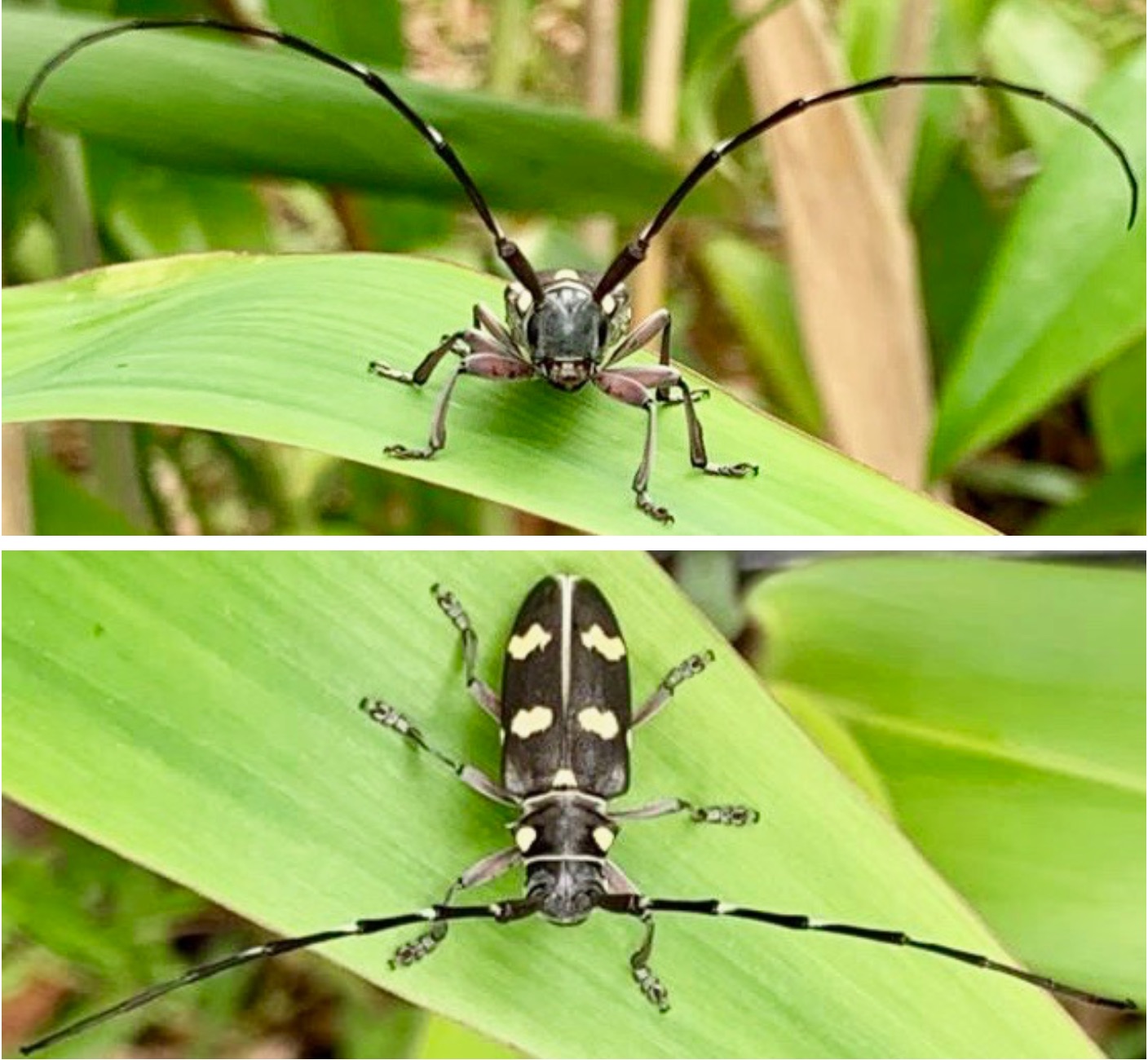


























0 Response to "Small Beetle With Two Yellow Stripes on Back Red Head"
Post a Comment